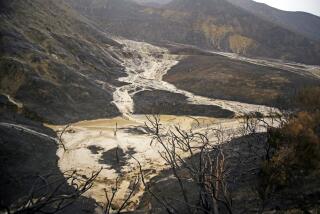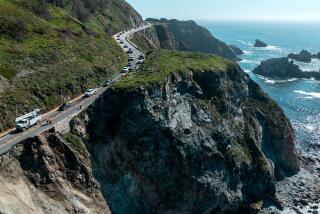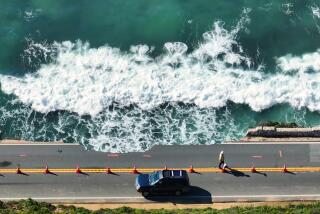El Niño danger: Rain and gravity combine to create sea of mud
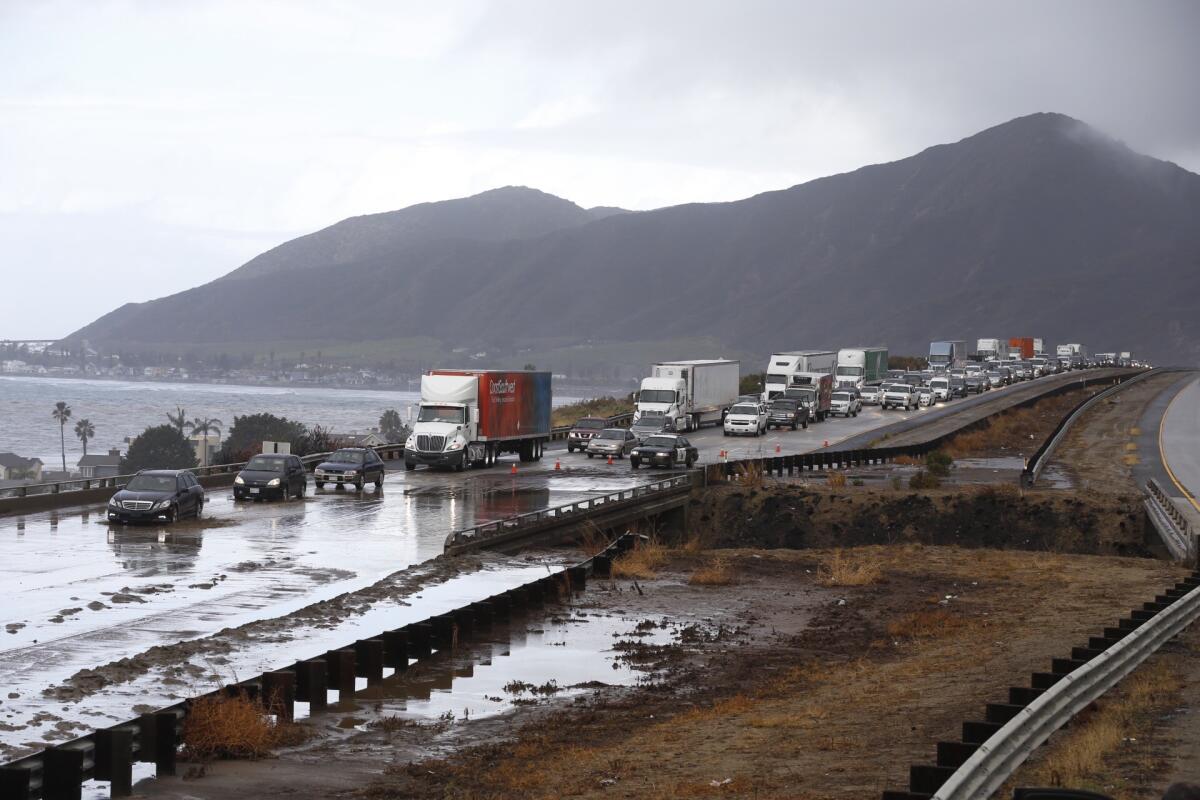
Southbound traffic on the 101 Freeway in Ventura County crawls through one lane Tuesday after mud flowed over the freeway.
As the latest El Niño rainstorm moved into Southern California, there were already signs that the combination of rain and gravity was creating problems.
Mud and debris flowed onto the 101 Freeway in northern Ventura County in an area that was recently burned in a fire, shutting northbound lanes.
Here are some questions and answers about mudslides.
FULL COVERAGE: El Niño in California >>
Why are mudslides and debris flows so common in recently burned areas?
Debris flow has long been a concern in areas where wildfires have recently burned. Vegetation, once burned, can no longer hold back loose sediment.
The burned slopes can also become “water repellent,” said Jason Kean, a U.S. Geological Survey hydrologist whose research focuses on debris flow. Ash tends to clog the soil after fire, and oily substances can affect the ground’s ability to absorb water. Impact from the rain can also help seal the top layer of sediment.
It’s like water on a parking lot or the surface of a playground slide, Kean said: “When the rainfall hits it, it just runs right off .… The rapid runoff from these bare hill slopes can quickly pick up sediment, and that can transform into a really nasty debris flow.”
This graphic shows the danger.
How long does vegetation take to regrow?
Although vegetation grows back in approximately five years after a fire, researchers estimate that it takes up to two decades for a hillside’s soil to be restored to pre-fire conditions.
Why does the drought make things worse?
Now with the drought, an unburned slope may act like a burn area. The dry conditions have caused some vegetation to die off. Officials pointed to major mudslides in northern Los Angeles County in November caused by heavy rains that hit hills where vegetation had died.
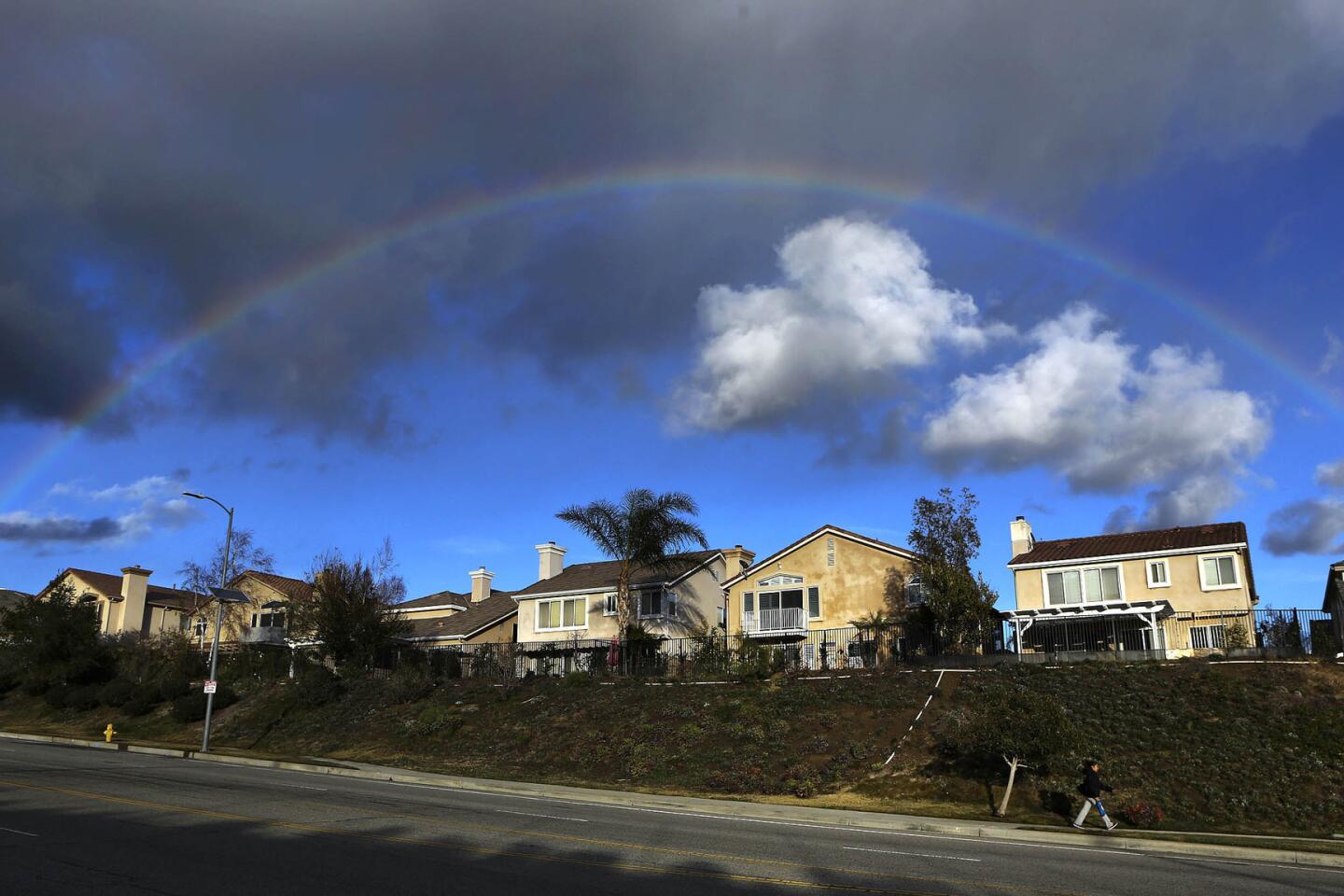
A rainbow forms over homes on Porter Ranch Drive in Porter Ranch on Jan. 7, 2016.
(Mel Melcon / Los Angeles Times)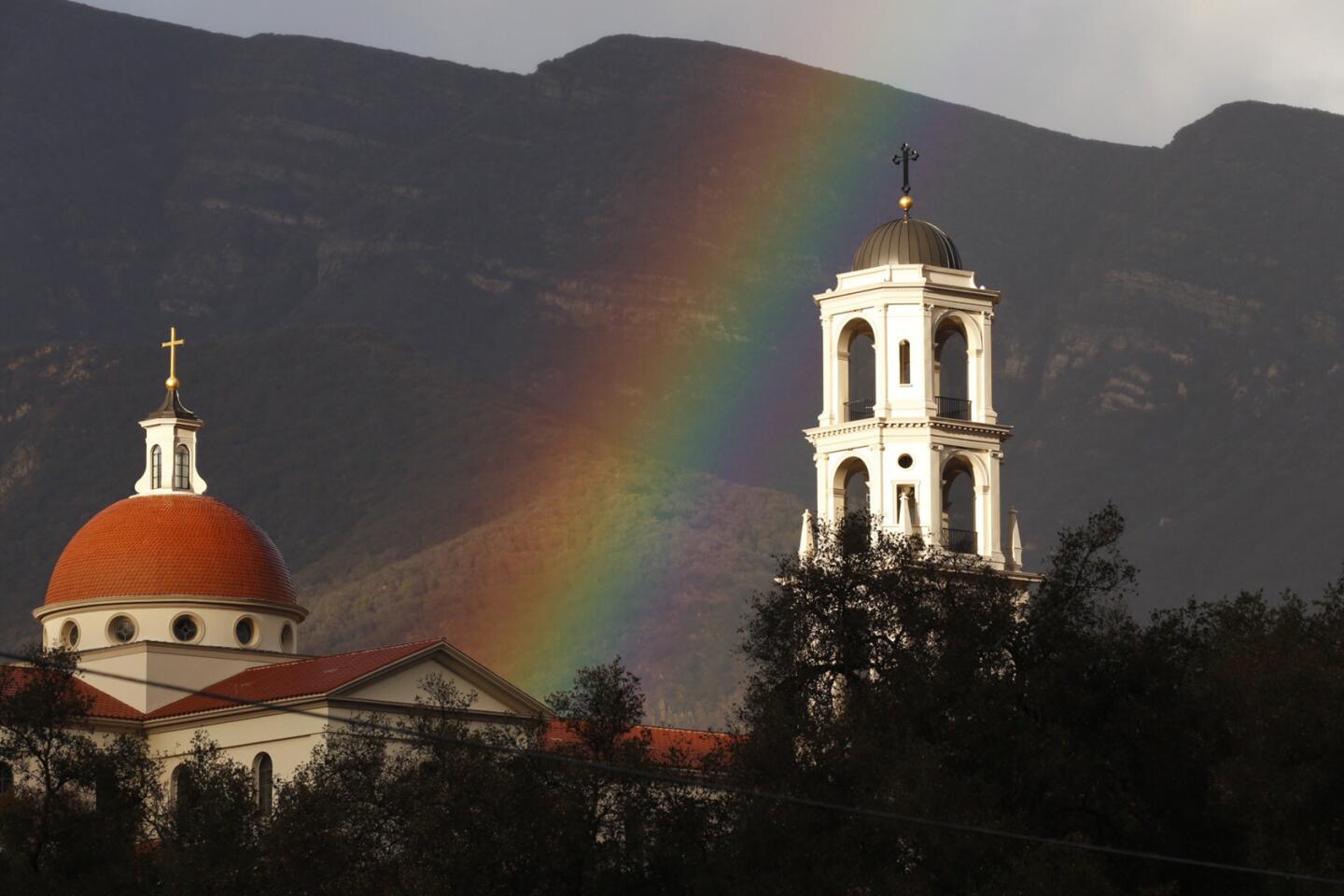
A rainbow fills the sky above the Thomas Aquinas College in the Topatopa Mountains near Santa Paula Thursday afternoon.
(Al Seib / Los Angeles Times)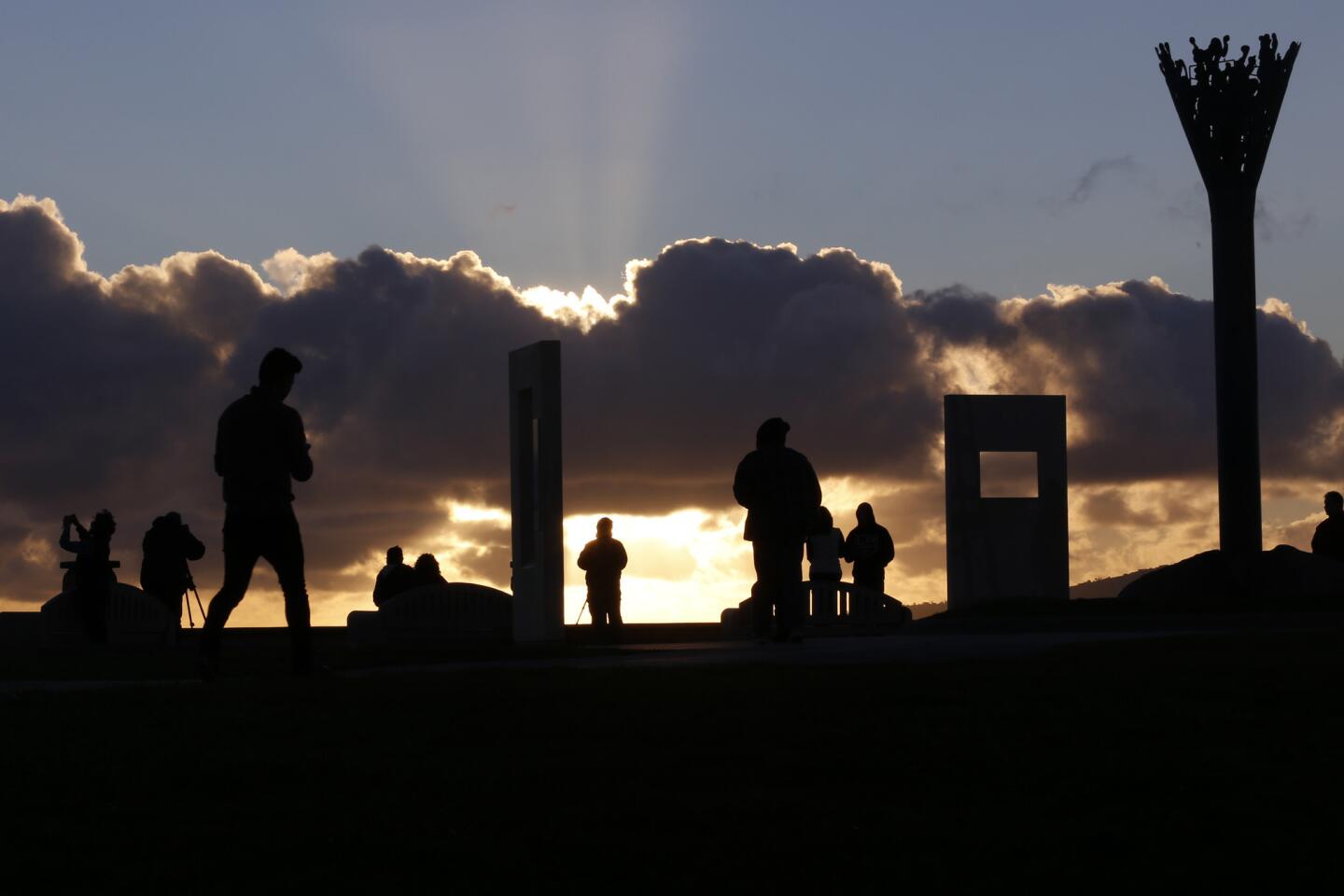
People enjoy the sunset at Hill Top Park in Signal Hill.
(Glenn Koenig / Los Angeles Times )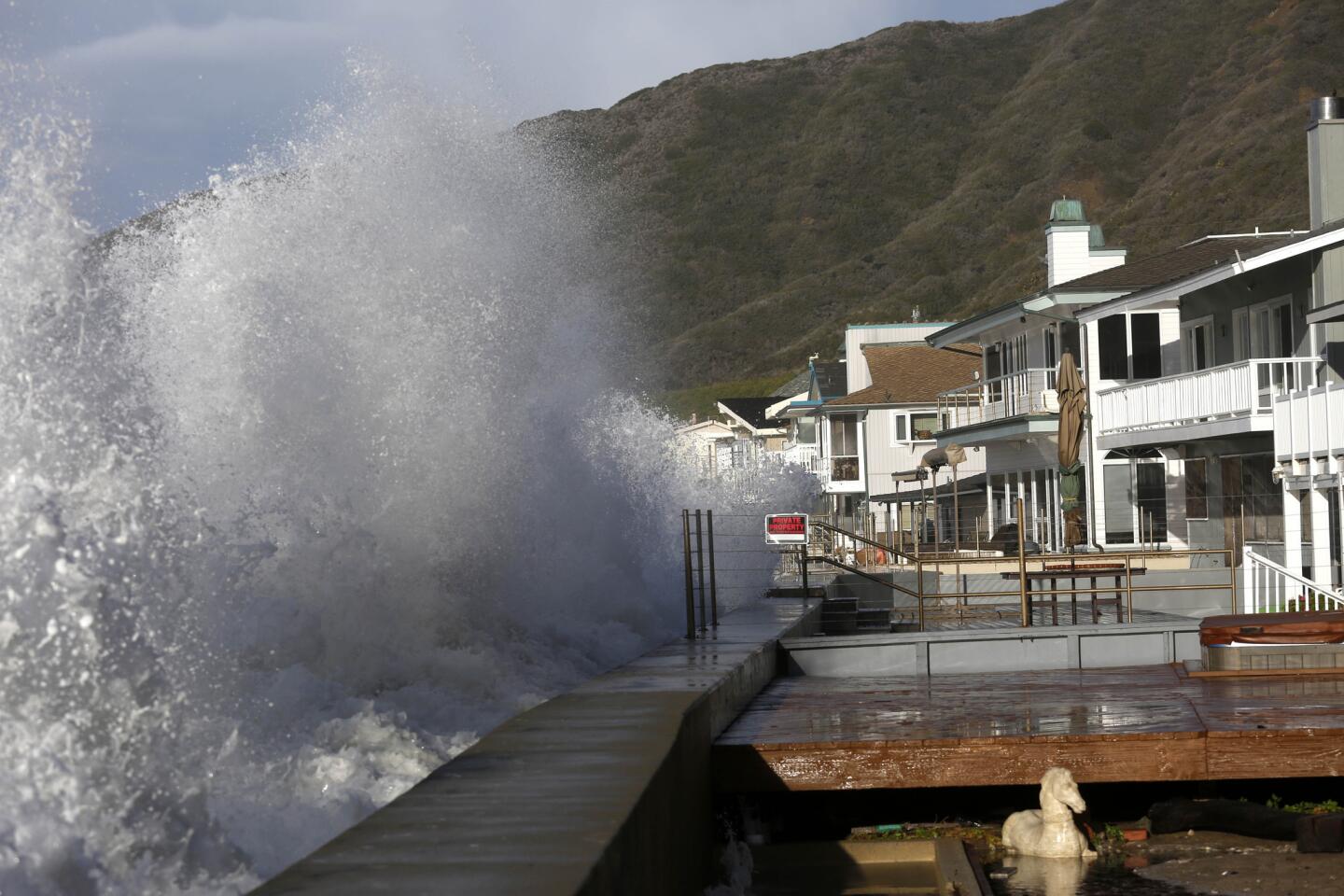
A big northwest swell combined with a high tide on Thursday morning along the southern California coast resulting in seaside communities being battered. Faria Beach in Ventura County was one of the areas especially hard hit.
(Michael Robinson Chávez / Los Angeles Times)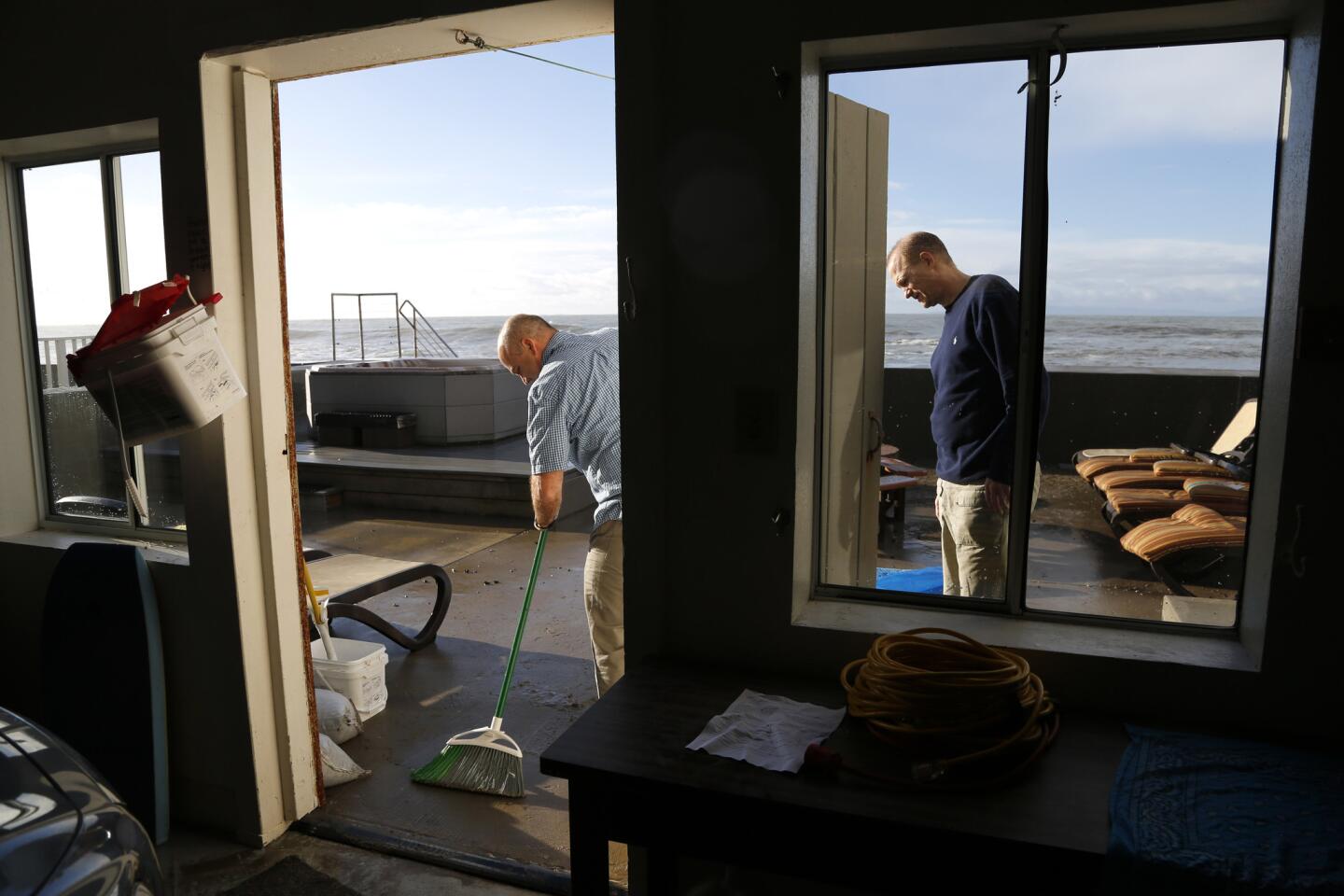
Carlos Pereira, left, tries to clean up an oceanfront deck that was pummeled through the night by big waves.
(Michael Robinson Chavez / Los Angeles Times)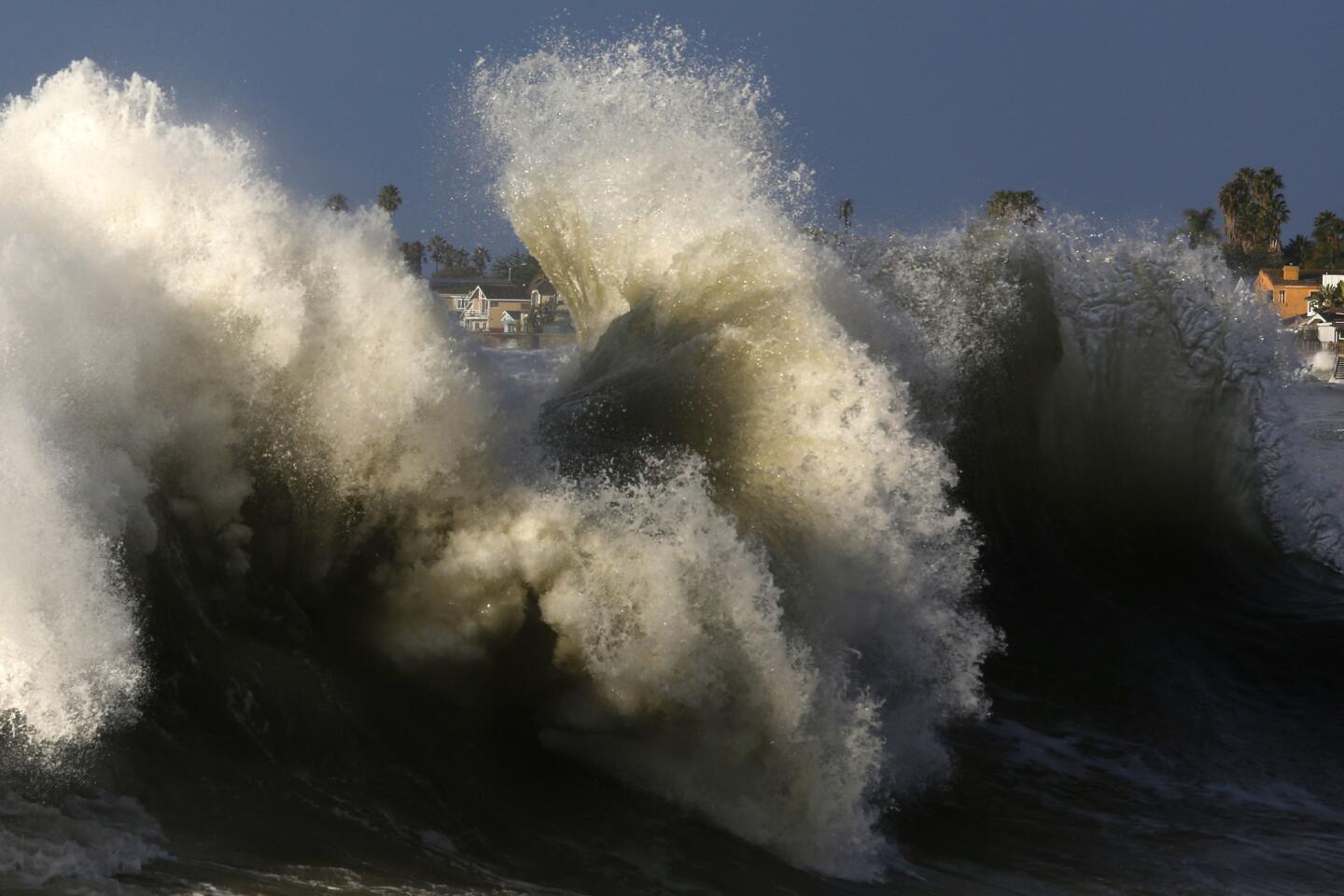
A big northwest swell combined with a high tide on Thursday morning along the southern California coast resulting in seaside communities being battered. Faria Beach in Ventura County was one of the areas especially hard hit.
(Michael Robinson Chávez / Los Angeles Times)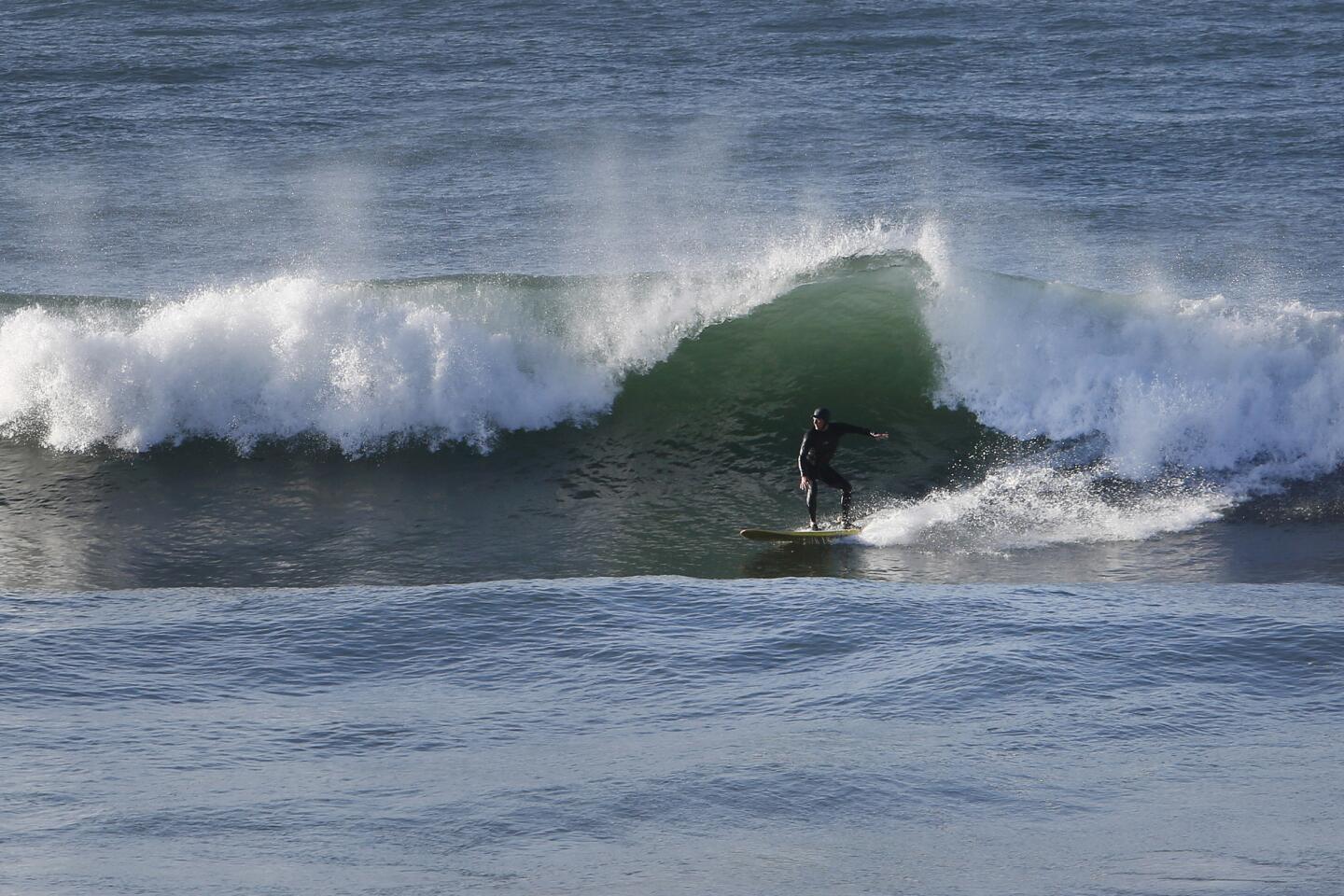
A surfer catches a wave at Sunset Beach in the Pacific Palisades.
(Katie Falkenberg / Los Angeles Times)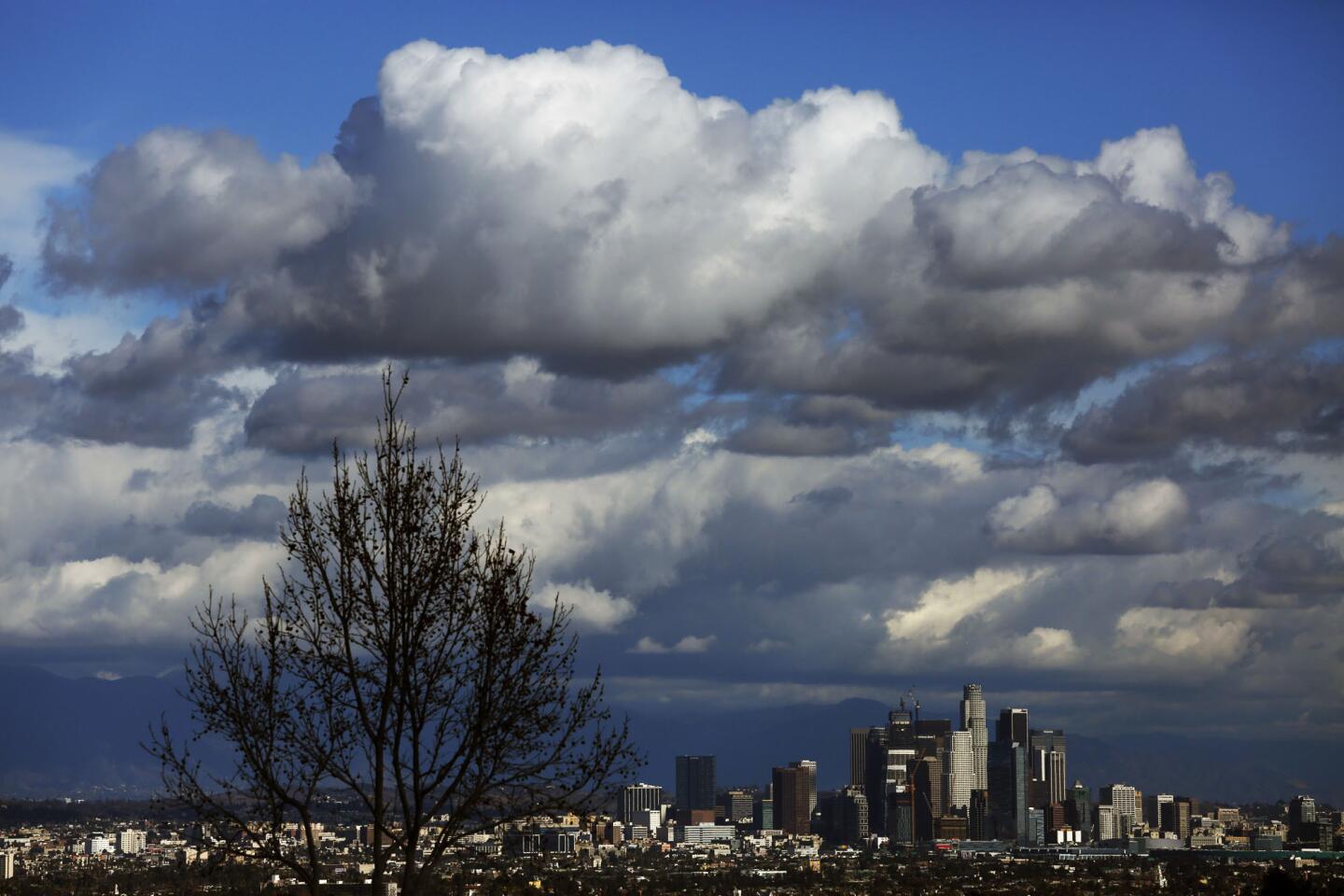
A passing storm, as seen from the Kenneth Hahn State Recreation Area, makes its way over Los Angeles on Thursday.
(Genaro Molina / Los Angeles Times)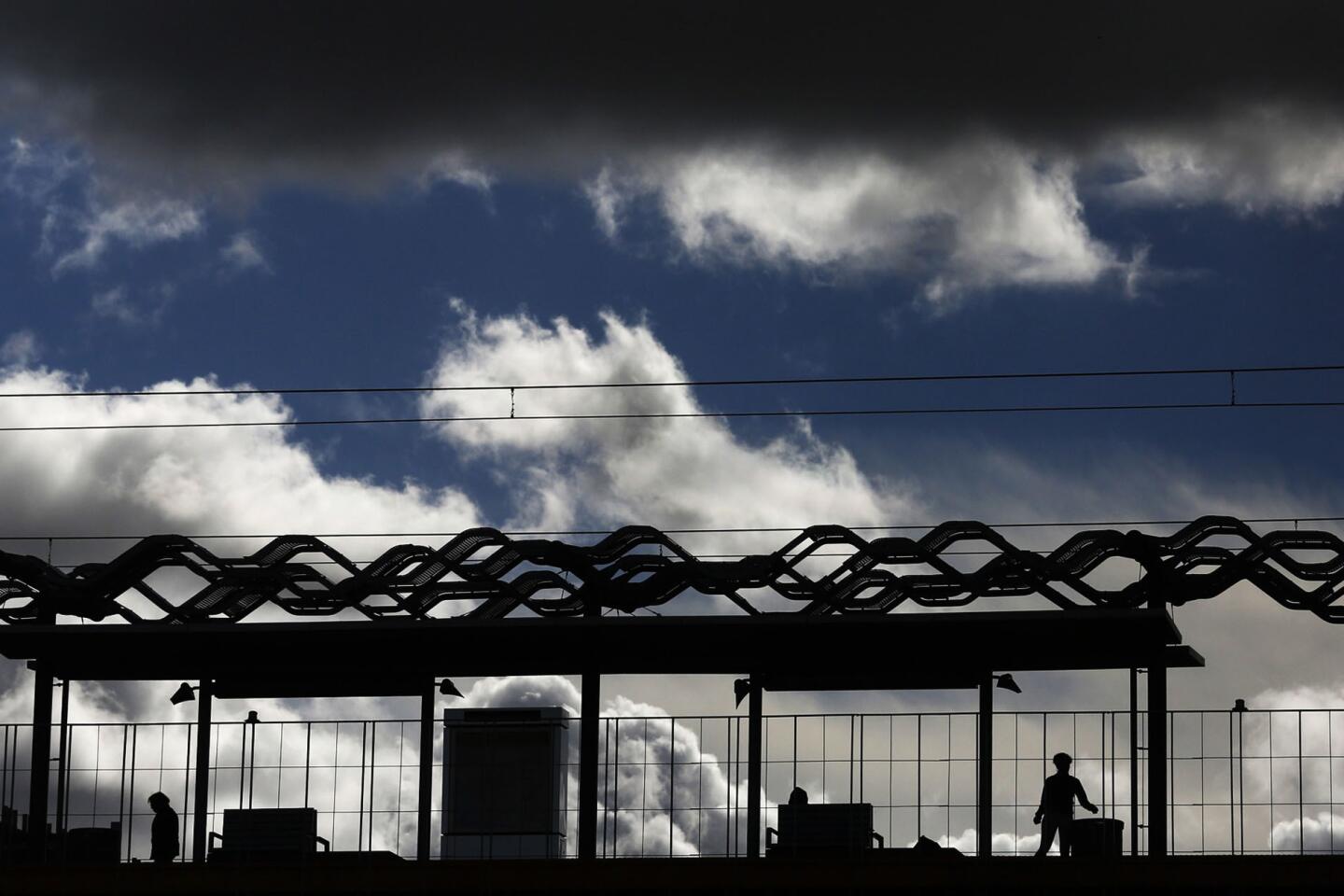
A passing storm provides the backdrop for passengers waiting for a train at the La Cienega/Jefferson station on the Metro Expo Line in Culver City on Thursday.
(Genaro Molina / Los Angeles Times)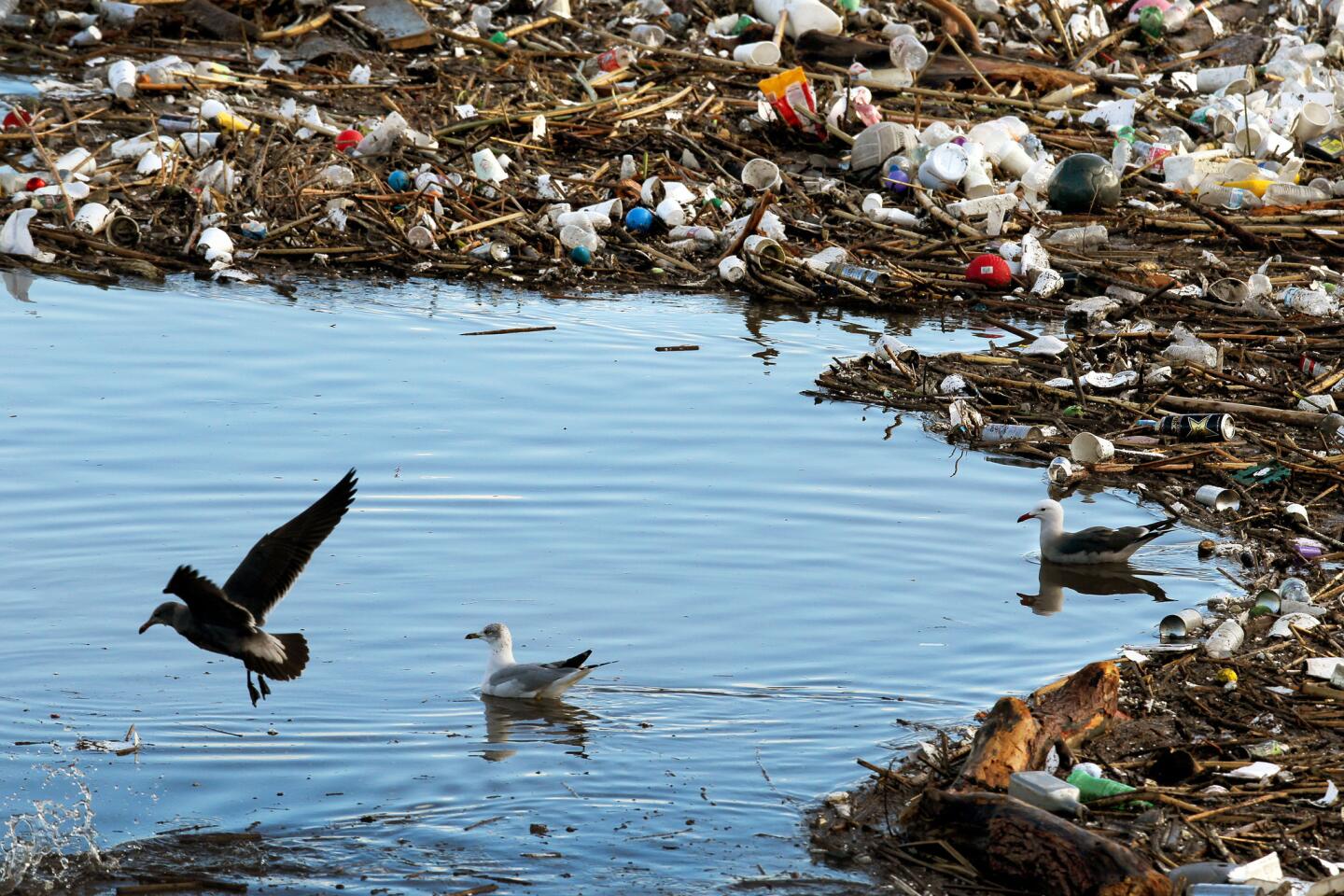
Birds flock to trash near the mouth of the Los Angeles River, a site where tons of trash and debris have piled up after two days of heavy rain from El Niño-generated storms.
(Rick Loomis / Los Angeles Times)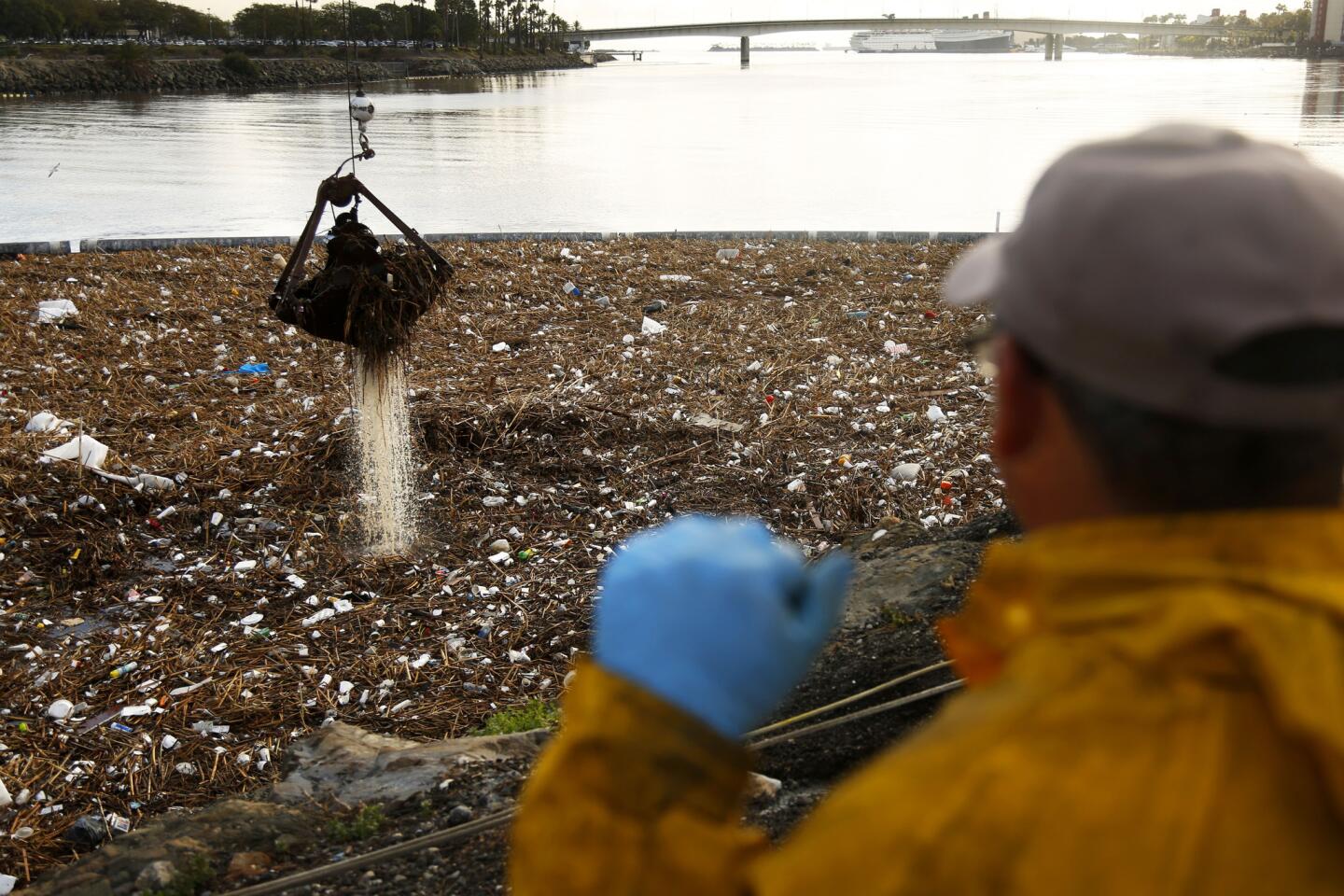
Bitelio Ramirez looks out Thursday over trash that has piled up near the mouth of the Los Angeles River after two days of heavy rain. A worker on the scene said two cranes were being used to lift out about 300 tons of trash.
(Rick Loomis / Los Angeles Times)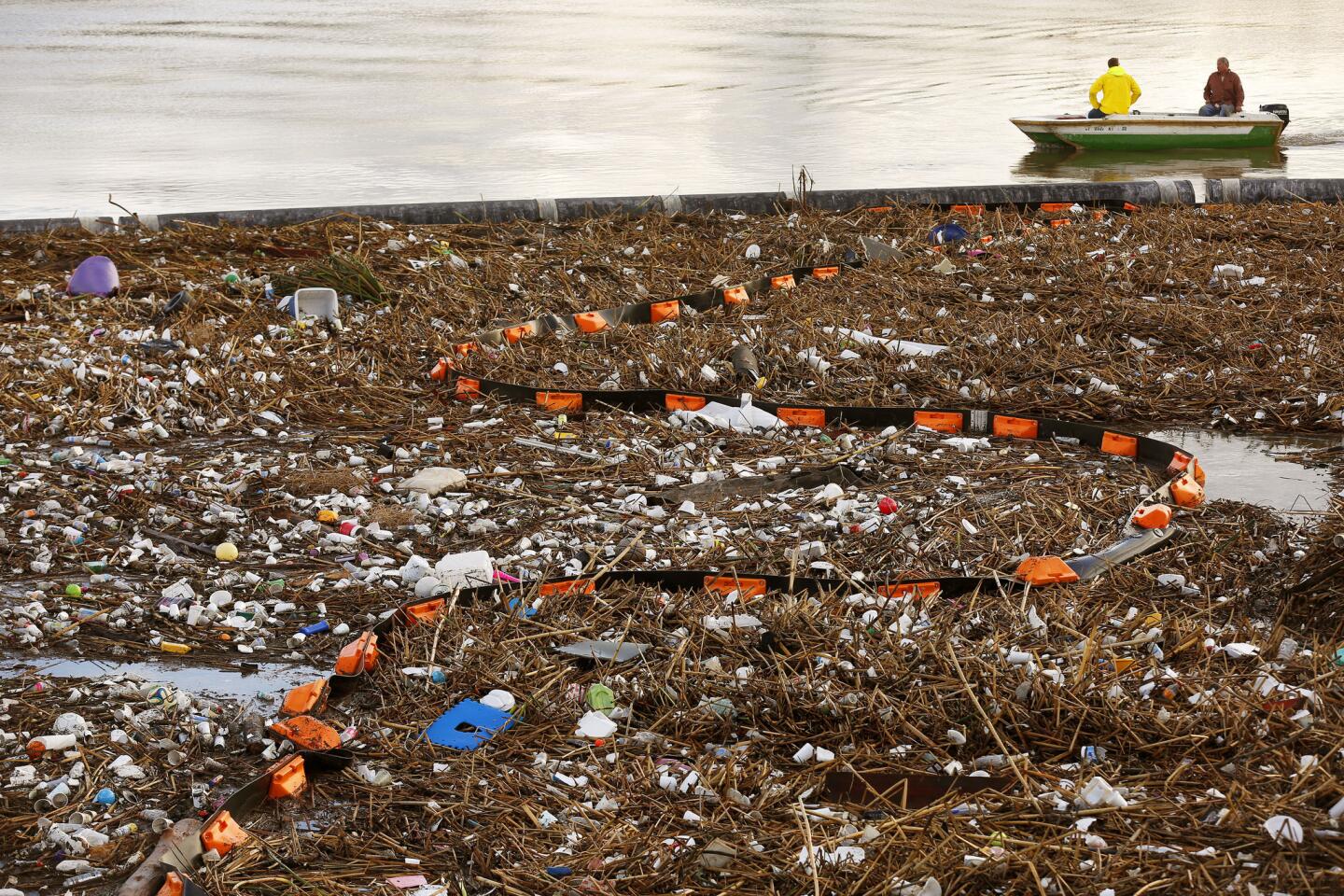
Trash floats up against a boom near the mouth of the Los Angles River on Thursday after two days of heavy rain.
(Rick Loomis / Los Angeles Times)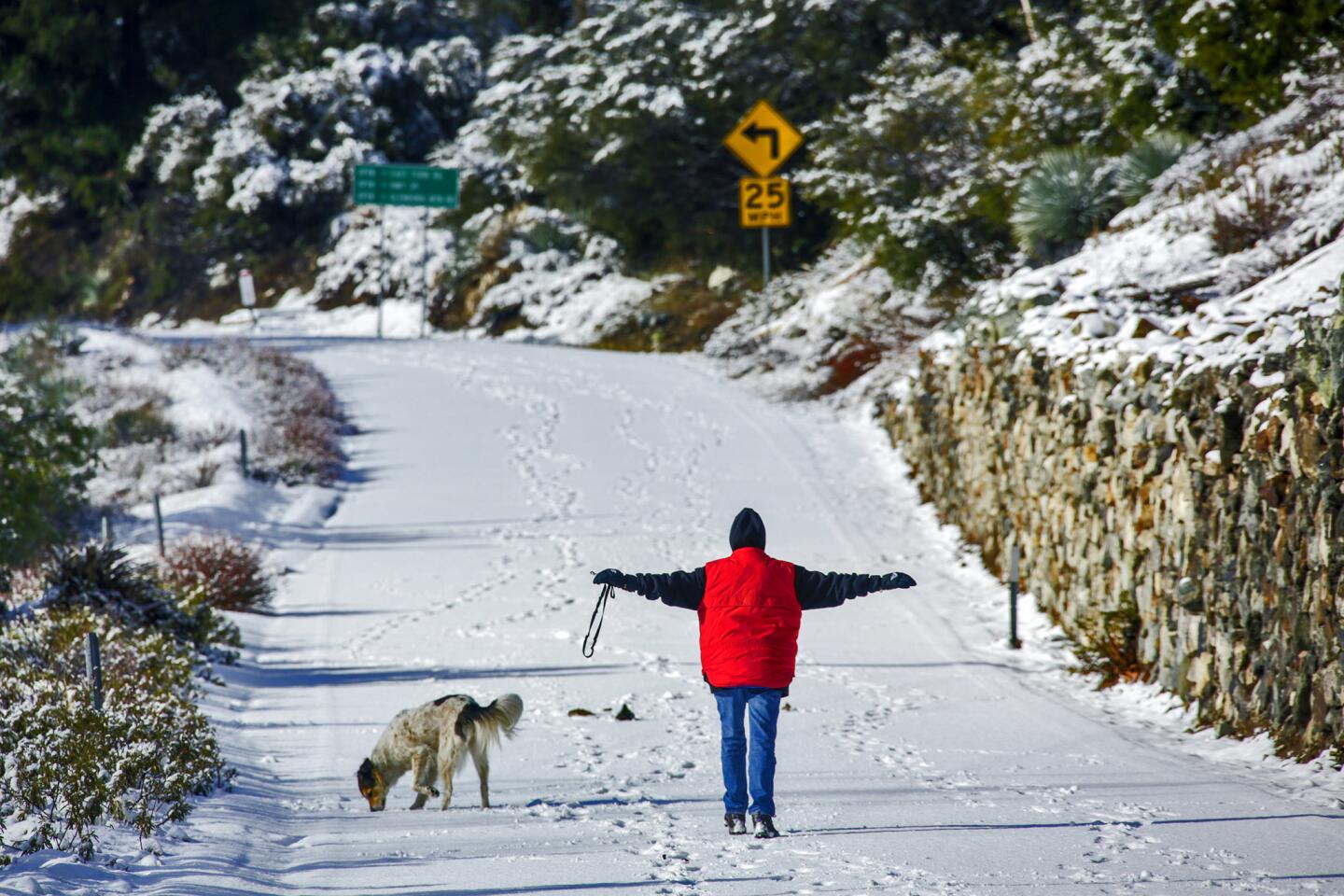
A woman with her dog goes for a morning walk on snow covered and closed to traffic Glendora Ridge Road in Mt. Baldy.
(Irfan Khan / Los Angeles Times)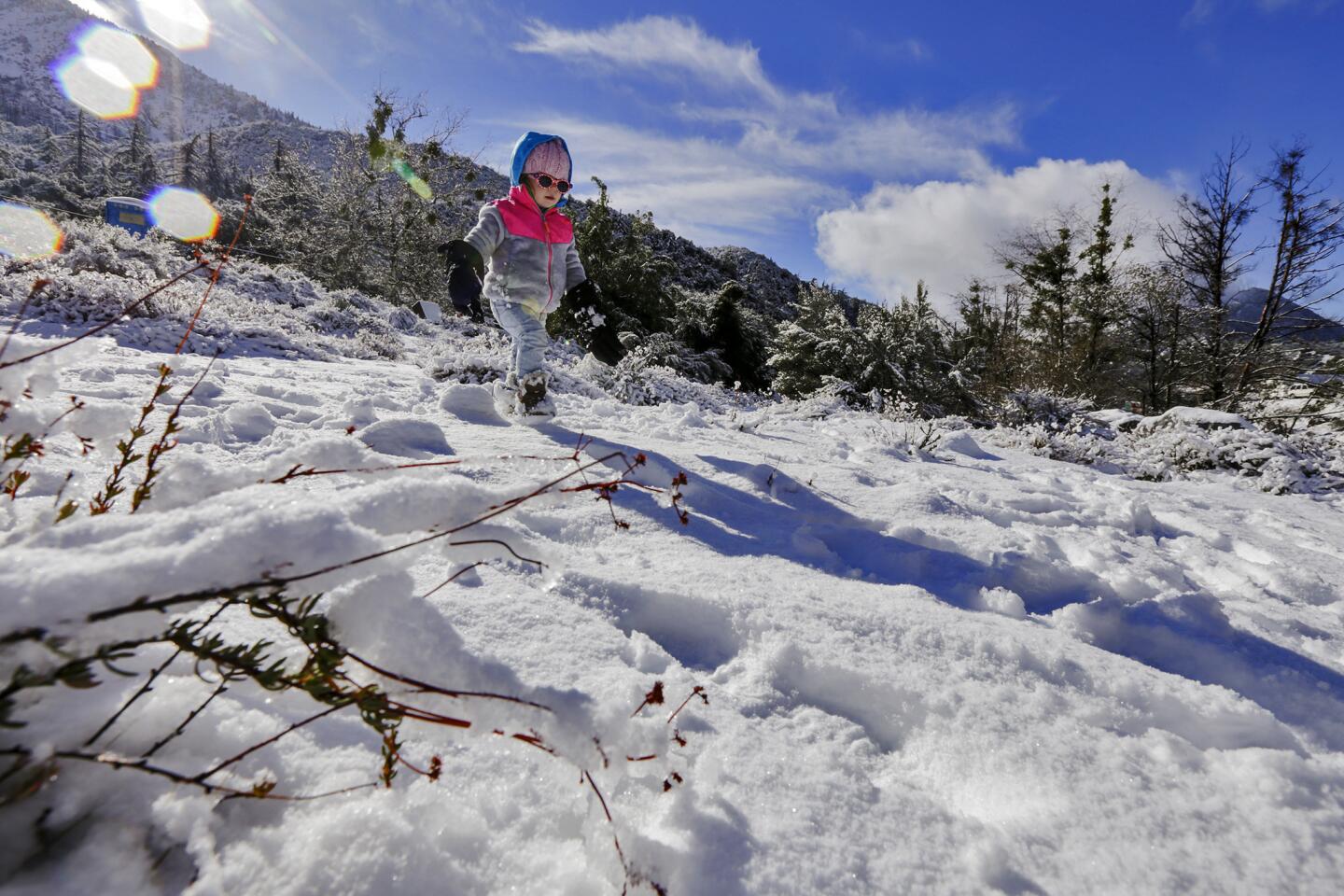
Leah Weischedel, 2, walks on freshly fallen snow on Thursday morning in Mt. Baldy.
(Irfan Khan / Los Angeles Times)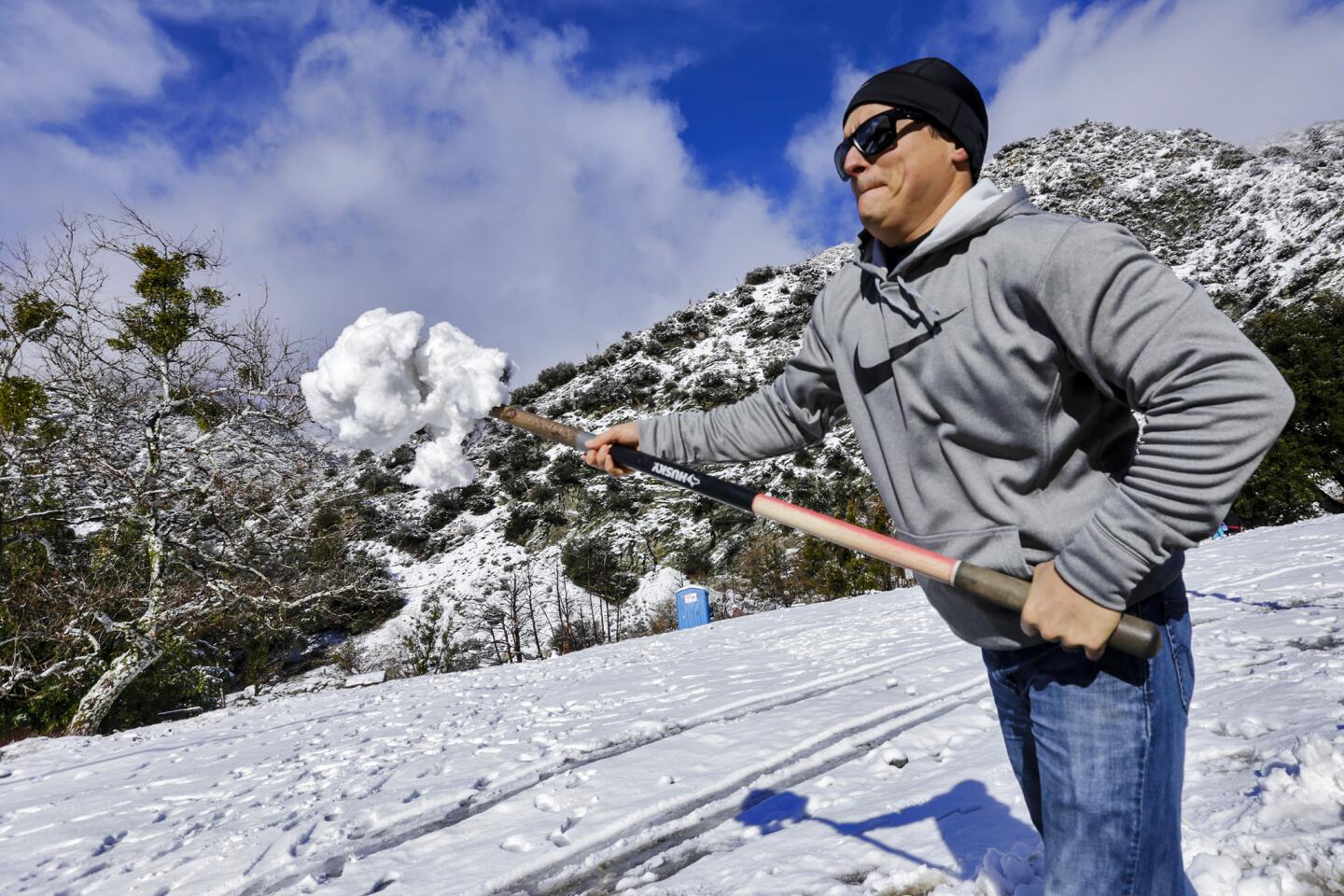
Mike Weischedel throws a shovel full of snow into his truck to take home to Upland Thursday morning in Mt. Baldy.
(Irfan Khan / Los Angeles Times)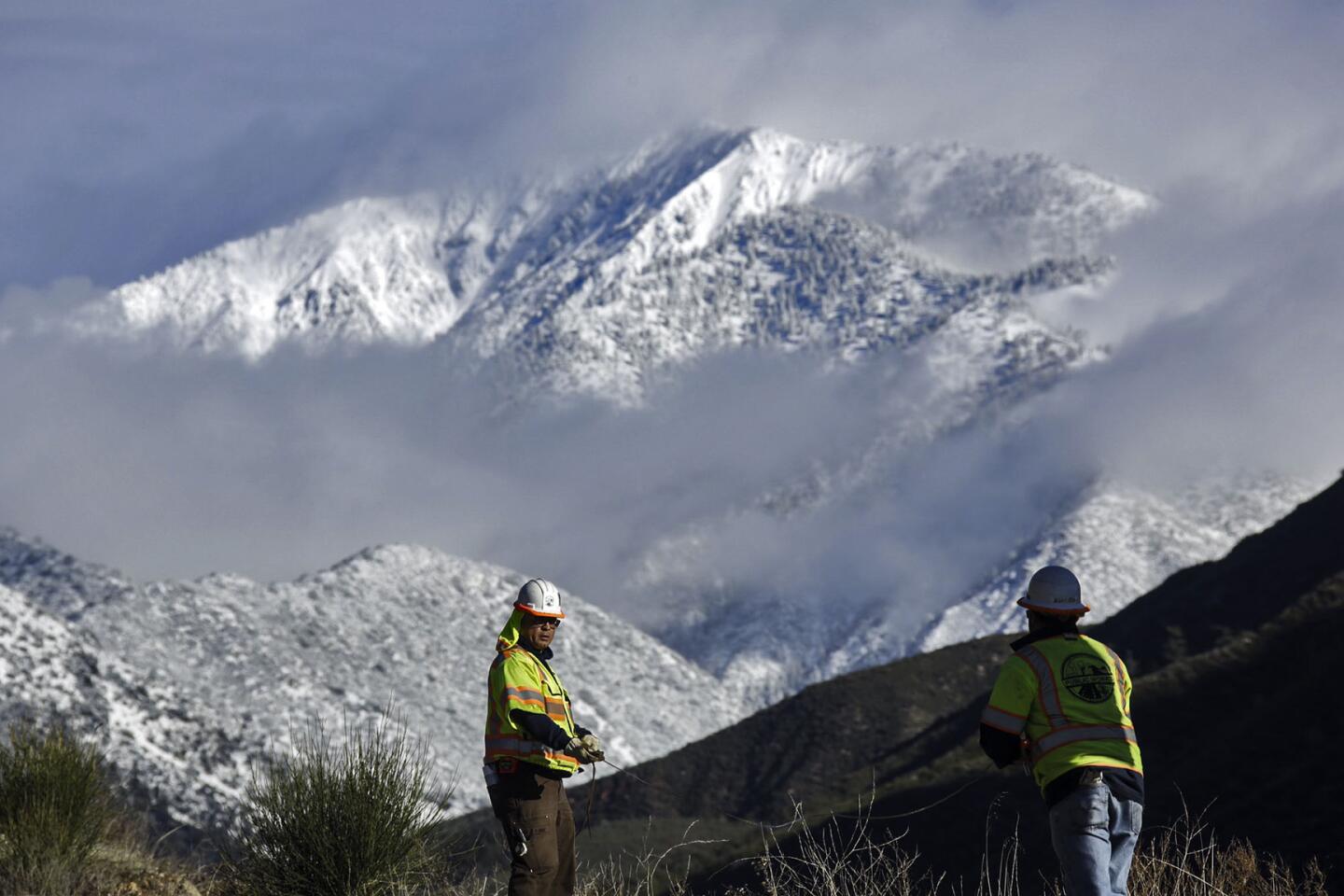
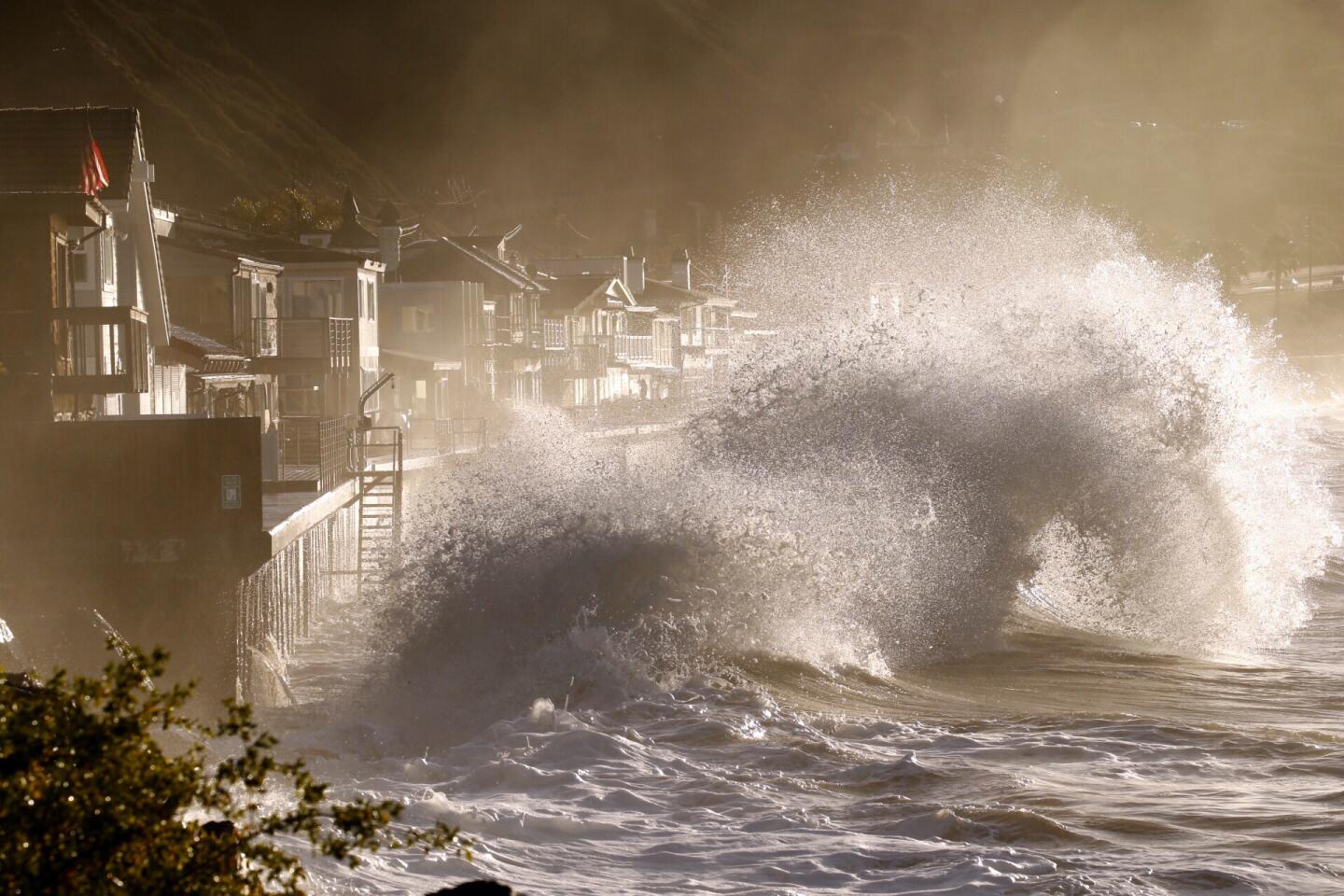
Forceful and beautiful waves crash into the sea walls of homes at Mondo’s Beach under the mountains of the recent Solimar fire at high tide sunrise west of Ventura Thursday morning.
(Al Seib / Los Angeles Times)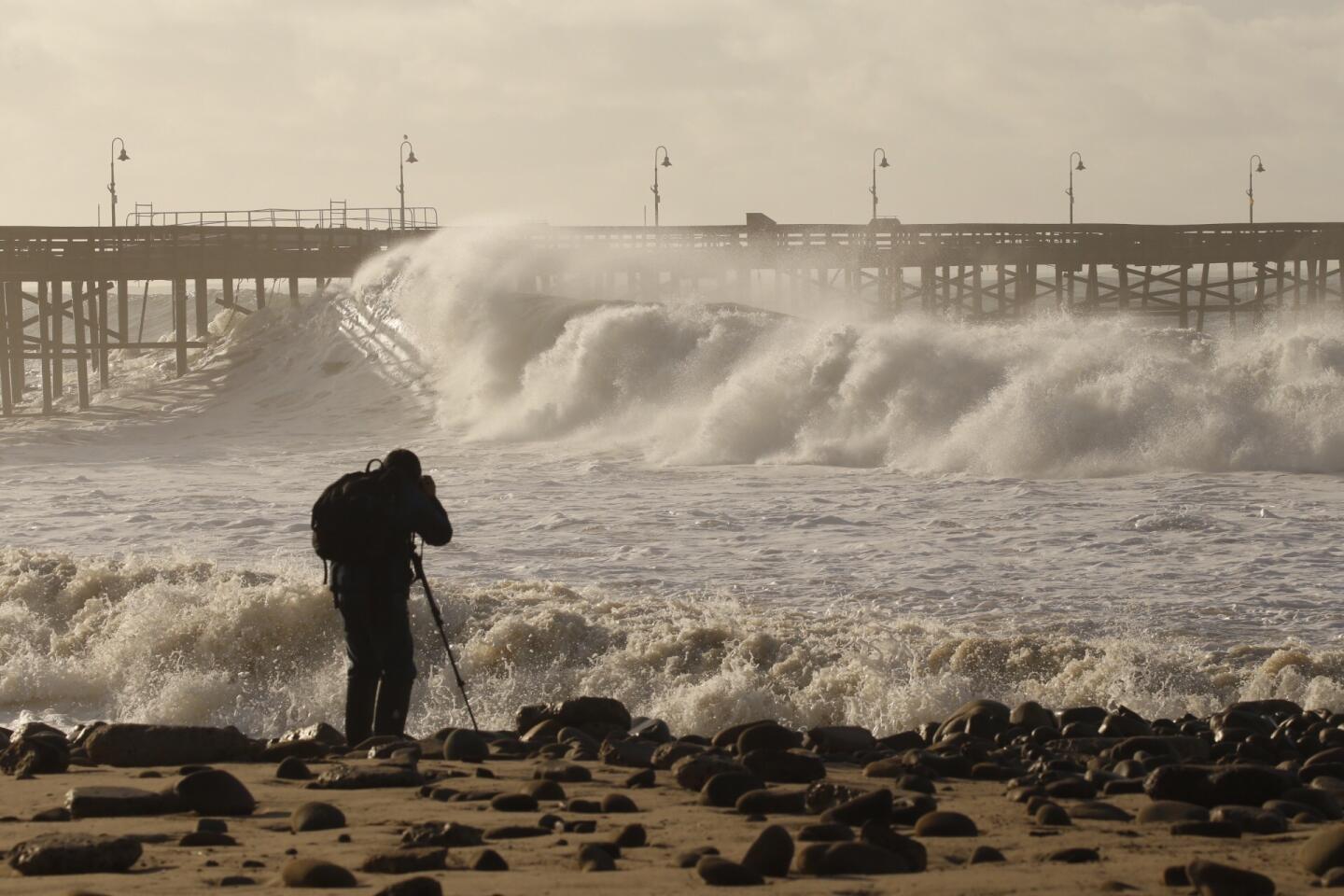
Photographer Dan Dolinh takes photos as the Ventura Pier is pounded by heavy surf Thursday morning.
(Al Seib / Los Angeles Times)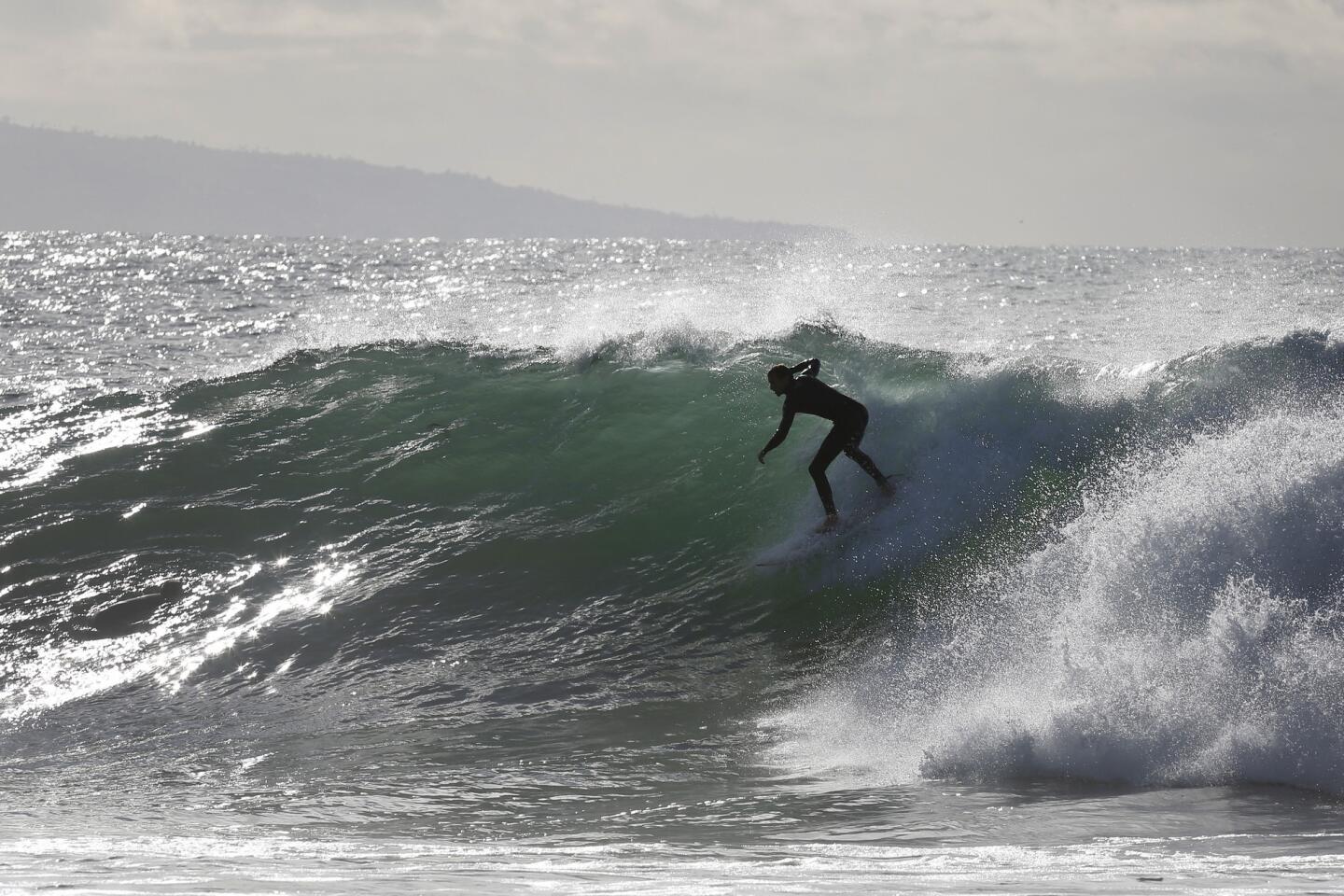
A surfer catches a wave at Topanga State Beach as El Nino storms brought high surf to area beaches.
(Katie Falkenberg / Los Angeles Times)
A body boarder is tossed from his board in heavy surf off the Seal Beach Pier Thursday morning.
(Allen J. Schaben / Los Angeles Times)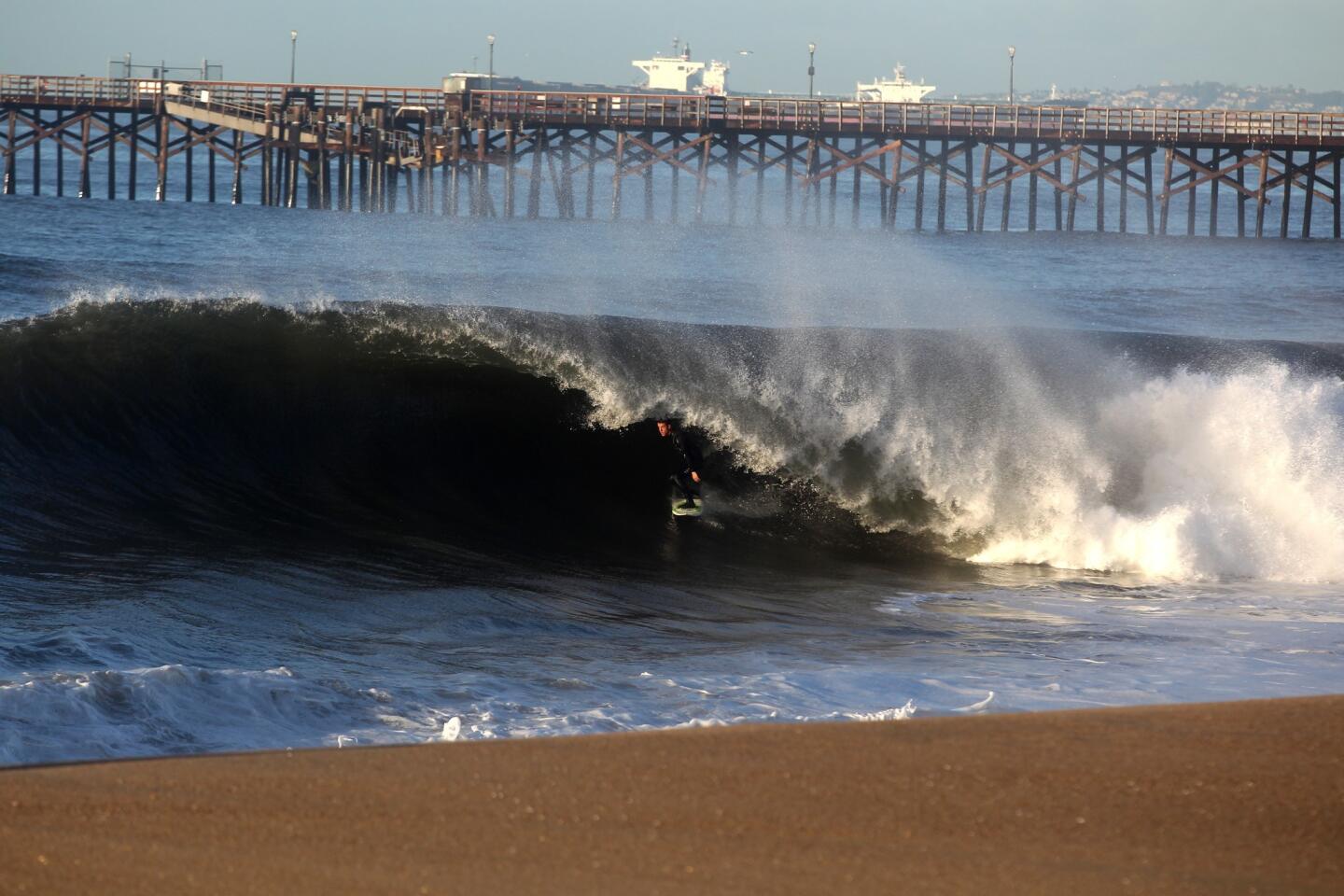
A surfer gets a tube ride off the Seal Beach Pier Thursday morning.
(Allen J. Schaben / Los Angeles Times)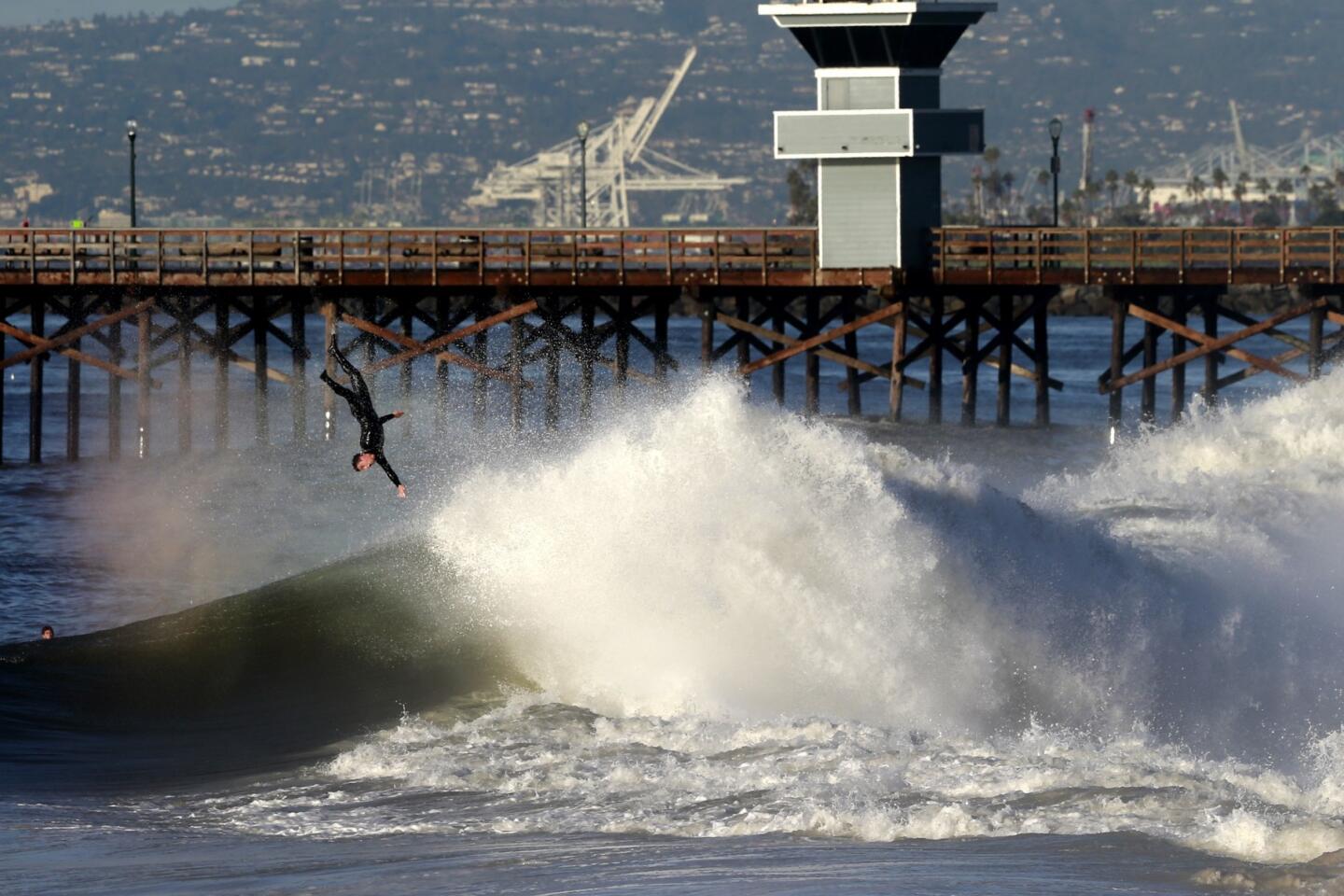
A surfer is tossed from his board in heavy surf off the Seal Beach Pier Thursday morning.
(Allen J. Schaben / Los Angeles Times)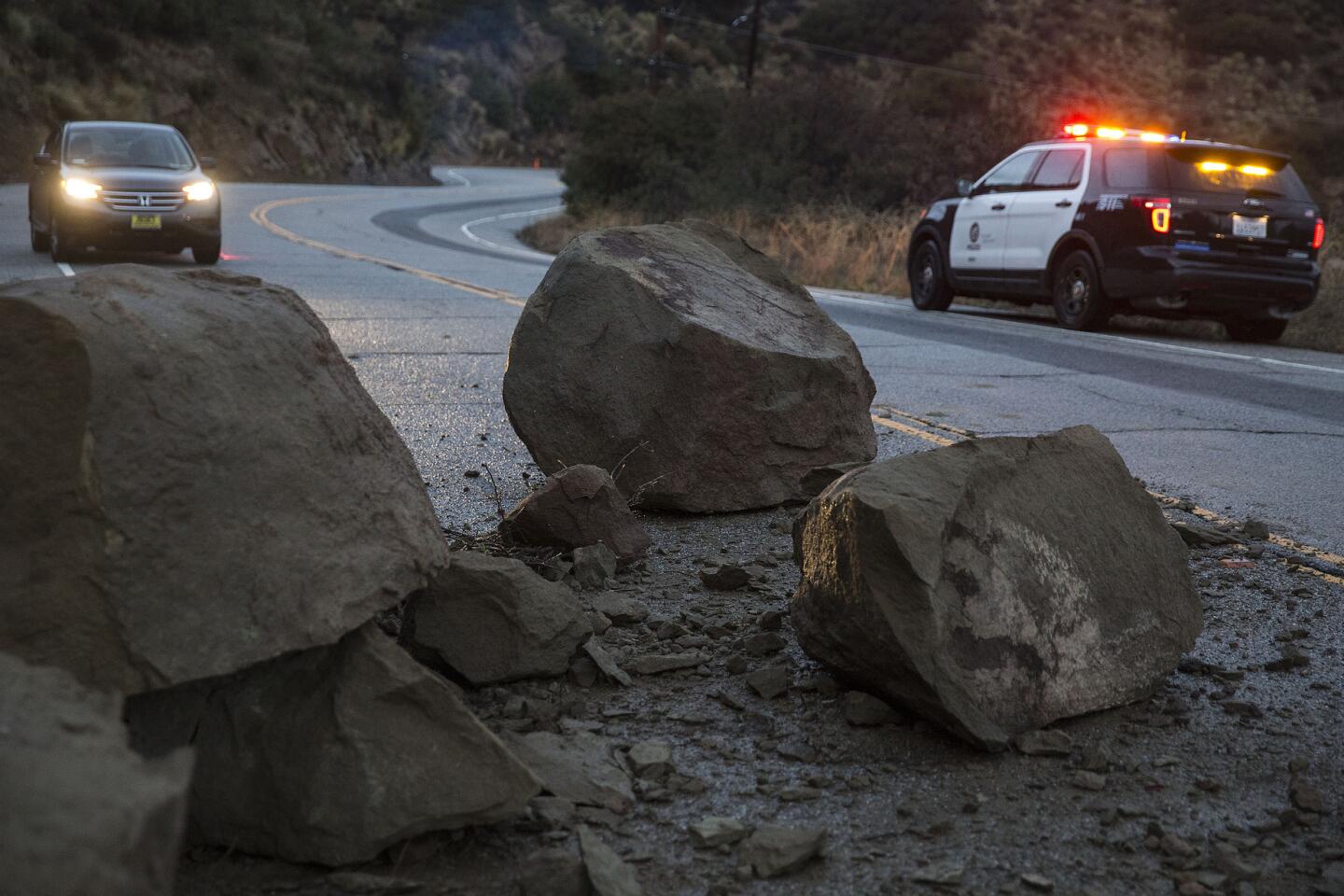
Large boulders block Santa Susanna Pass Rd. two miles west of Topanga Canyon after a rain-soaked hillside slid onto the roadway in Chatsworth.
(Brian van der Brug / Los Angeles Times)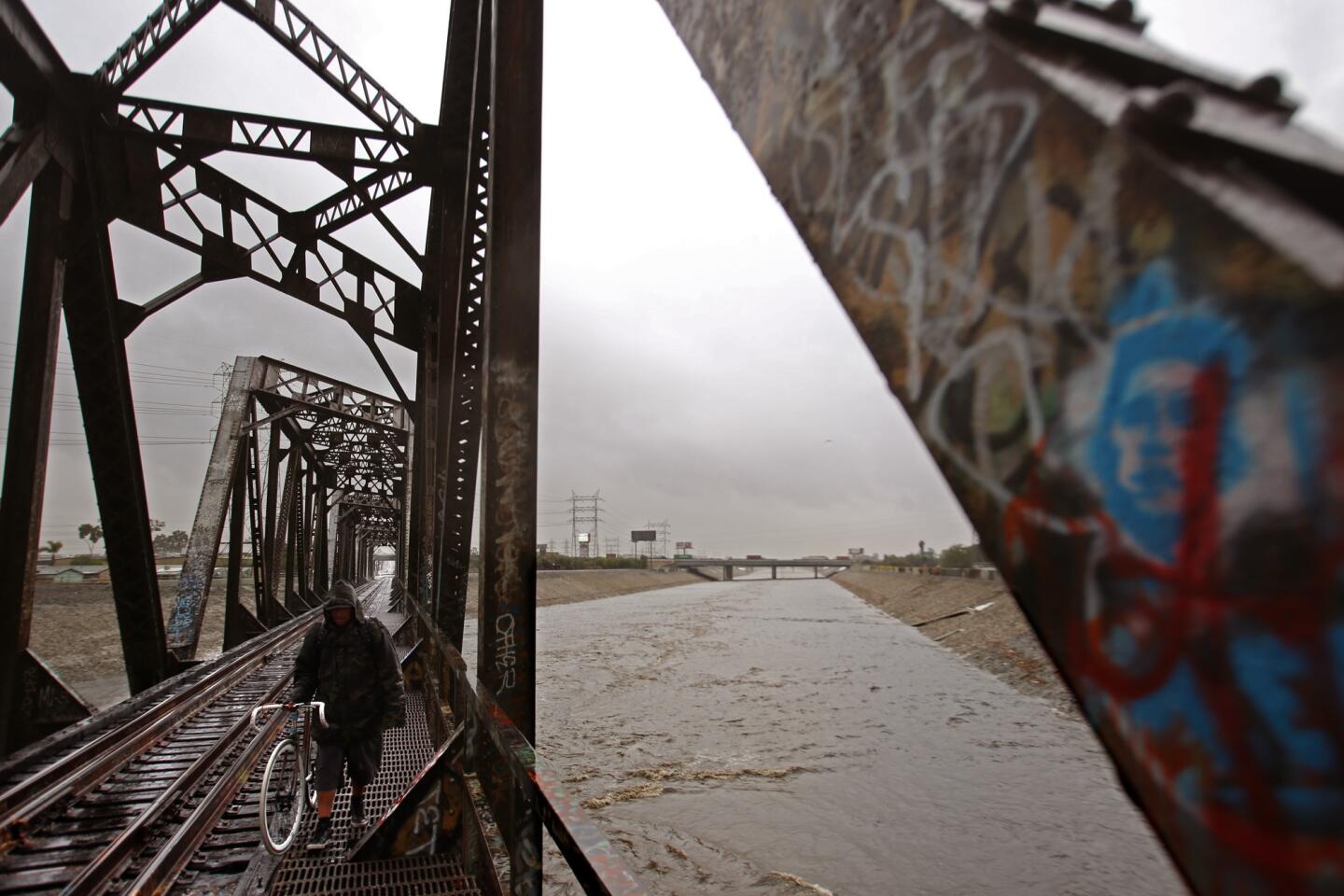
A man walks along an old Union Pacific Bridge as the Los Angeles River flows in South Gate.
(Genaro Molina / Los Angeles Times)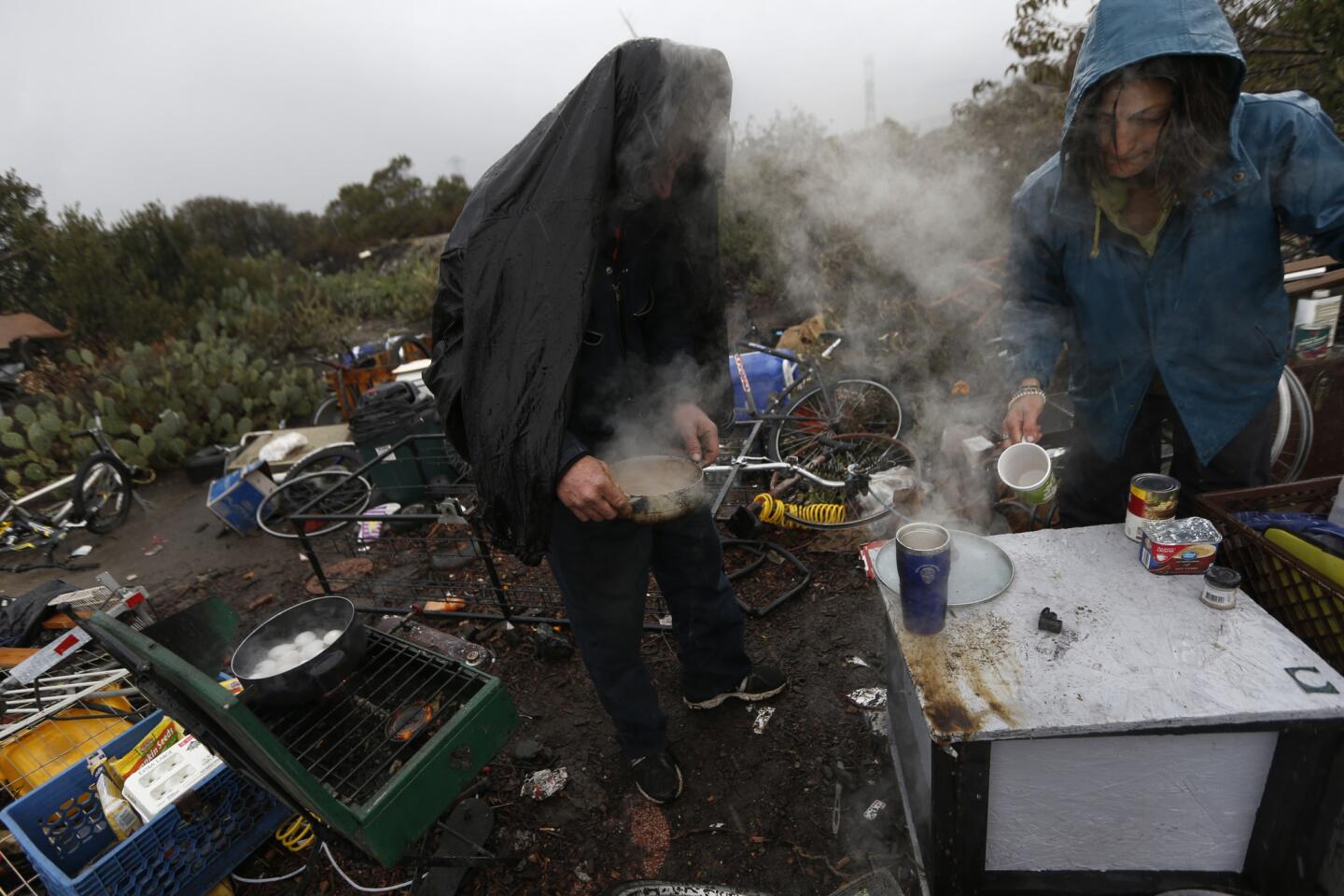
Heavy rain pours on Wayne Bearden and Laura Marin as they try to stay warm with a pot of coffee at their San Gabriel River adjacent encampment during the second major El Nino storm.
(Robert Gauthier / Los Angeles Times)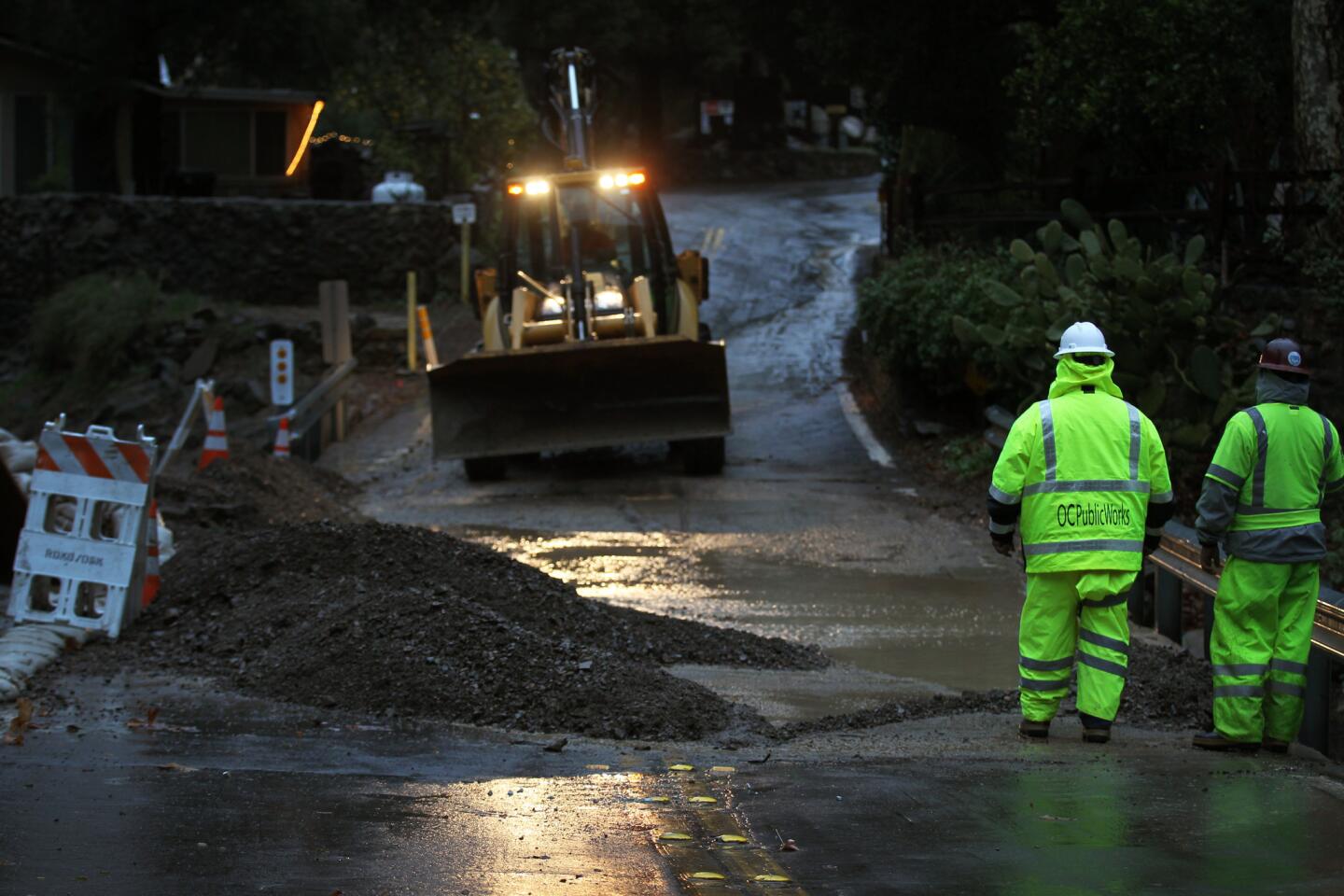
Debris gathers along Silverado Canyon Road in Orange County after another El Niño storm brought heavy rains to the area Wednesday.
(Rick Loomis / Los Angeles Times)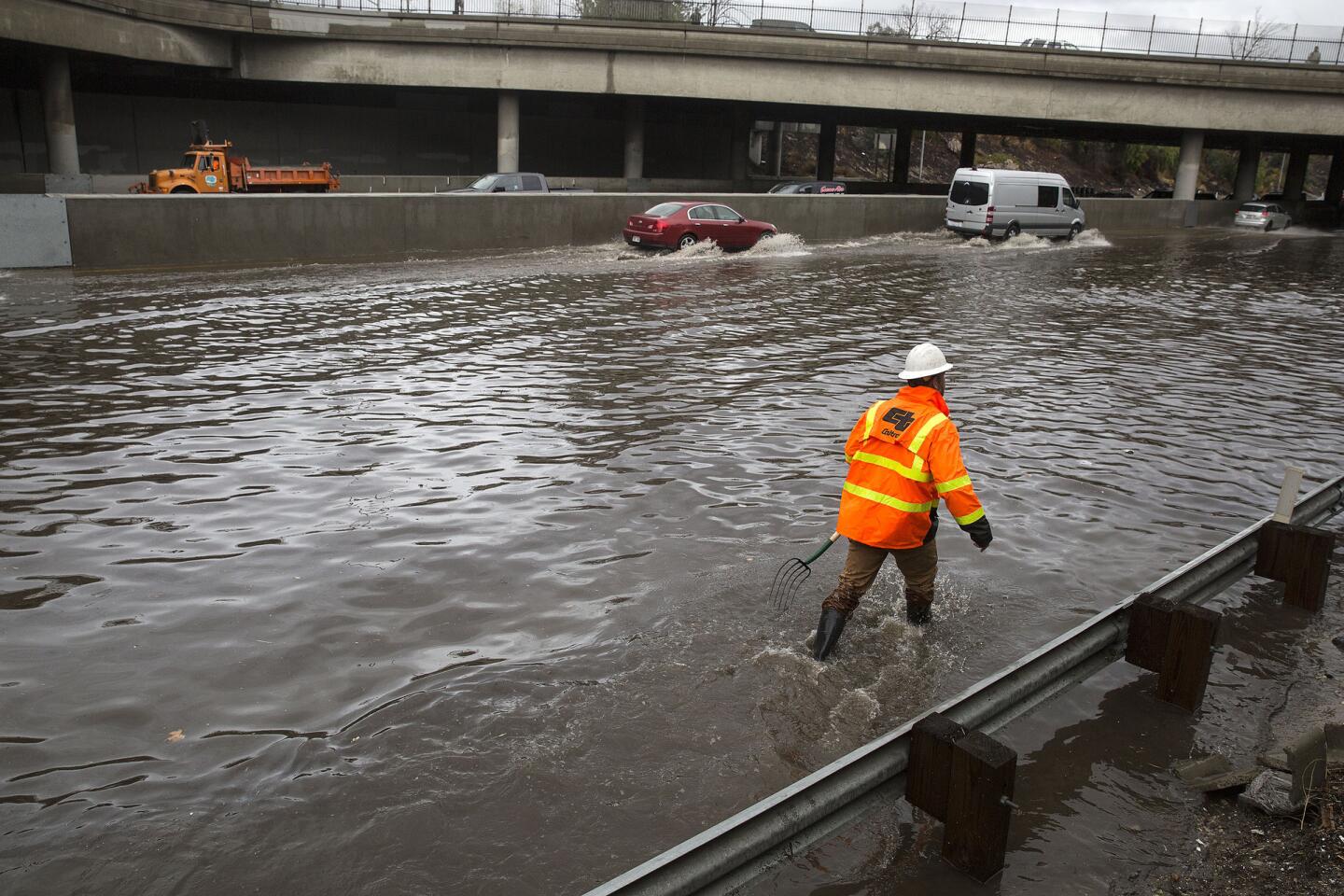
A Caltrans worker toils to clear drains on a flooded Interstate 5 in Sun Valley, Calif.
(Brian van der Brug / Los Angeles Times)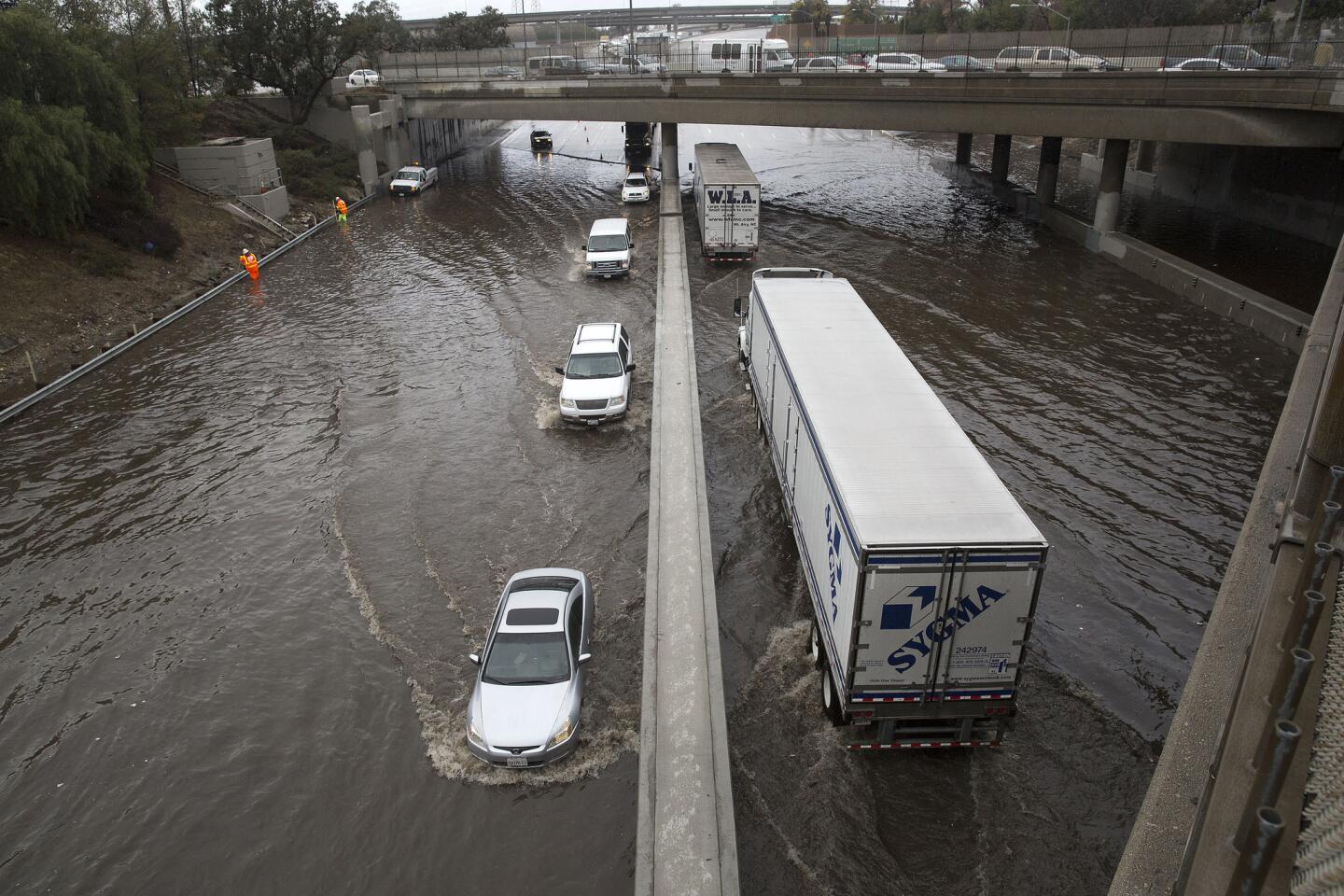
CHP officers limit traffic on a flooded Interstate 5 to one lane in each direction as Caltrans workers work to clear drains in Sun Valley, Calif.
(Brian van der Brug / Los Angeles Times)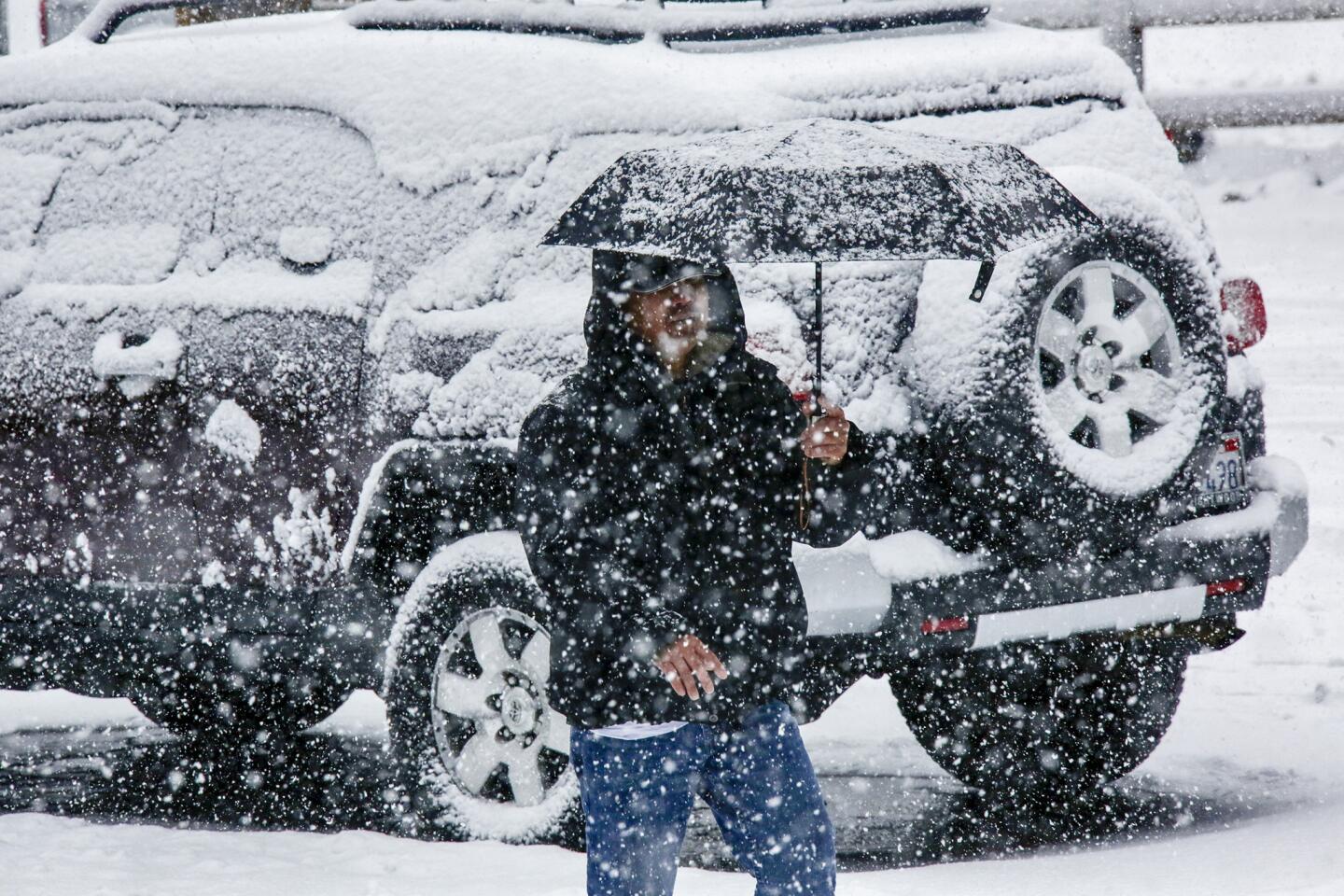
Heavy snow fall in Wrightwood.
(Irfan Khan / Los Angeles Times)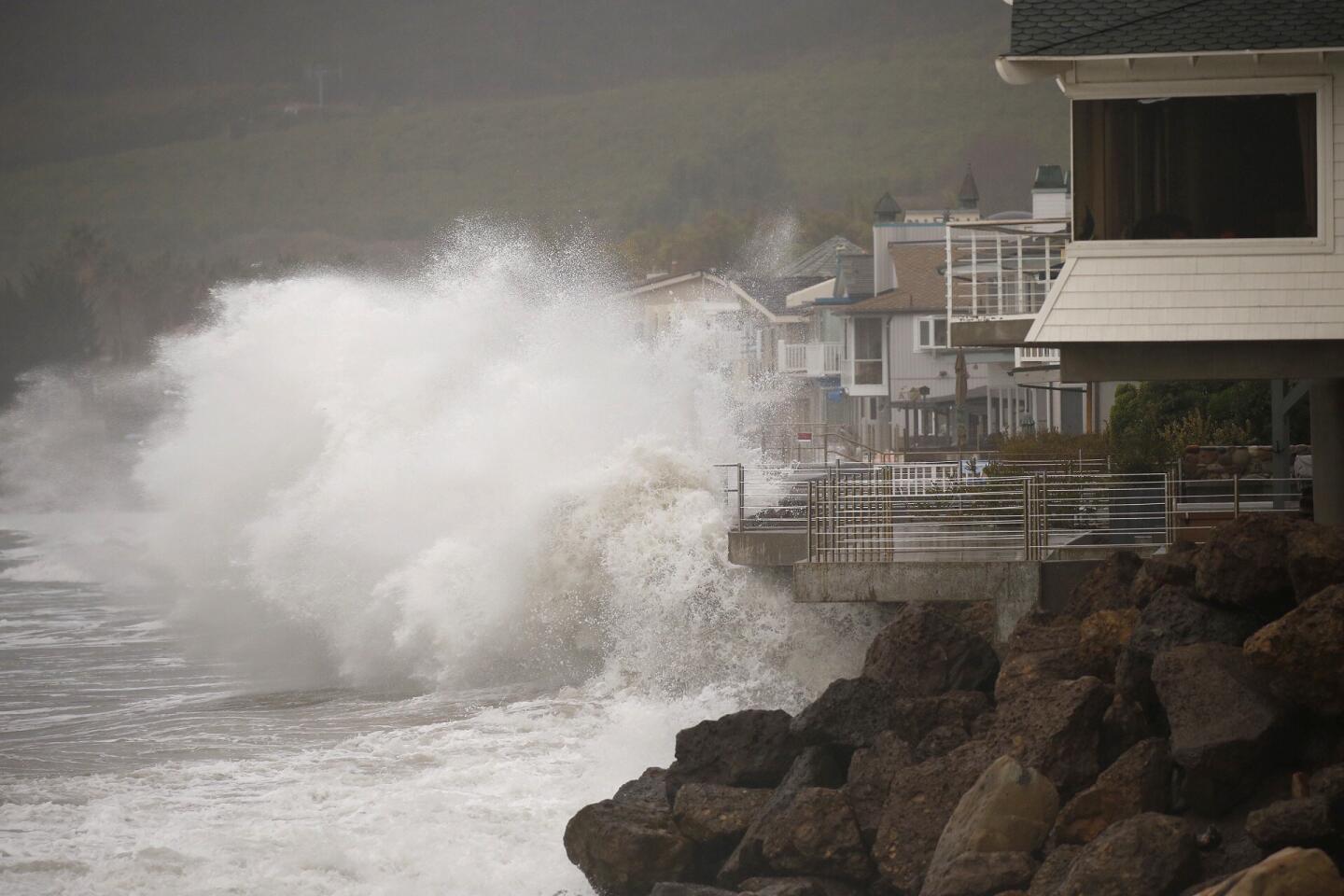
Homes at Mondo’s Beach between the Solimar and Faria Beach communities west of Ventura have their sea walls tested Wednesday morning, as the third storm this season’s El Nino moves in with more rain and heavy surf.
(Al Seib / Los Angeles Times)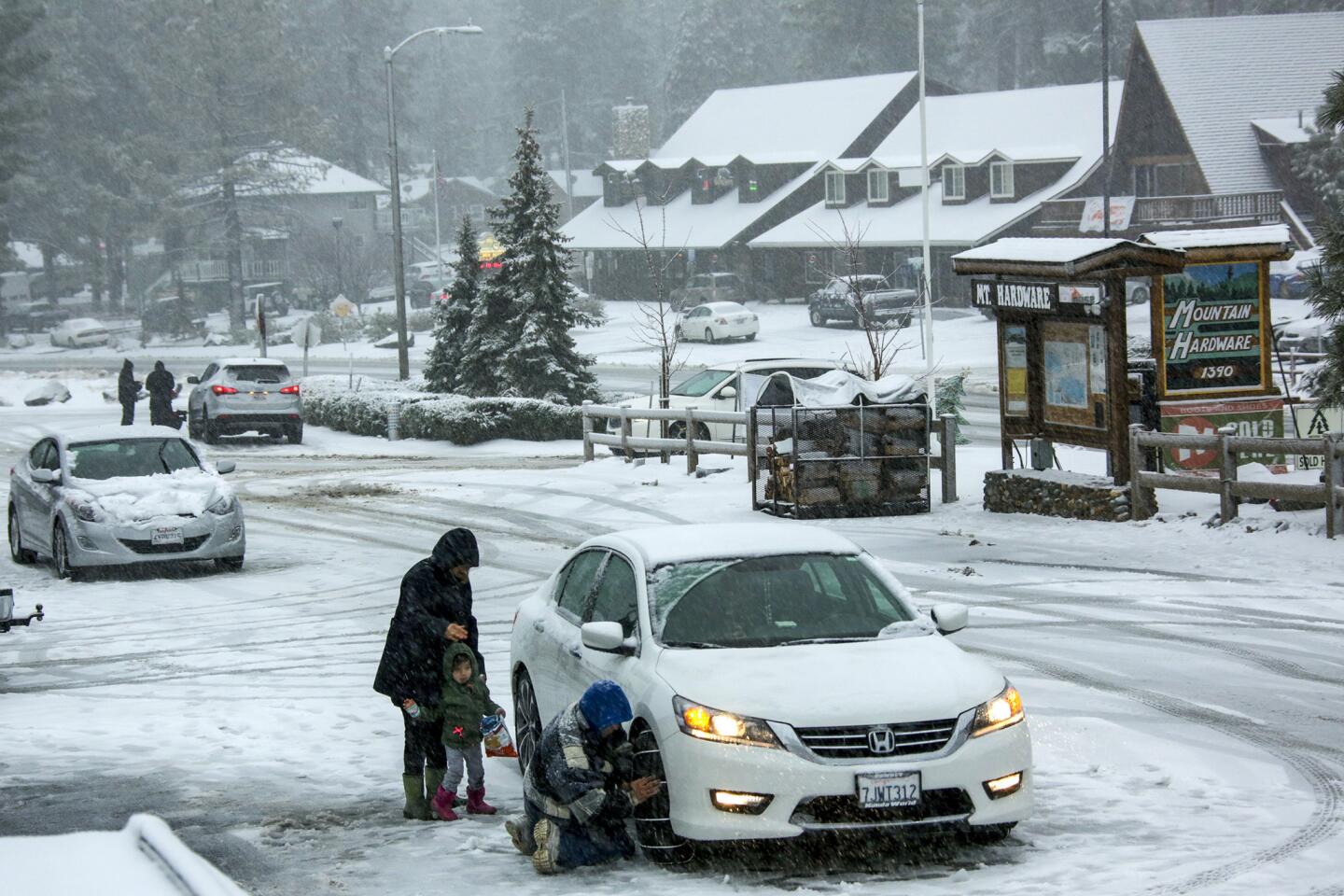
Due to heavy snow fall people visiting Wrightwood are required put on snow chains on their vehicles.
(Irfan Khan / Los Angeles Times)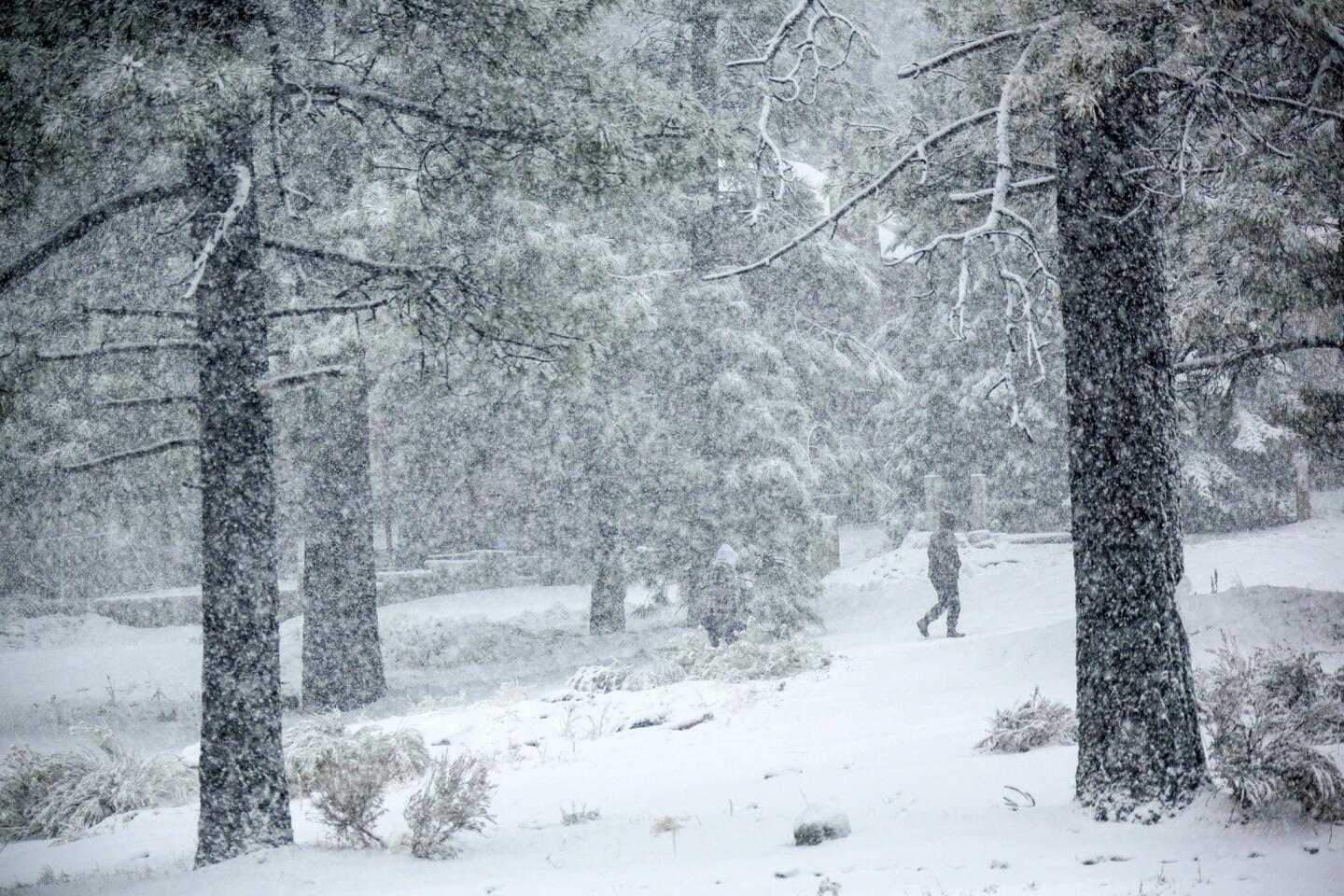
Visibility is down due to heavy snow fall in Wrightwood.
(Irfan Khan / Los Angeles Times)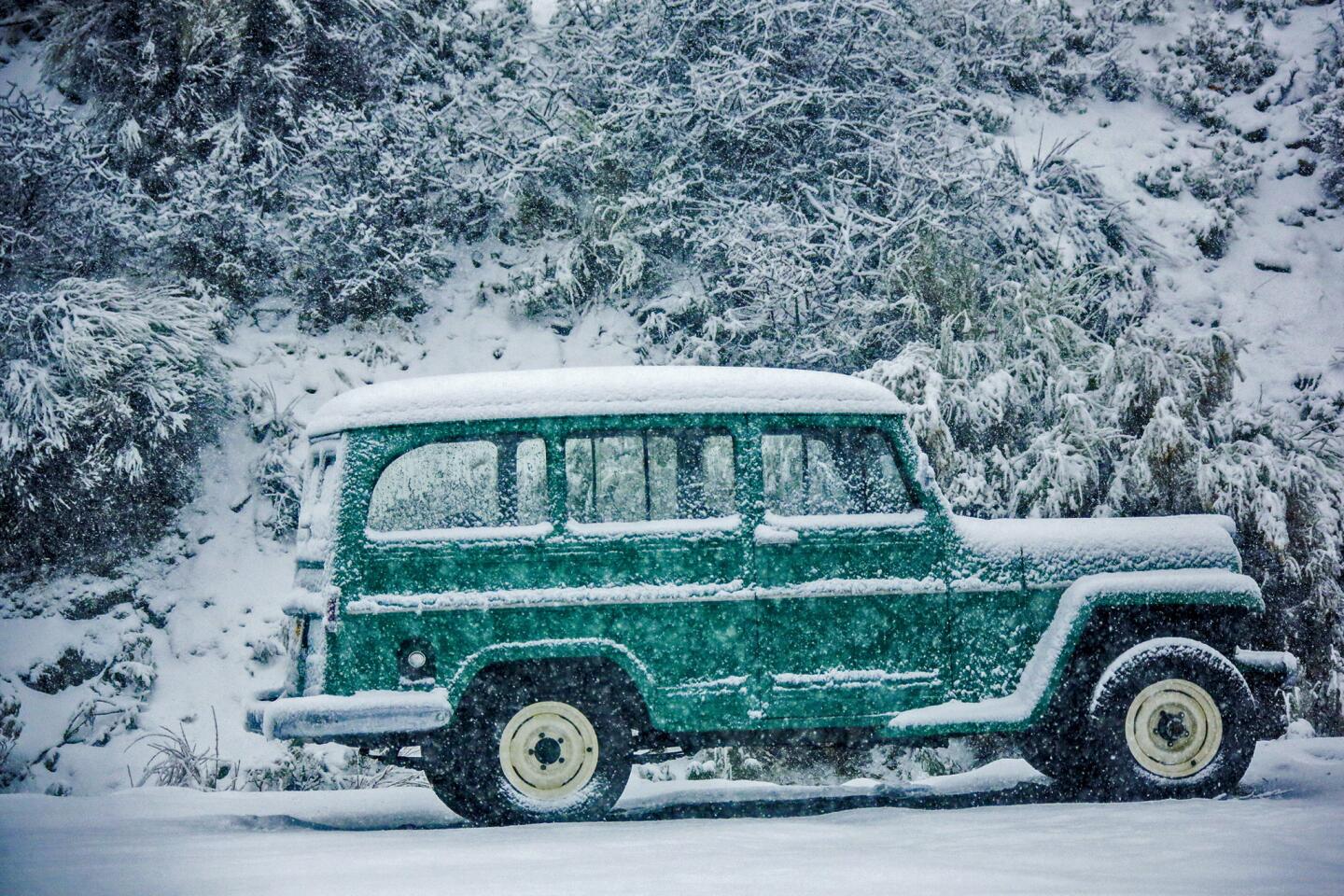
Heavy snow fall blankets an old truck in Wrightwood.
(Irfan Khan / Los Angeles Times)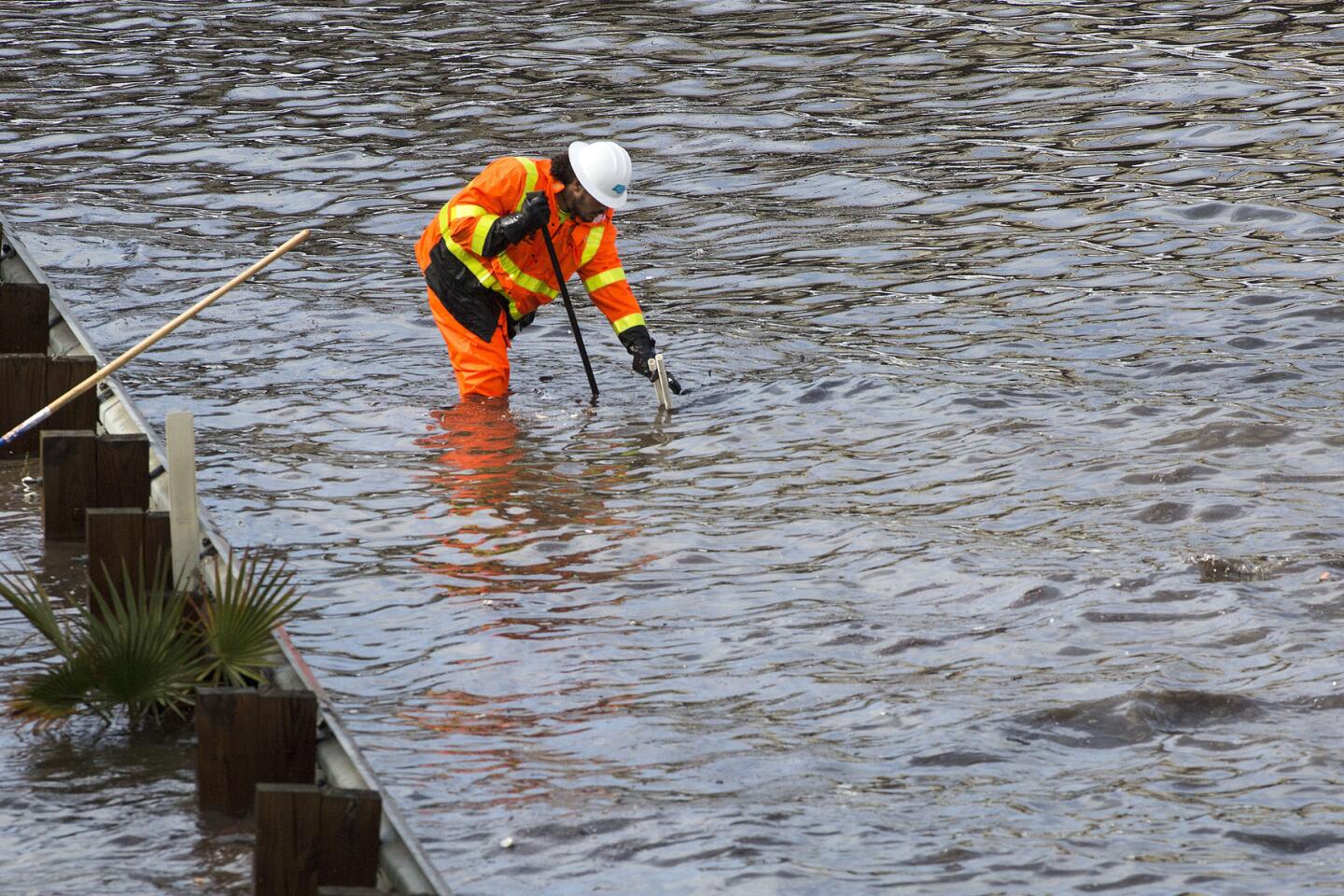
A Caltrans worker toils to clear drains on a flooded Interstate 5 in Sun Valley, Calif.
(Brian van der Brug / Los Angeles Times)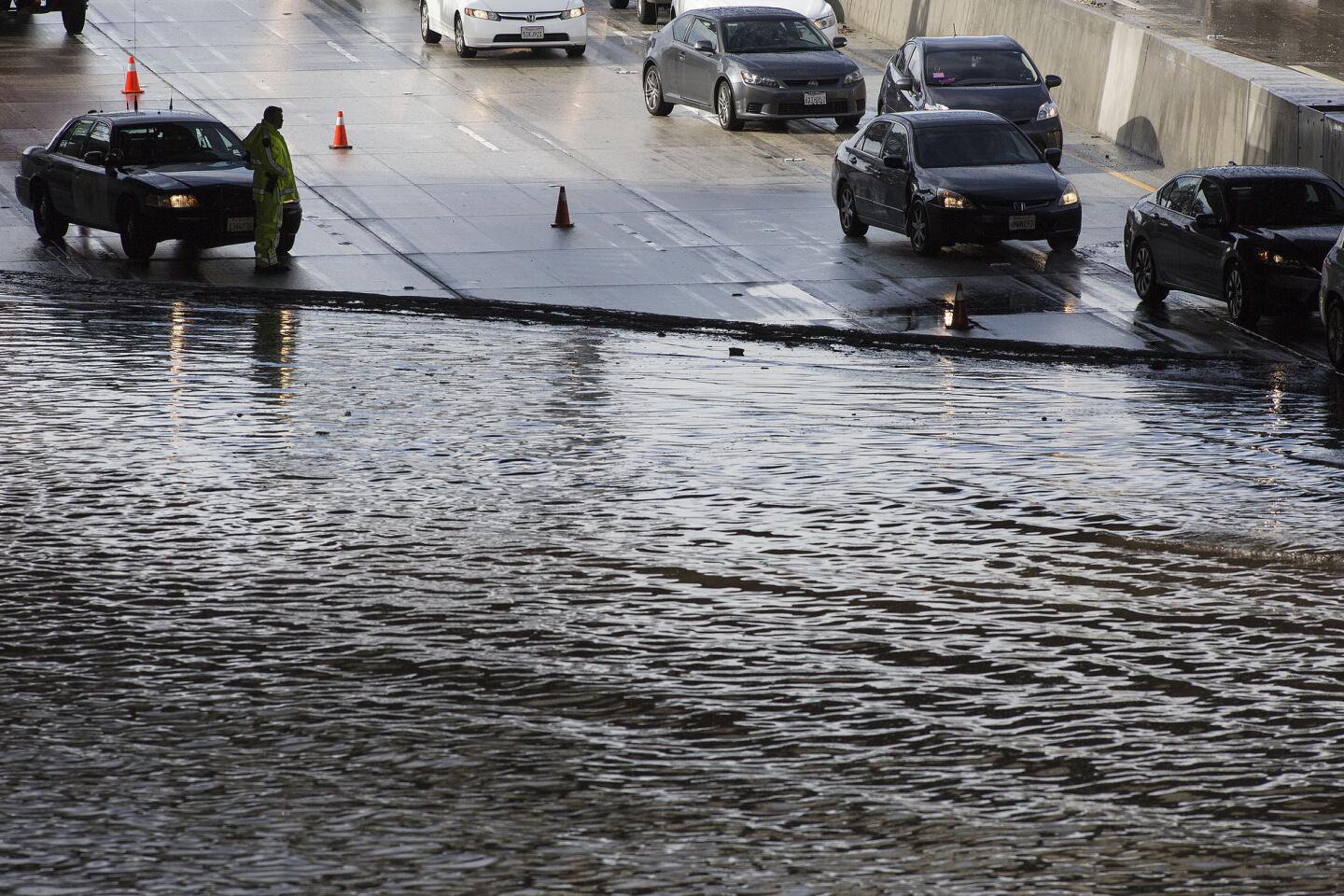
CHP officers limit traffic on a flooded Interstate 5 to one lane in each direction as Caltrans workers work to clear drains in Sun Valley, Calif.
(Brian van der Brug / Los Angeles Times)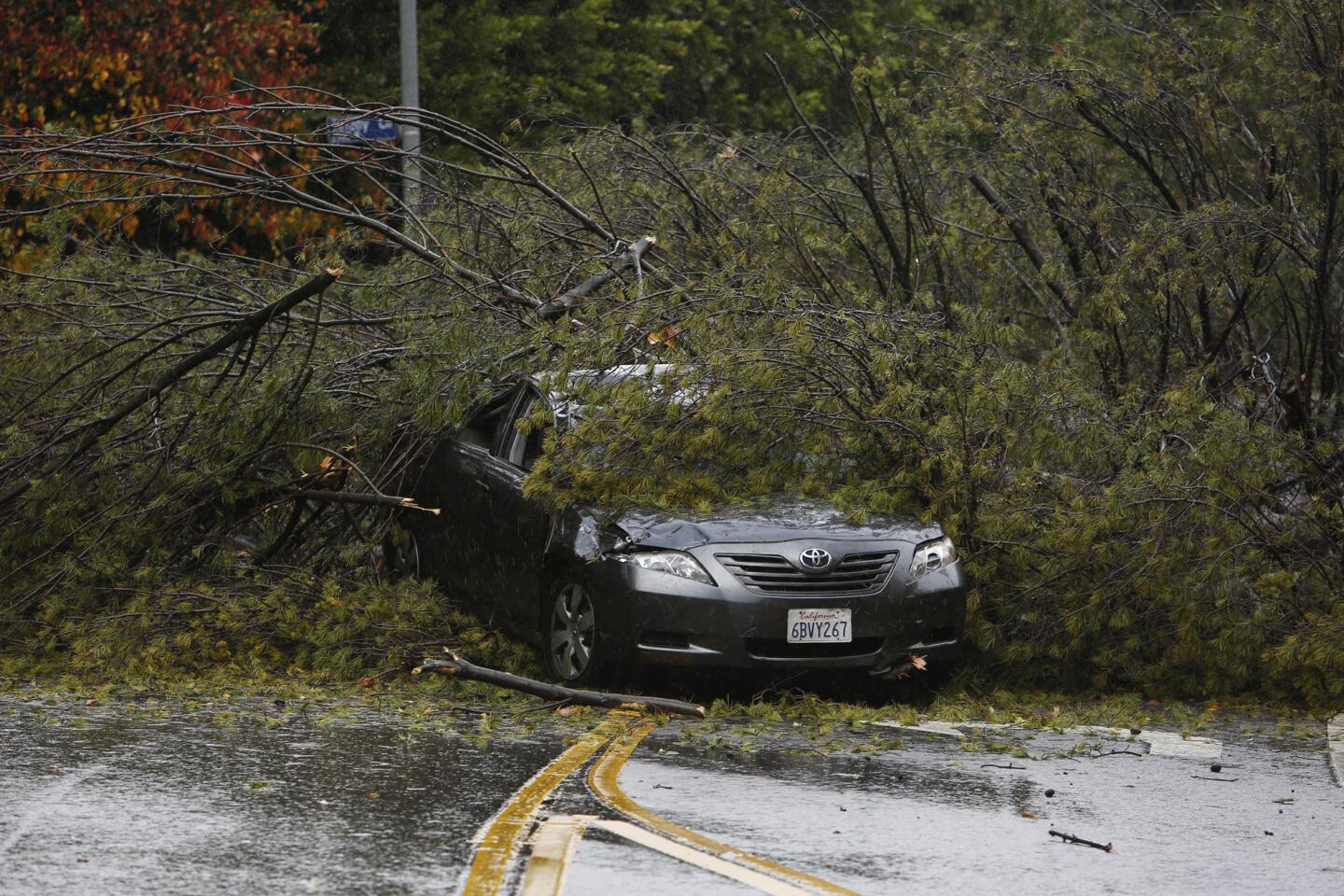
A tree fell on a car on Beverly Glen Blvd. at Windtree Dr. in the Hollywood Hills.
(Katie Falkenberg / Los Angeles Times)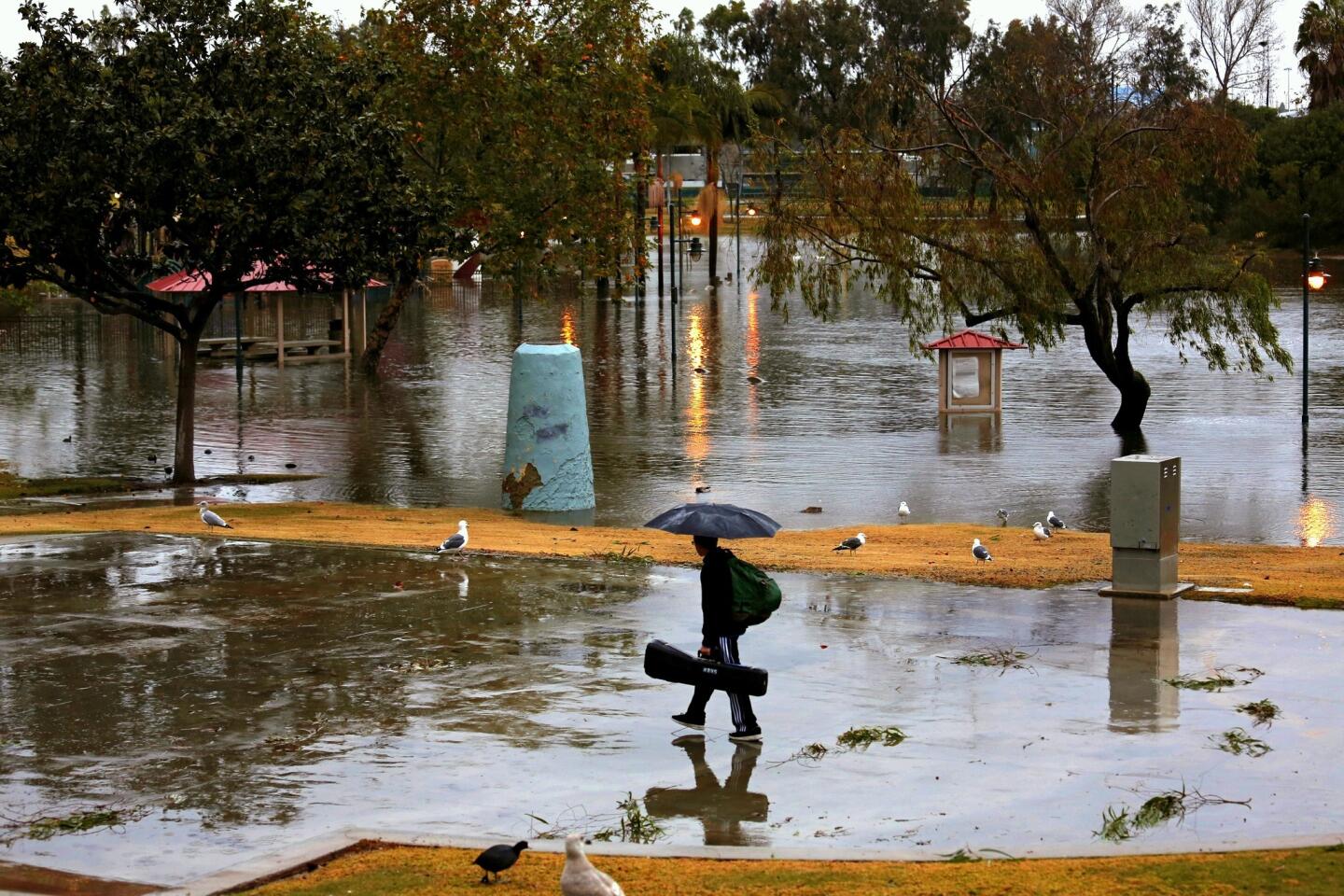
William McPhie, 12, of Manhattan Beach, walks home through a flooded Poliwog Park.
(Jay L. Clendenin / Los Angeles Times)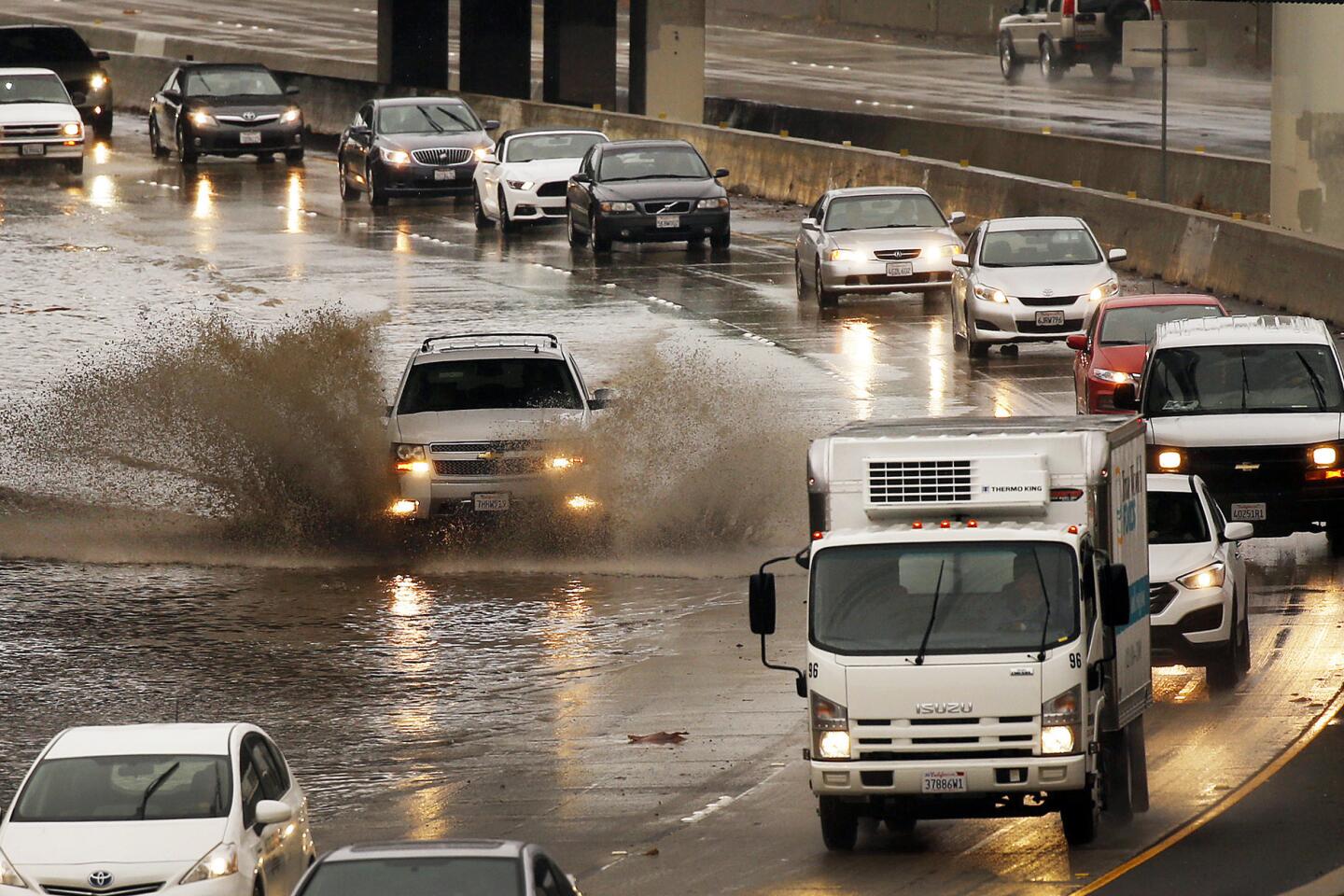
Vehicles navigate a flooded 101 Freeway at California Street in downtown Ventura after heavy rains Wednesday.
(Al Seib / Los Angeles Times)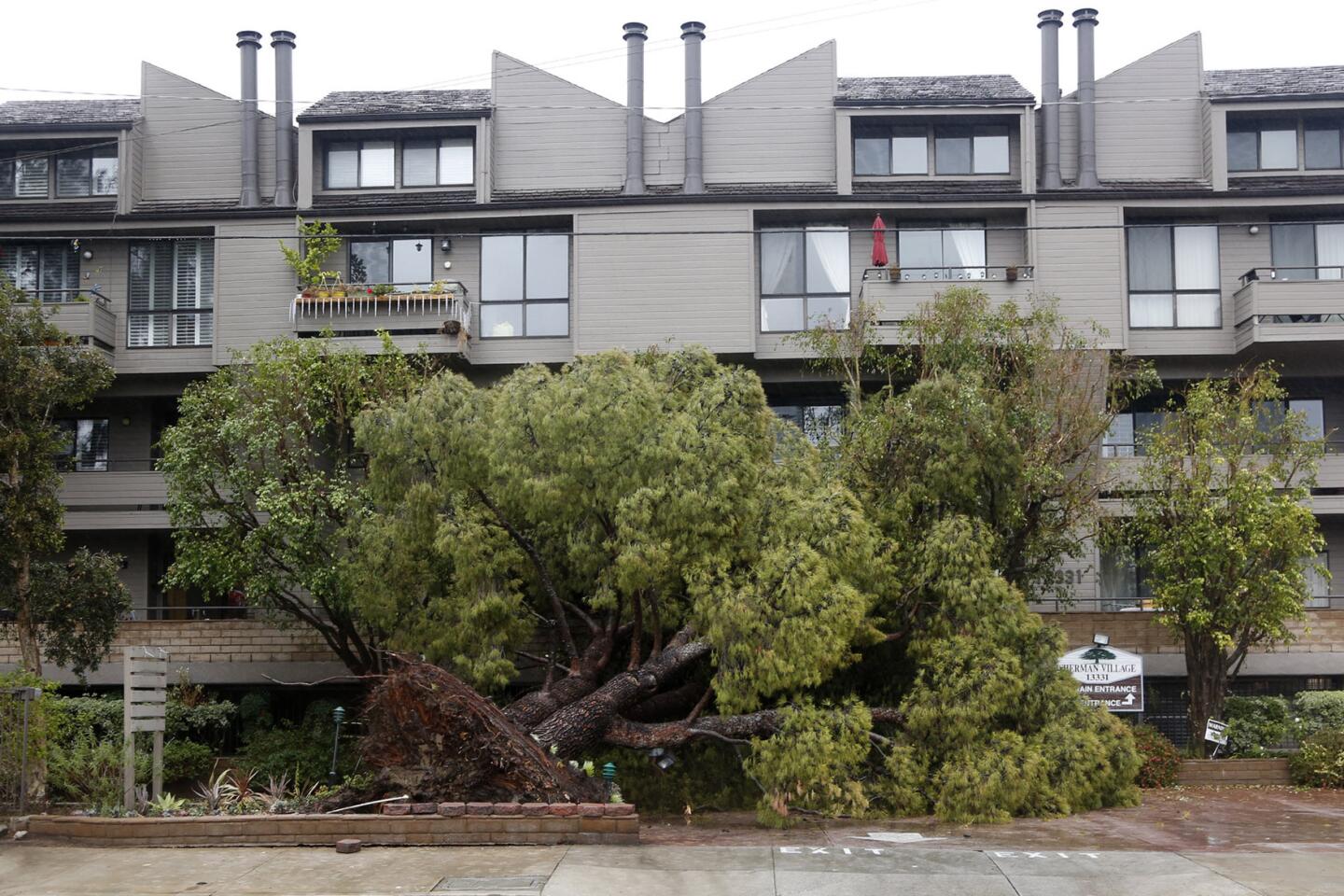
A large tree fell in front of the Sherman Village complex on Moorpark Street in Sherman Oaks.
(Katie Falkenberg / Los Angeles Times)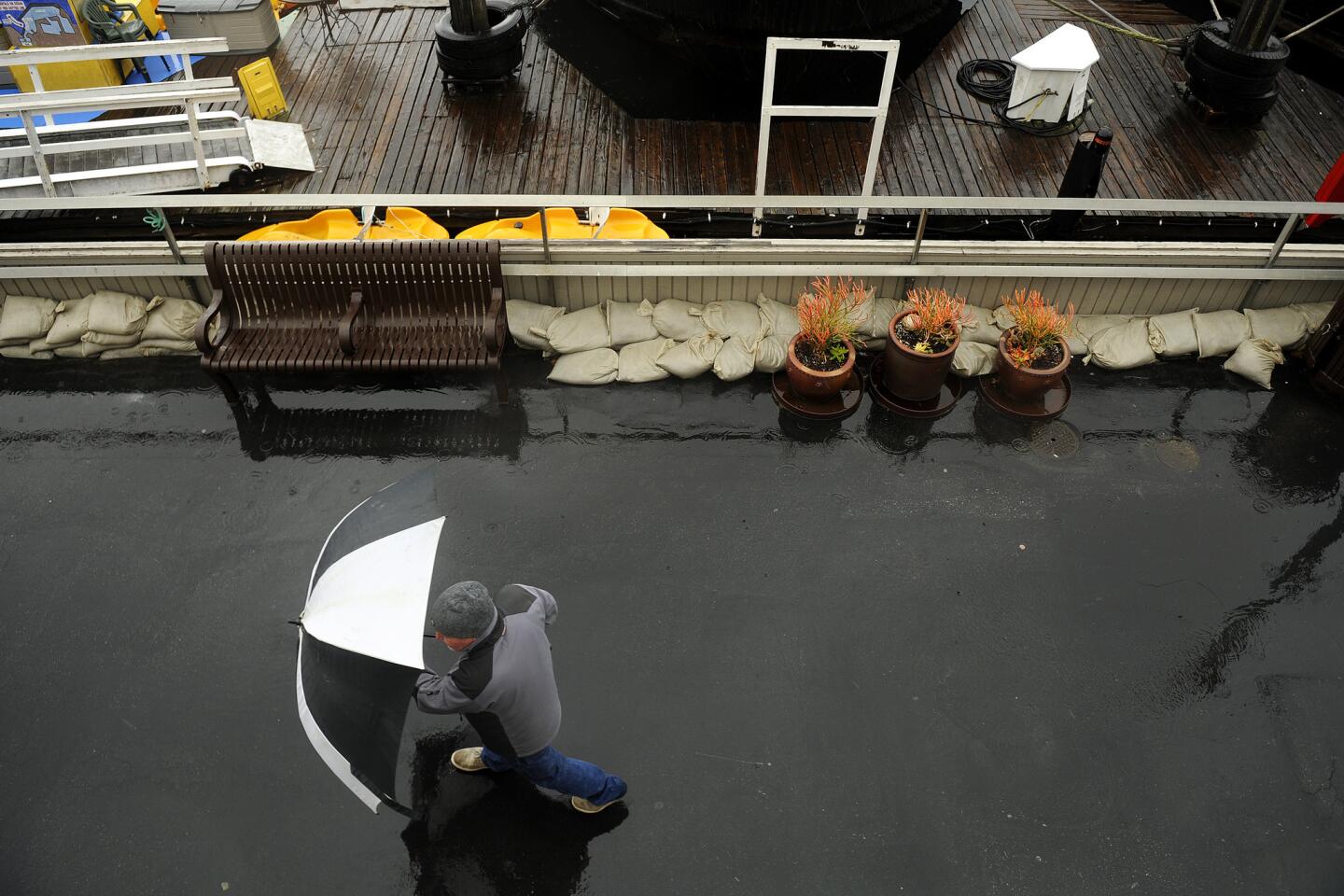
A man points his umbrella against the wind at King Harbour in Redondo Beach.
(Christina House / For The Times)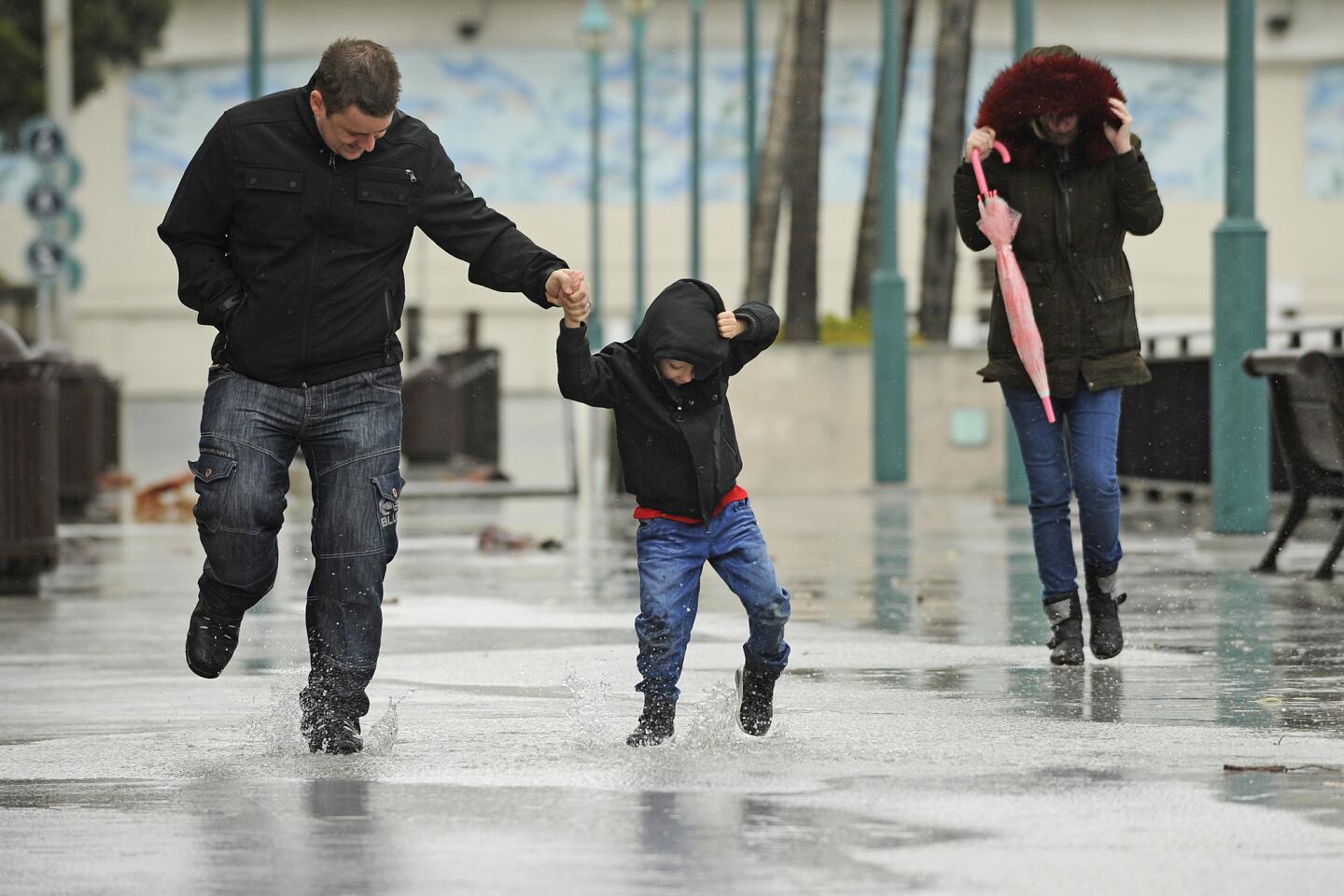
Scott Hesford-Hensler, left, plays in the rain with his son Jayden, 5, and wife Danielle, right, at King Harbour in Redondo Beach.
(Christina House / For The Times)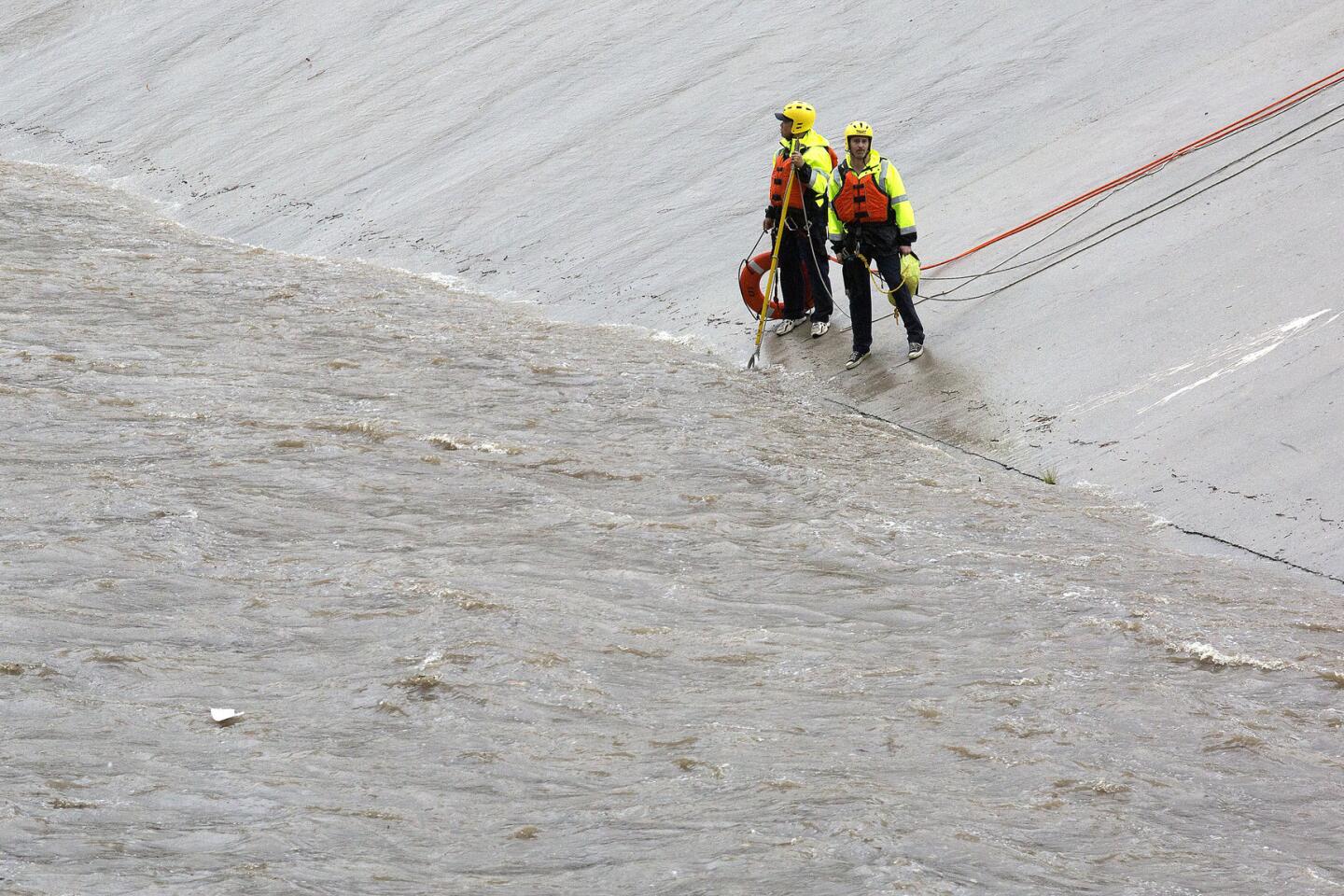
Los Angeles Fire Department swift water rescue personnel deploy along the LA River after a report of a child in the water in Winnetka, Calif.
(Brian van der Brug / Los Angeles Times)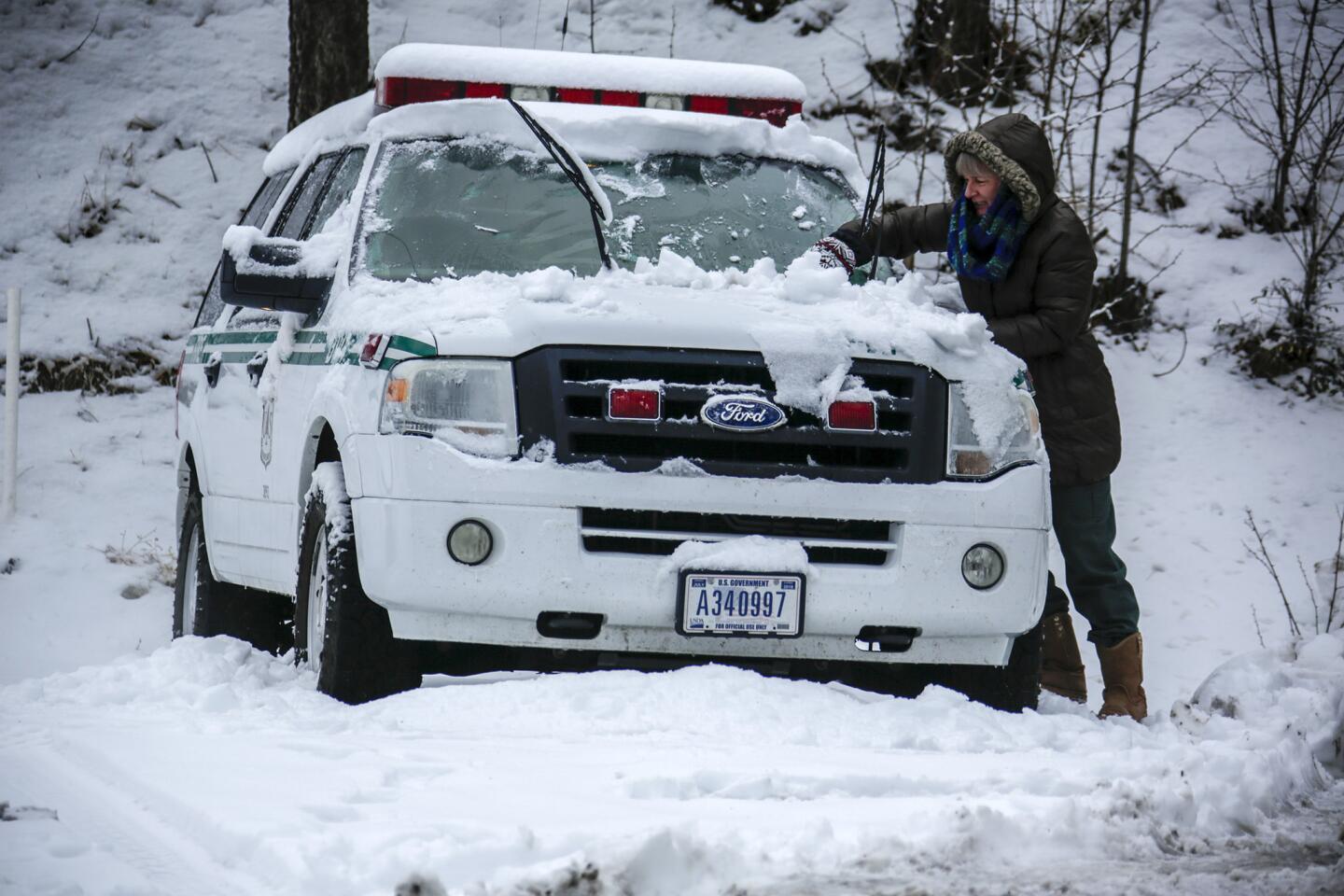
Diane Travis of Angeles Forest service removes snow from her vehicle above Wrightwood at Mountain High.
(Irfan Khan / Los Angeles Times)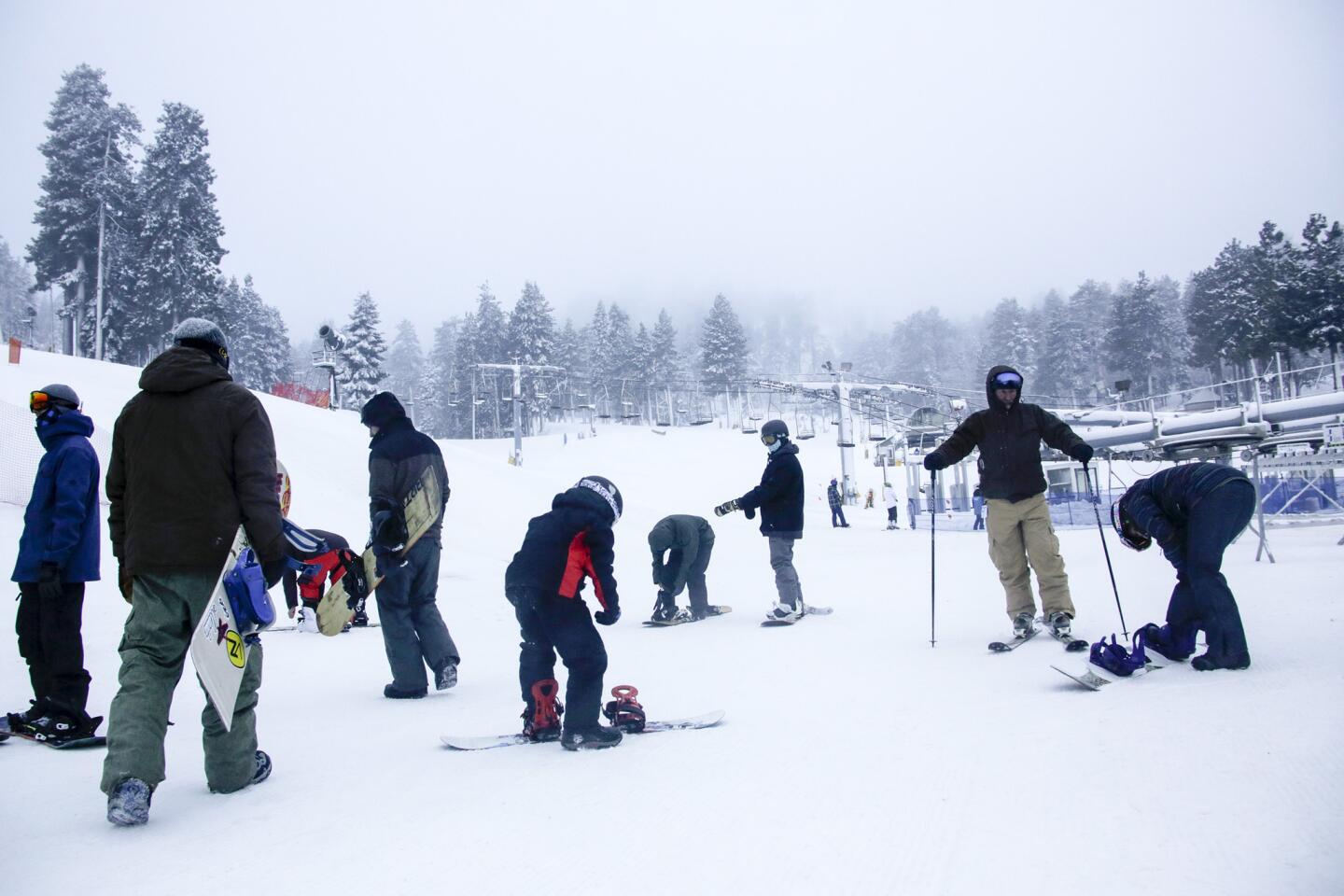
Snow boarders and skiers take advantage of fresh snow as they wait for Mountain High West to open on Wednesday morning.
(Irfan Khan / Los Angeles Times)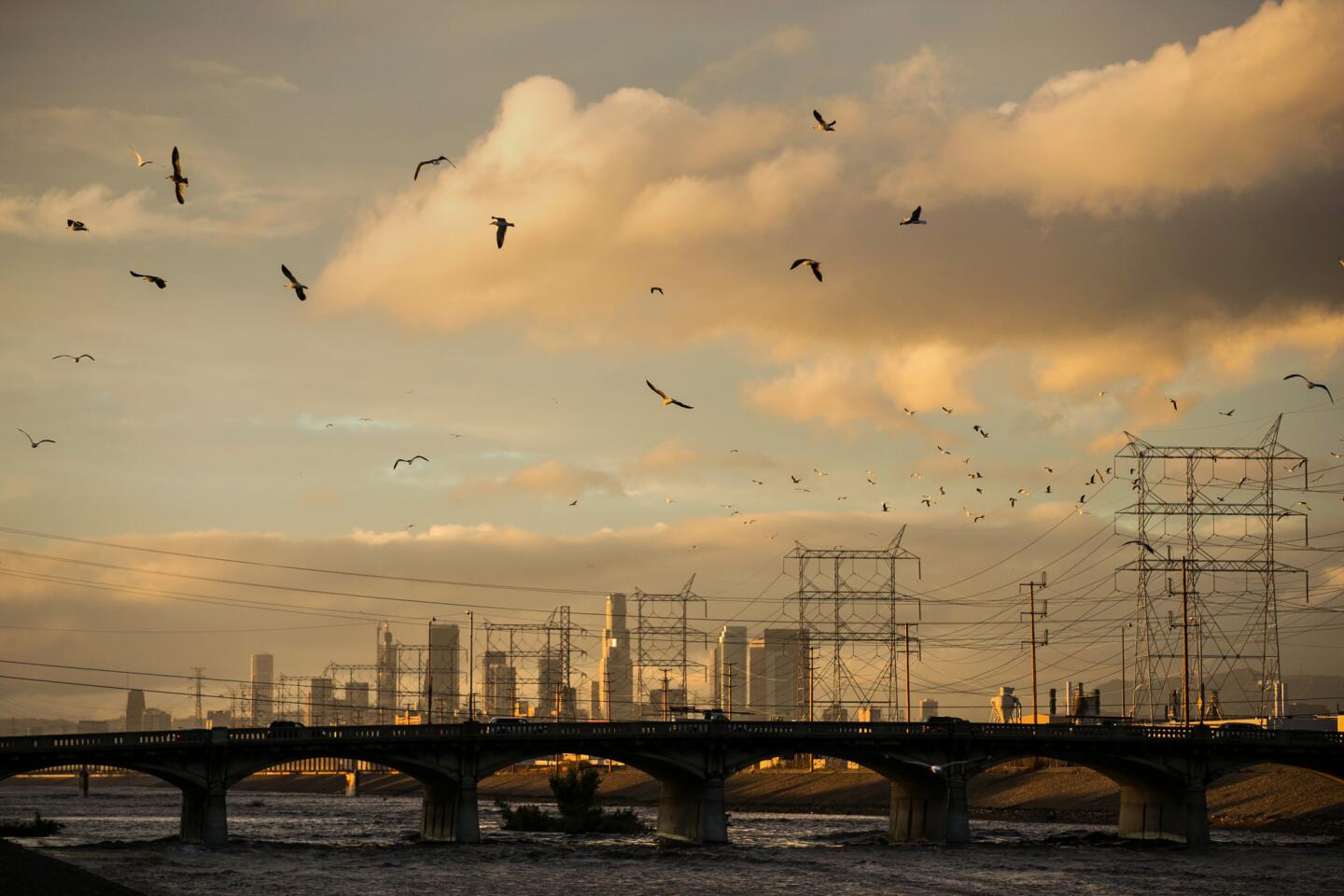
Birds soar above the Los Angeles River in Vernon after a rainstorm.
(Marcus Yam / Los Angeles Times)
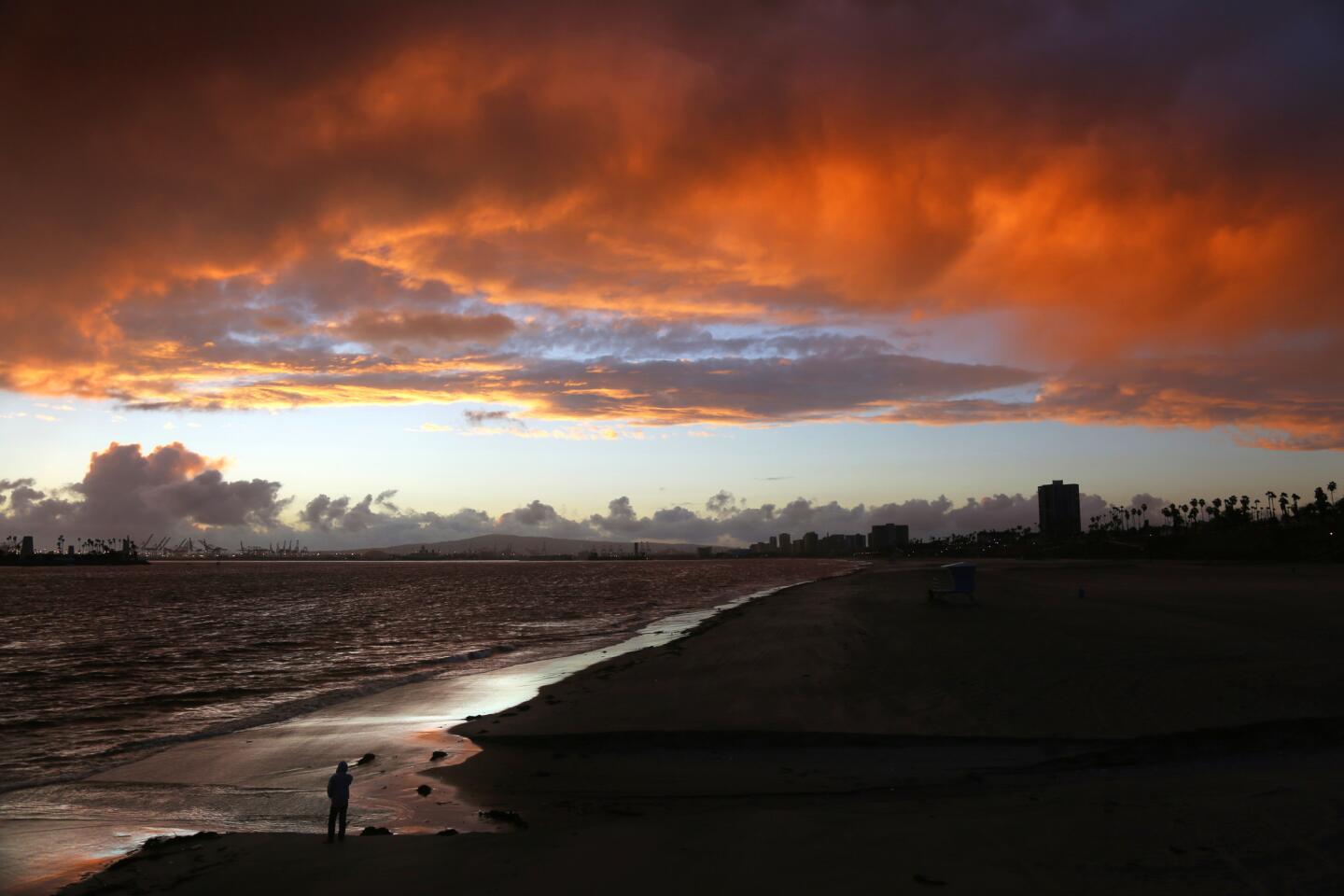
A man watches a memorable sunset that ended a mostly rainy day in the Los Angeles area as the first big storm of El Nino rolled through the area.
(Rick Loomis / Los Angeles Times)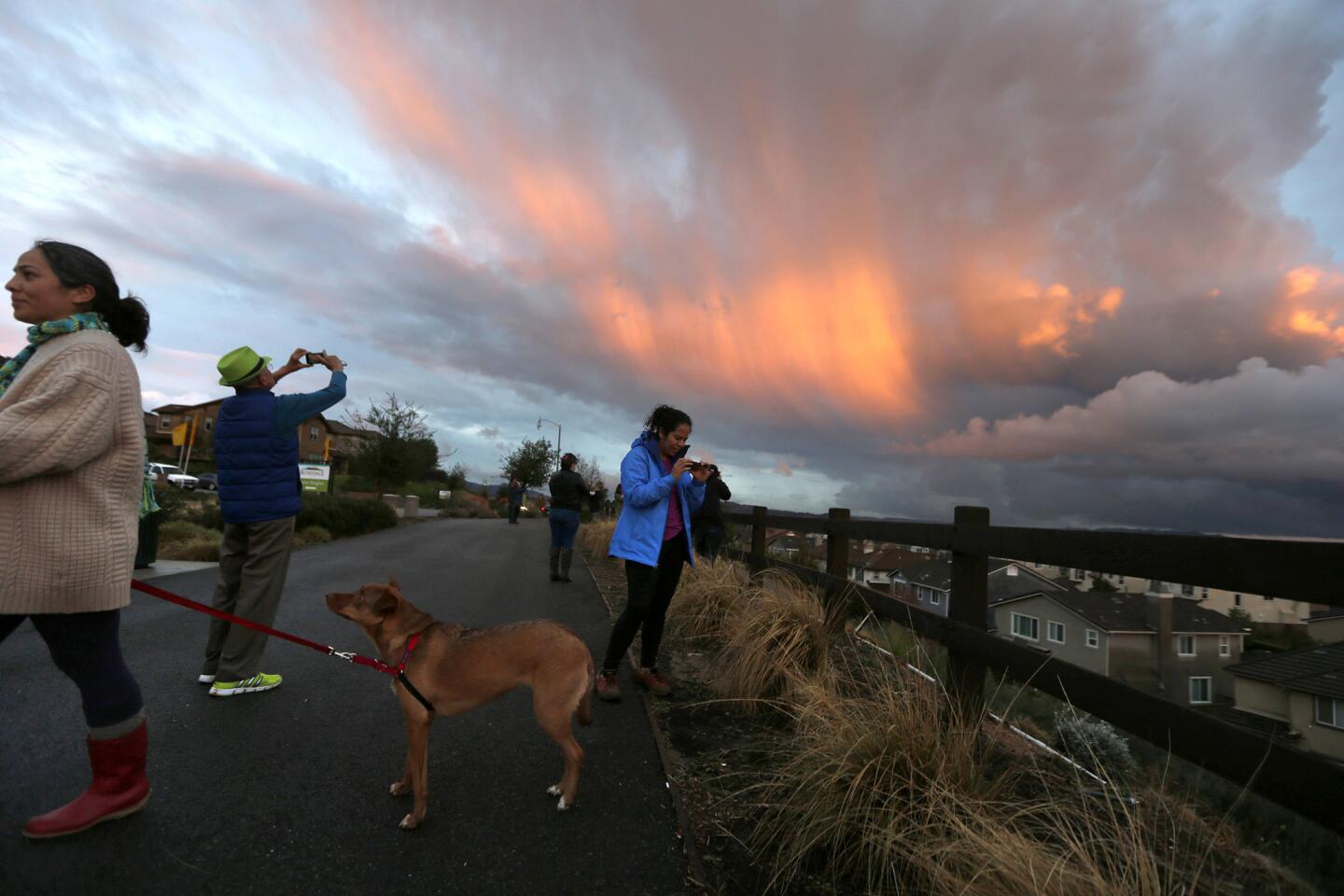
Azusa residents pause to take photos of the sunset minutes after a storm front moved past Sierra Madre Ave.
(Robert Gauthier / Los Angeles Times)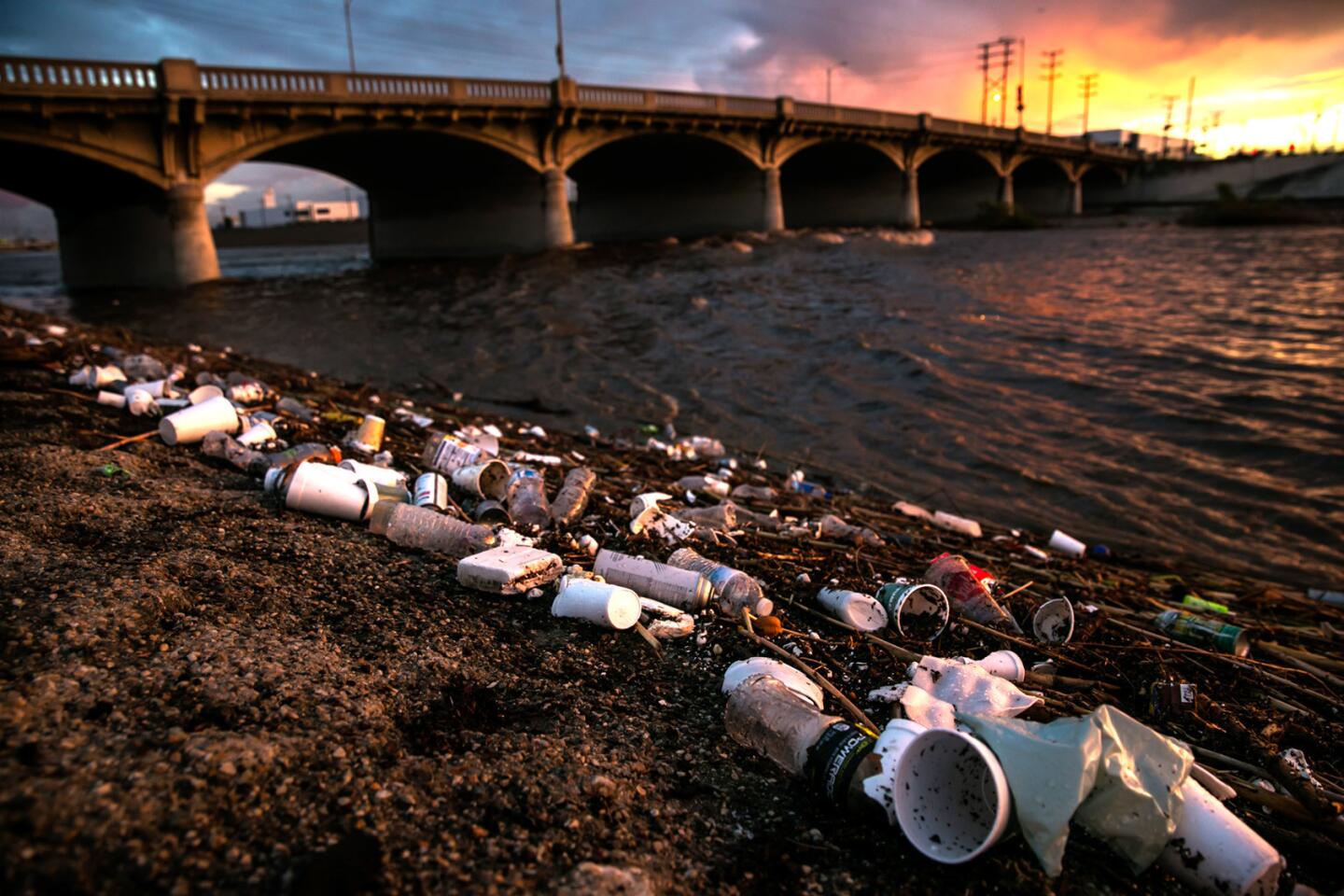
Trash collects on the banks of the Los Angeles River after a heavy rainstorm passed through the area, raising the water levels in the river in Vernon.
(Marcus Yam / Los Angeles Times)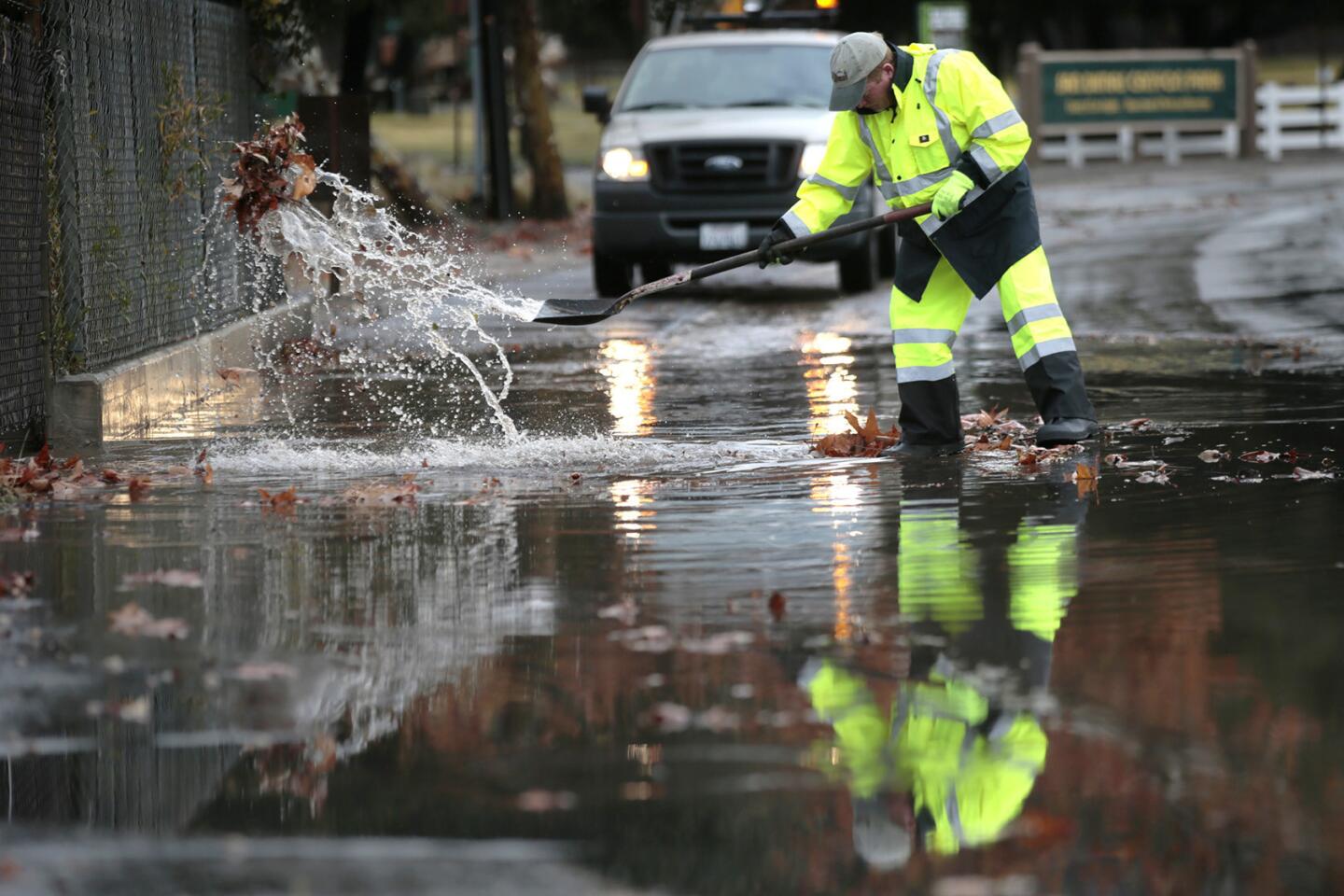
San Dimas Public Works Supervisor Terry Gregory cleears a clogged drain from North San Dimas Canyon Road as heavy rains cause clogged drains and mud flows in San Dimas, Glendora and Azusa.
(Robert Gauthier / Los Angeles Times)
Visitors to Angels Gate Park in San Pedro are framed between the sea and sun-tinged clouds as the first storm of El Nino blows ashore.
(Luis Sinco / Los Angeles Times)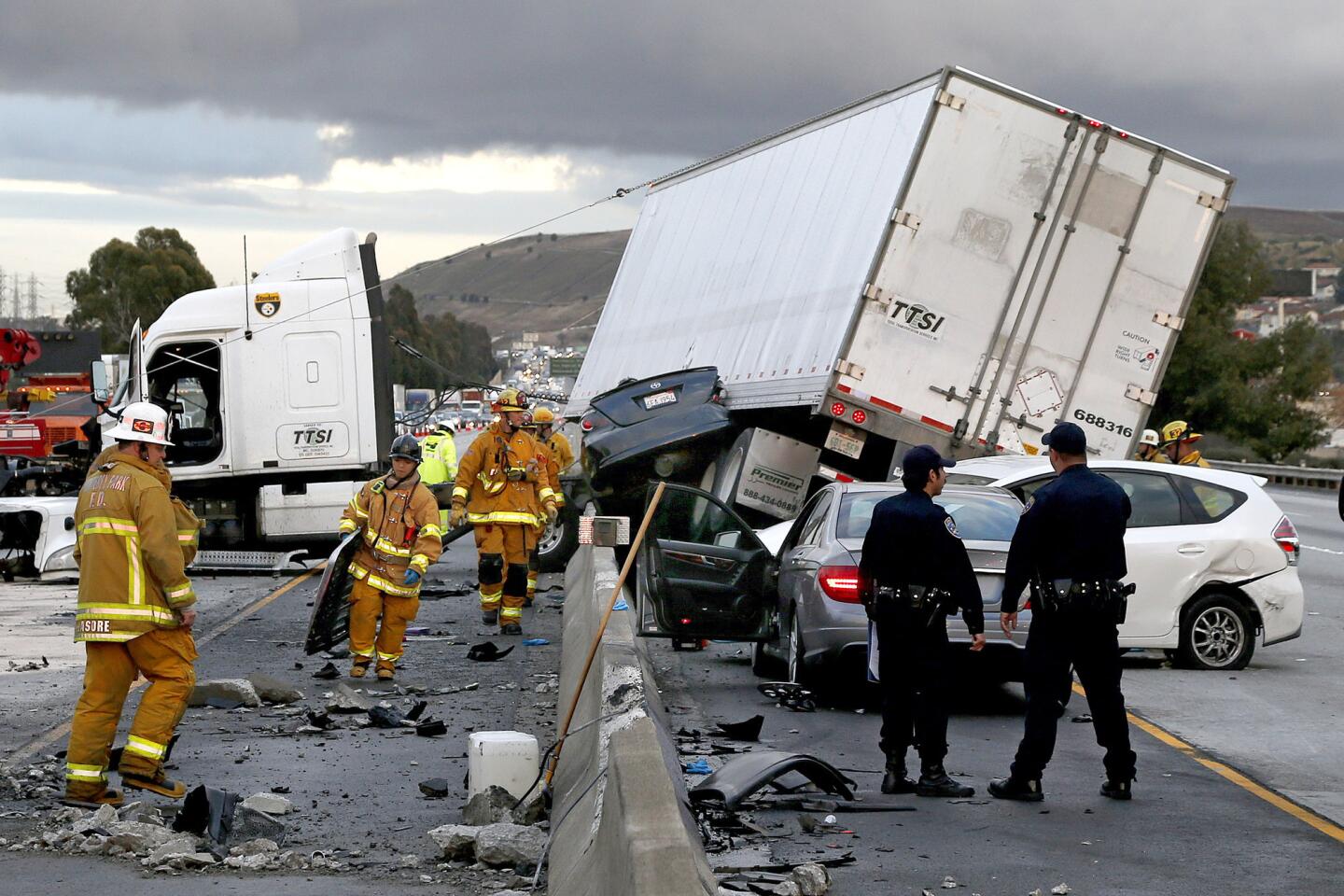
Firefighters and rescue personnel work at the scene after a big rig crashed through the center divider crushing a car underneath and causing four other vehicles to collide on the rain slicked 60 freeway near the Garfield Exit in Monterey Park, Calif.
(Gina Ferazzi / Los Angeles Times)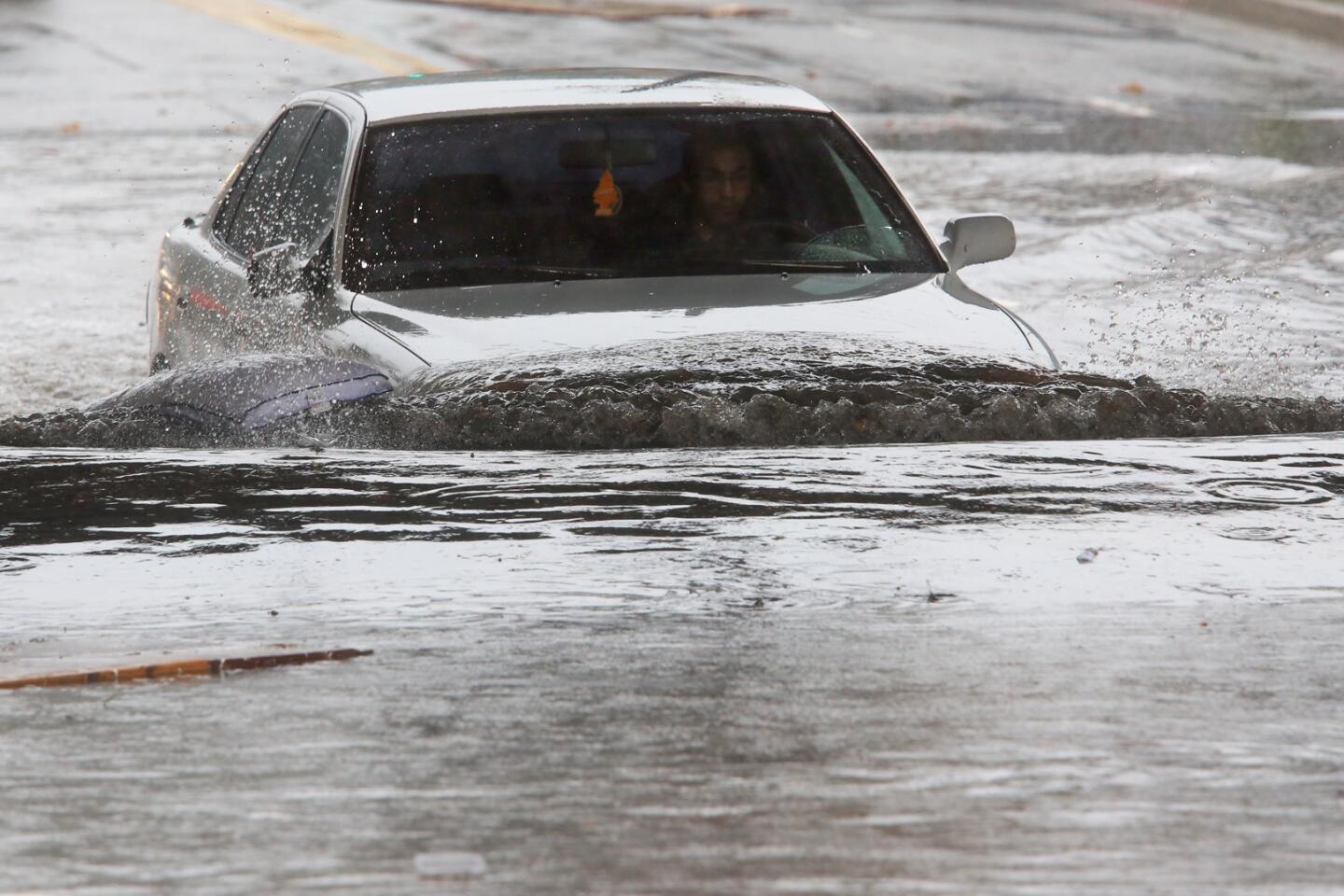
A driver braves a flooded section of Avenue 26 in Lincoln Heights in Los Angeles, Calif.
(Genaro Molina / Los Angeles Times)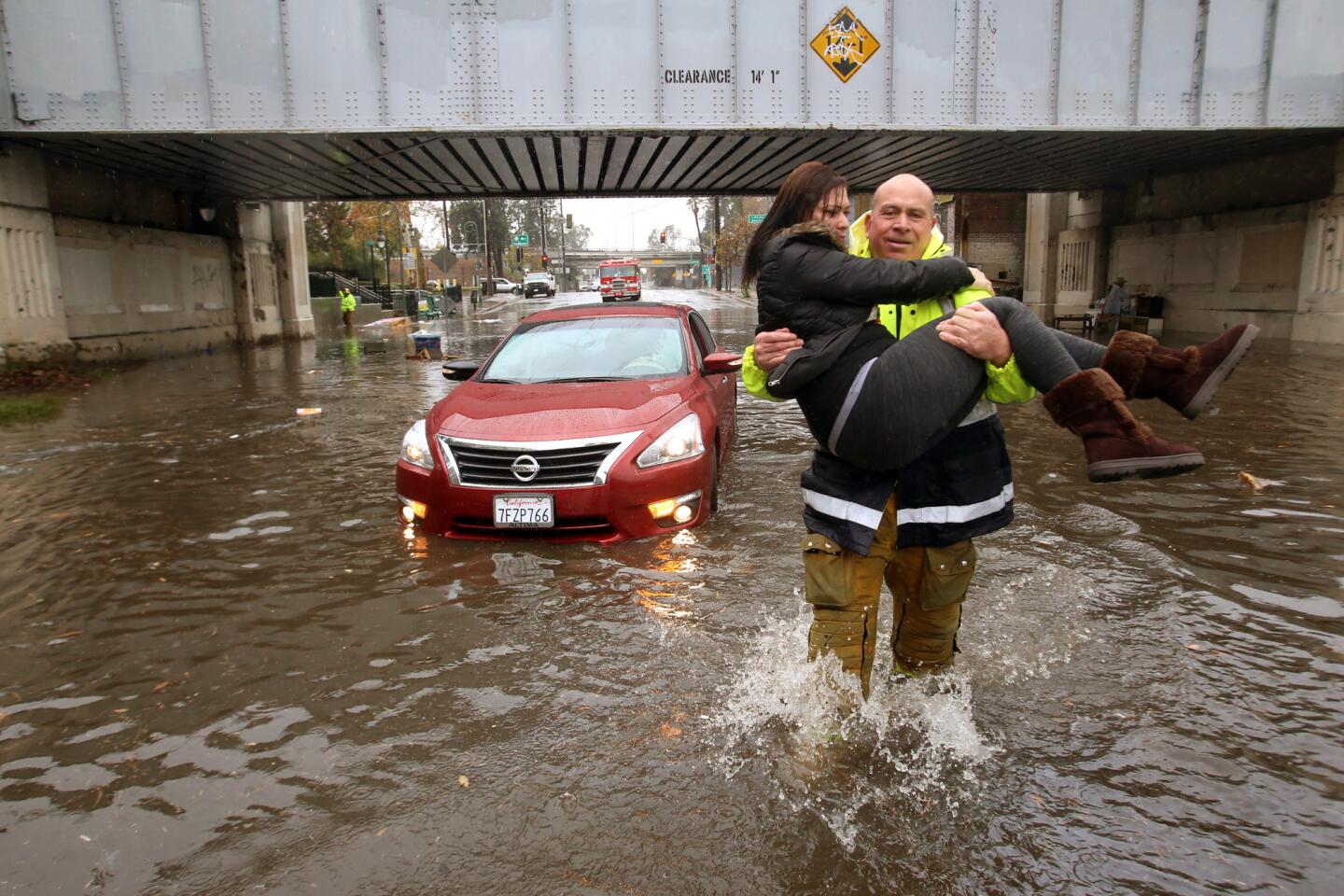
Yasmin Fernandez is carried away by Los Angeles Firefighter Jose Rodriguez after her car was caught in a flooded section of Avenue 26 in the Lincoln Heights in Los Angeles, Calif.
(Genaro Molina / Los Angeles Times)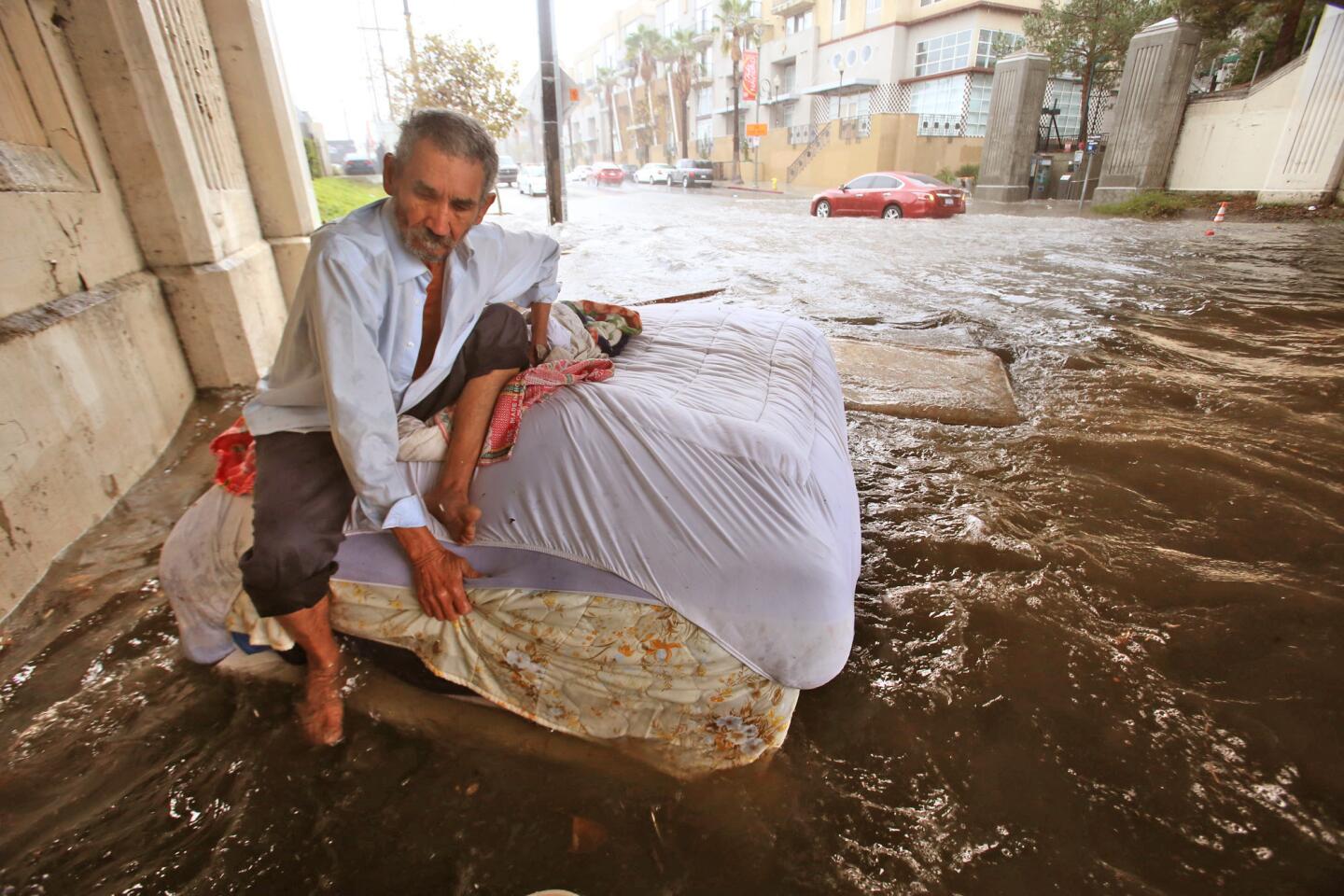
Felipe Flores Lopez, 59, tries to stay afloat on a bed at his homeless encampment as rainwater floods a section of Avenue 26.
(Genaro Molina / Los Angeles Times)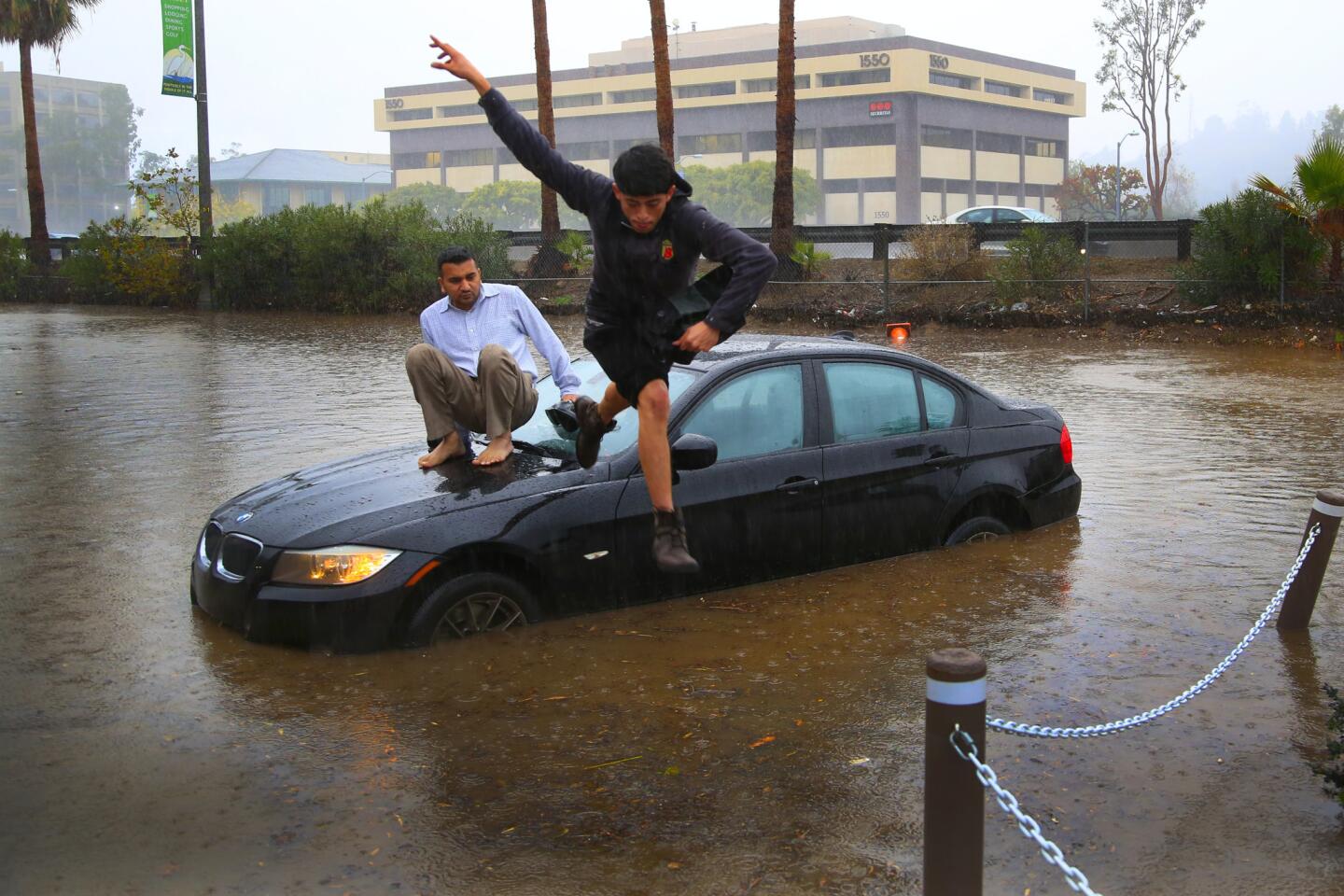
Octavio Angulo (jumping) and Mike Patel had to abandoned their vehicle on South Hotel Circle in Mission Valley Road when the flooded road stalled their vehicle in San Diego, CA
(Nelvin C. Cepeda / San Diego Union-Tribune)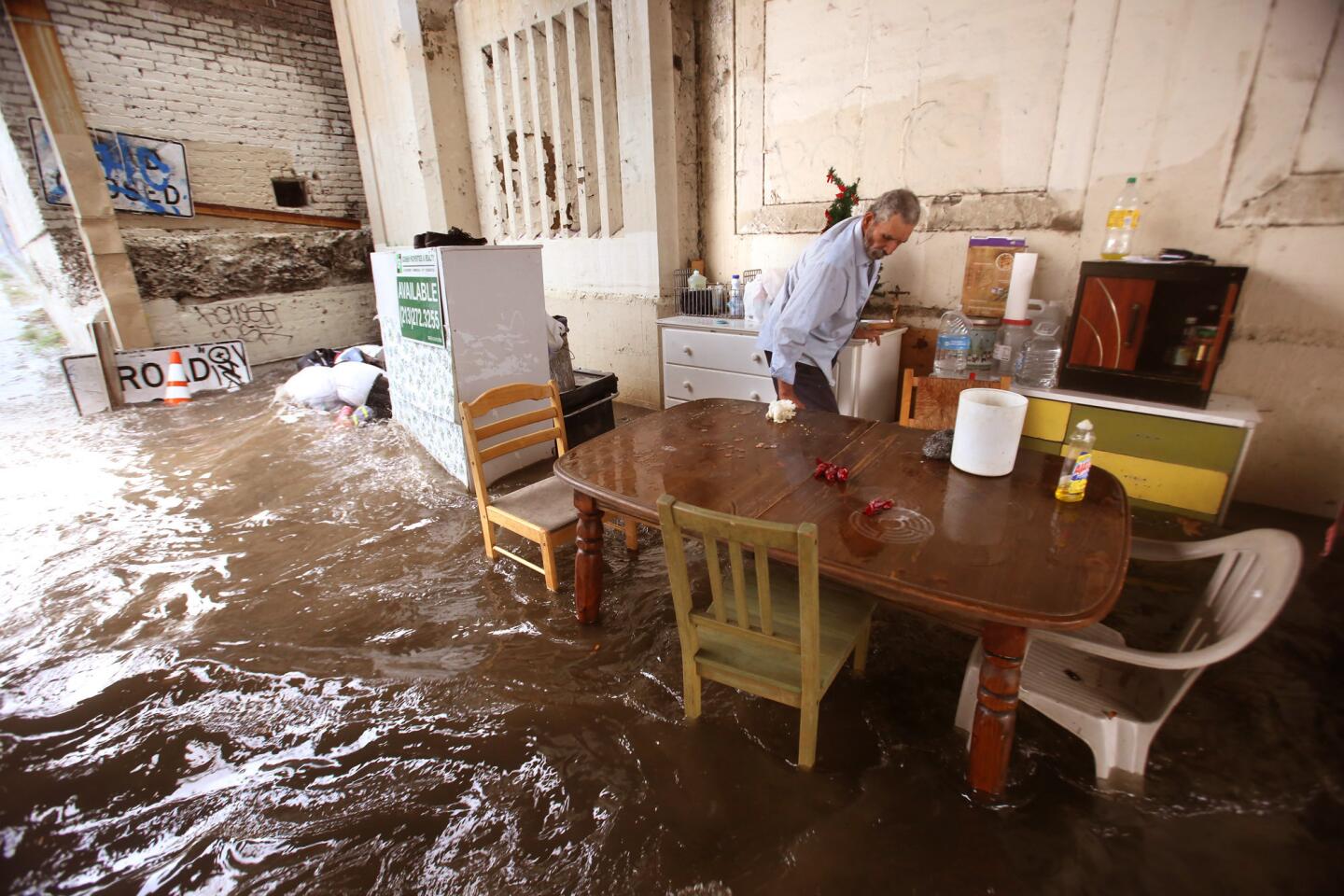
Felipe Flores Lopez, 59, tries to secure his homeless encampment as water begins to flood on Avenue 26.
(Genaro Molina / Los Angeles Times)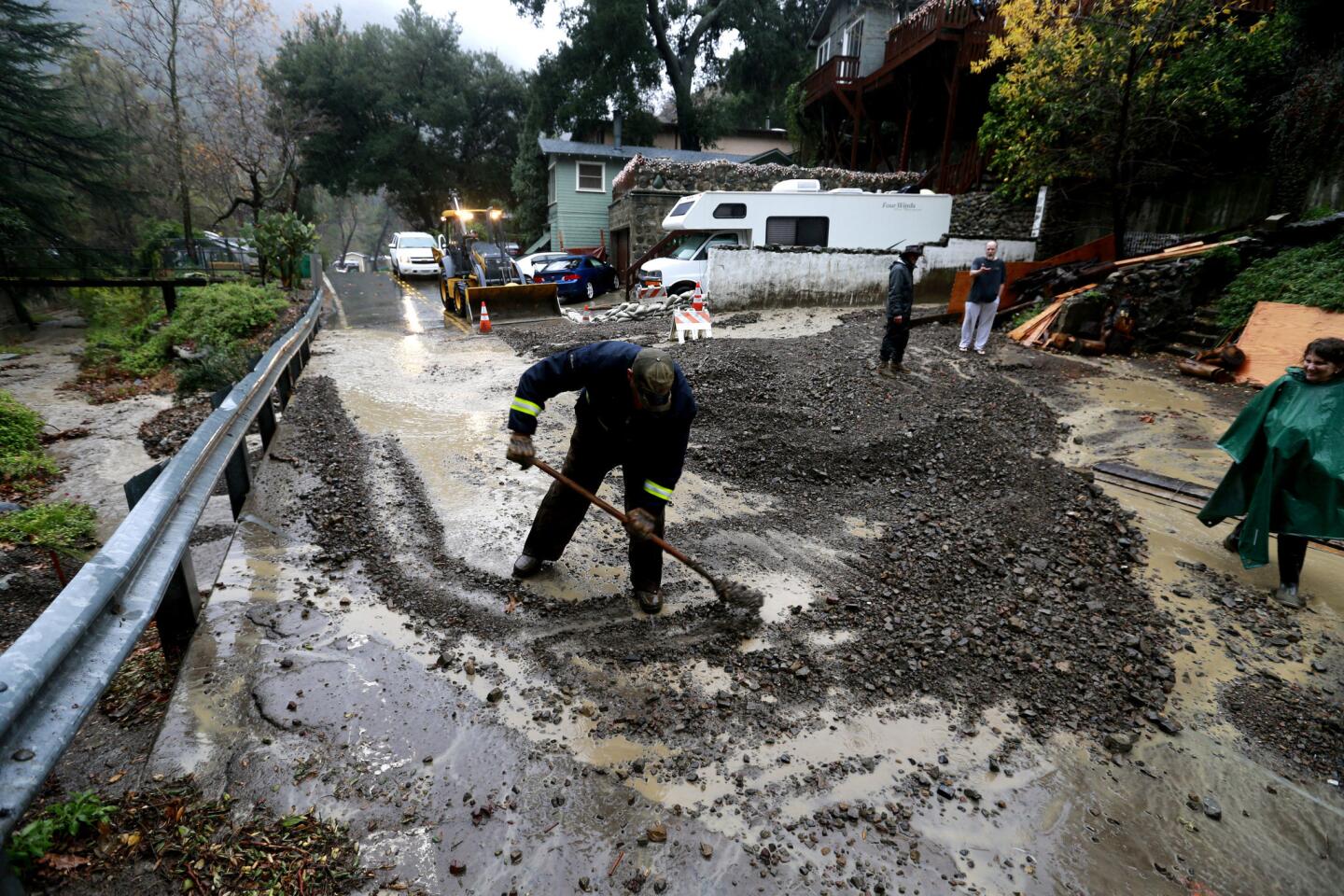
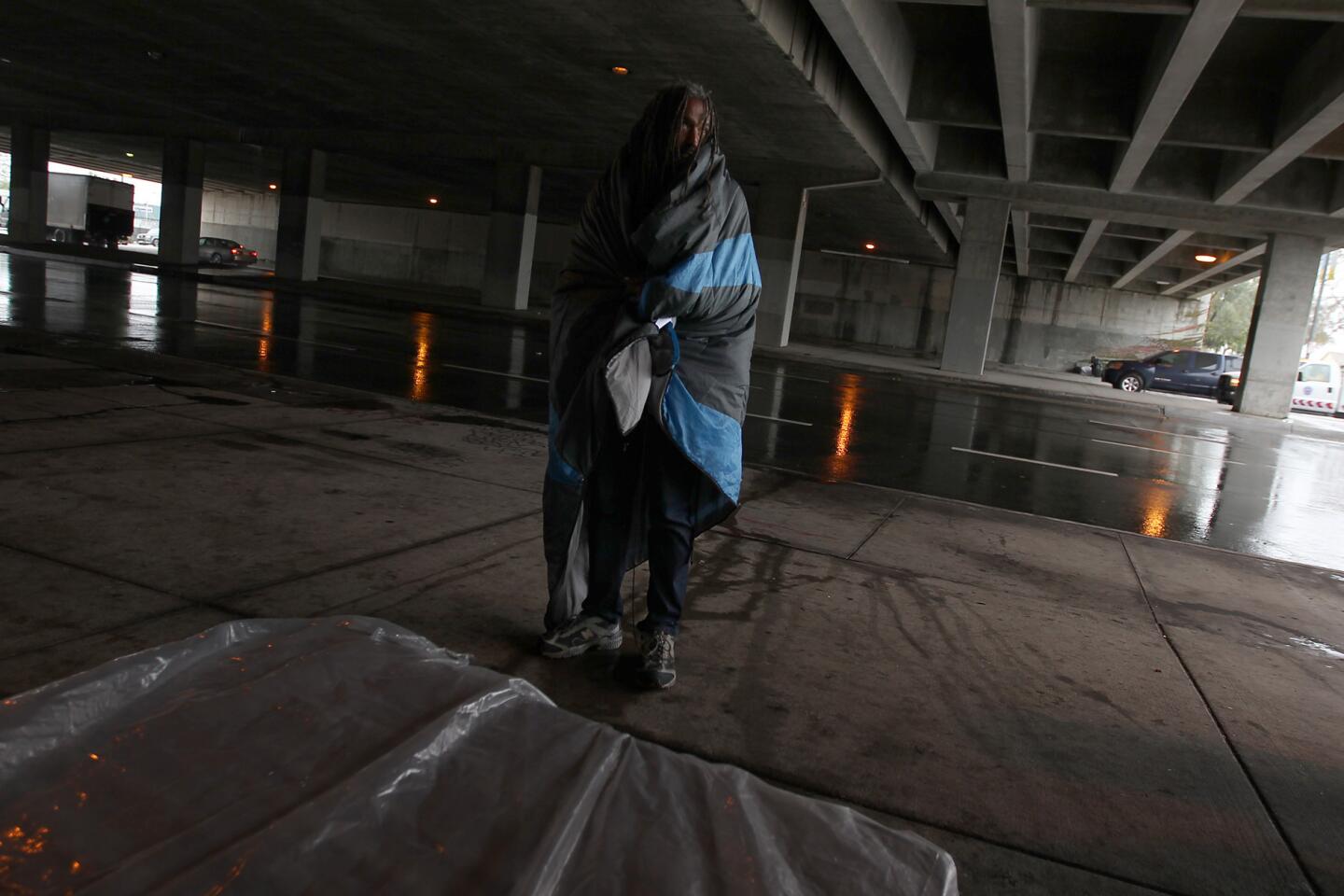
A homeless man seeks shelters beneath the 405 Freeway along Venice Boulevard as the first of several El Niño storms hit Southern California.
(Luis Sinco / Los Angeles Times)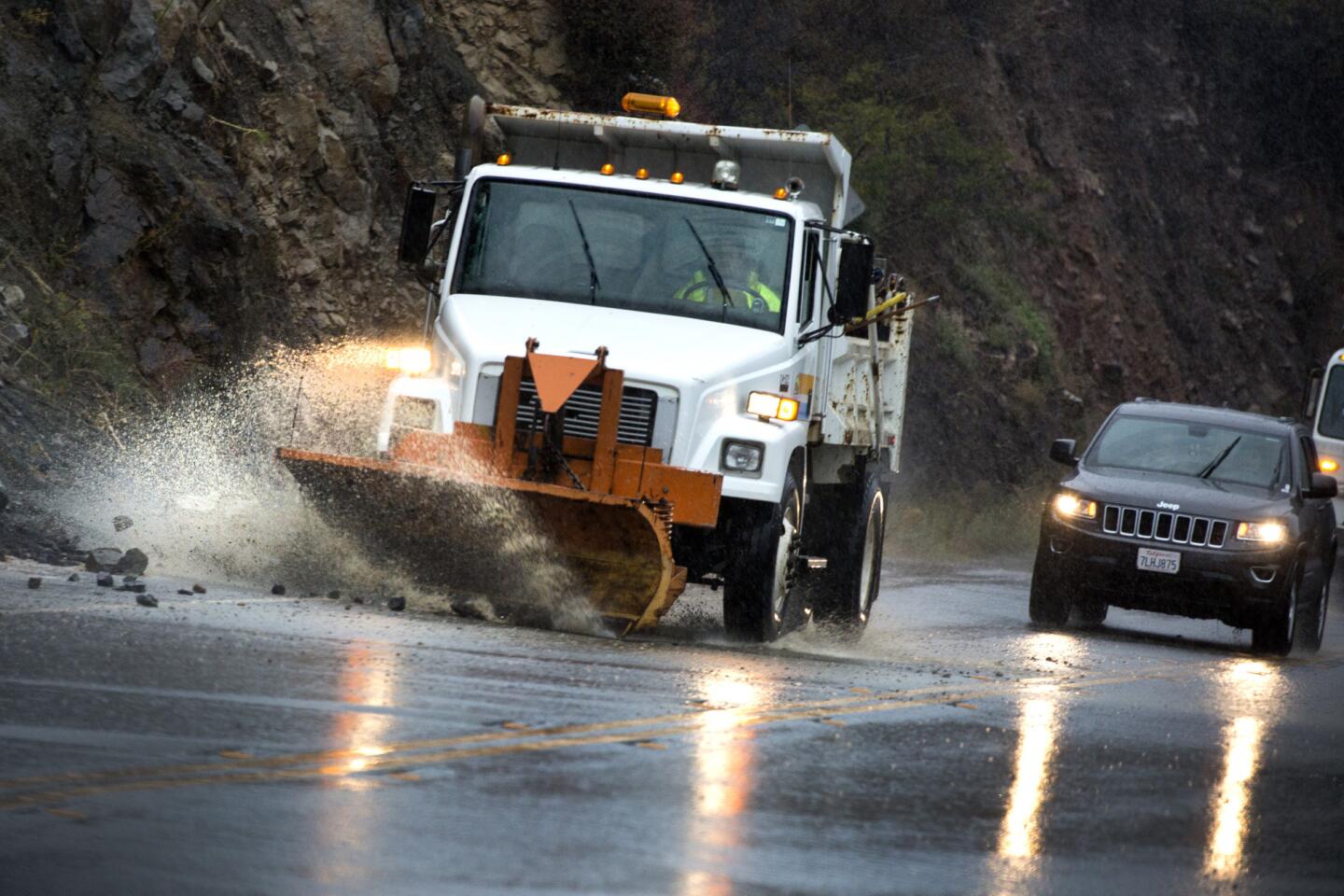
A Los Angeles County Public Works plow removes rocks from rain-soaked Malibu Canyon Road.
(Brian van der Brug / Los Angeles Times)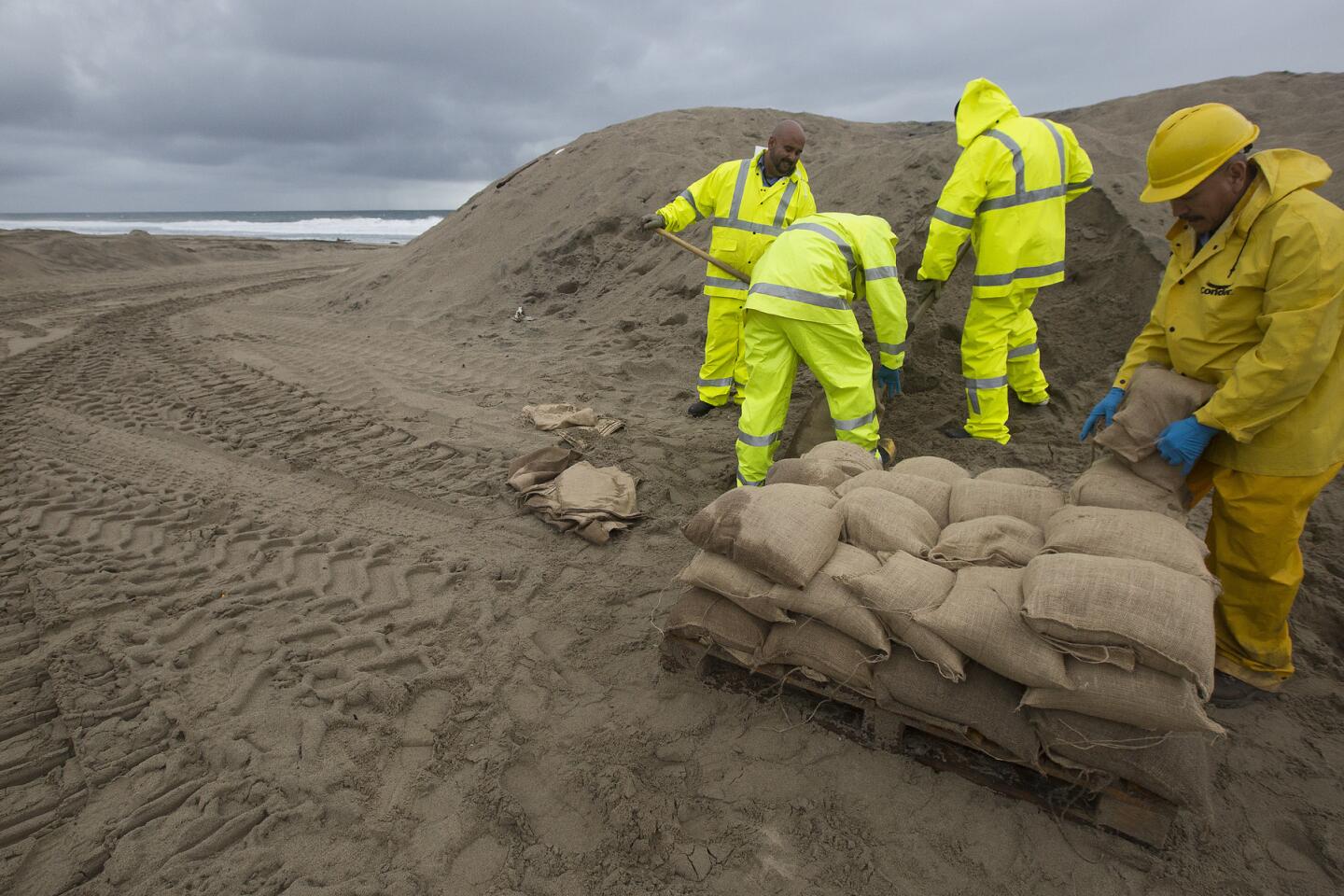
A crew with the Los Angeles County Department of Beaches and Harbors bags sand along Zuma Beach.
(Brian van der Brug / Los Angeles Times)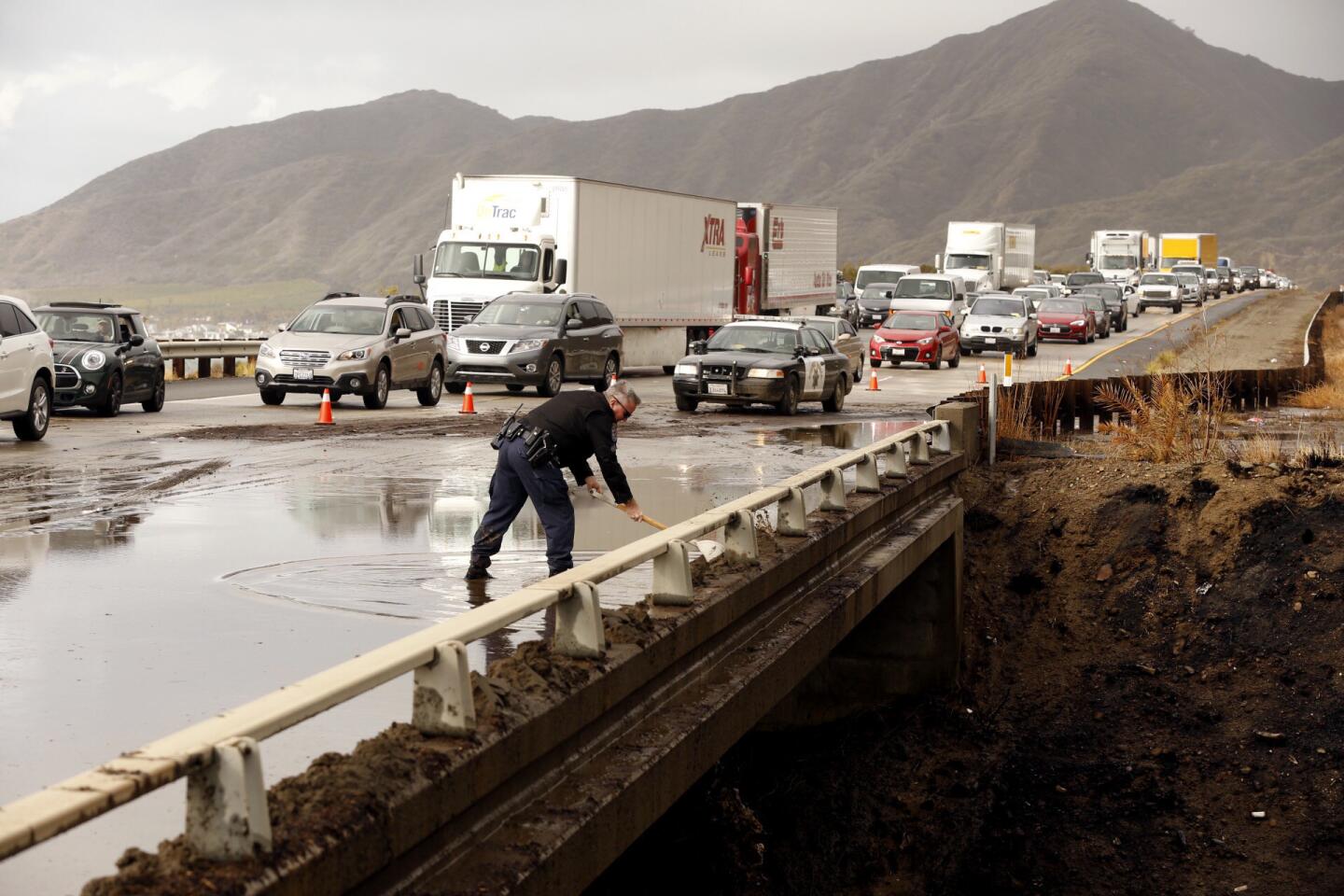
CHP Sgt. Joe Davy uses a shovel to try to clear a drain on the southbound lanes of the 101 Freeway of mud from the recent Solimar Fire runoff that flowed over the freeway, closing lanes.
(Al Seib / Los Angeles Times)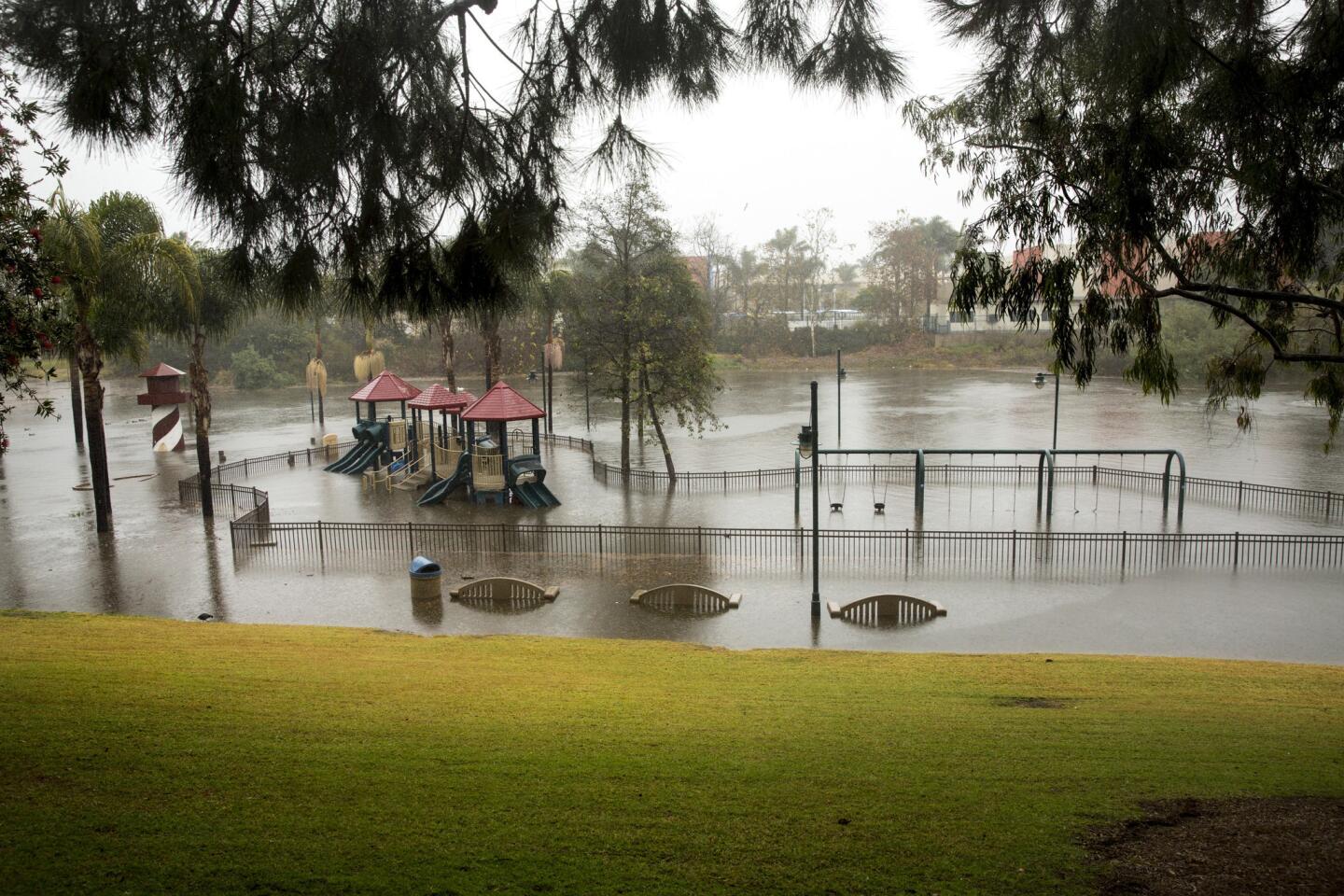
Polliwog Park in Manhattan Beach is deserted and flooded, as a storm descended over southern California.
(Jay L. Clendenin / Los Angeles Times)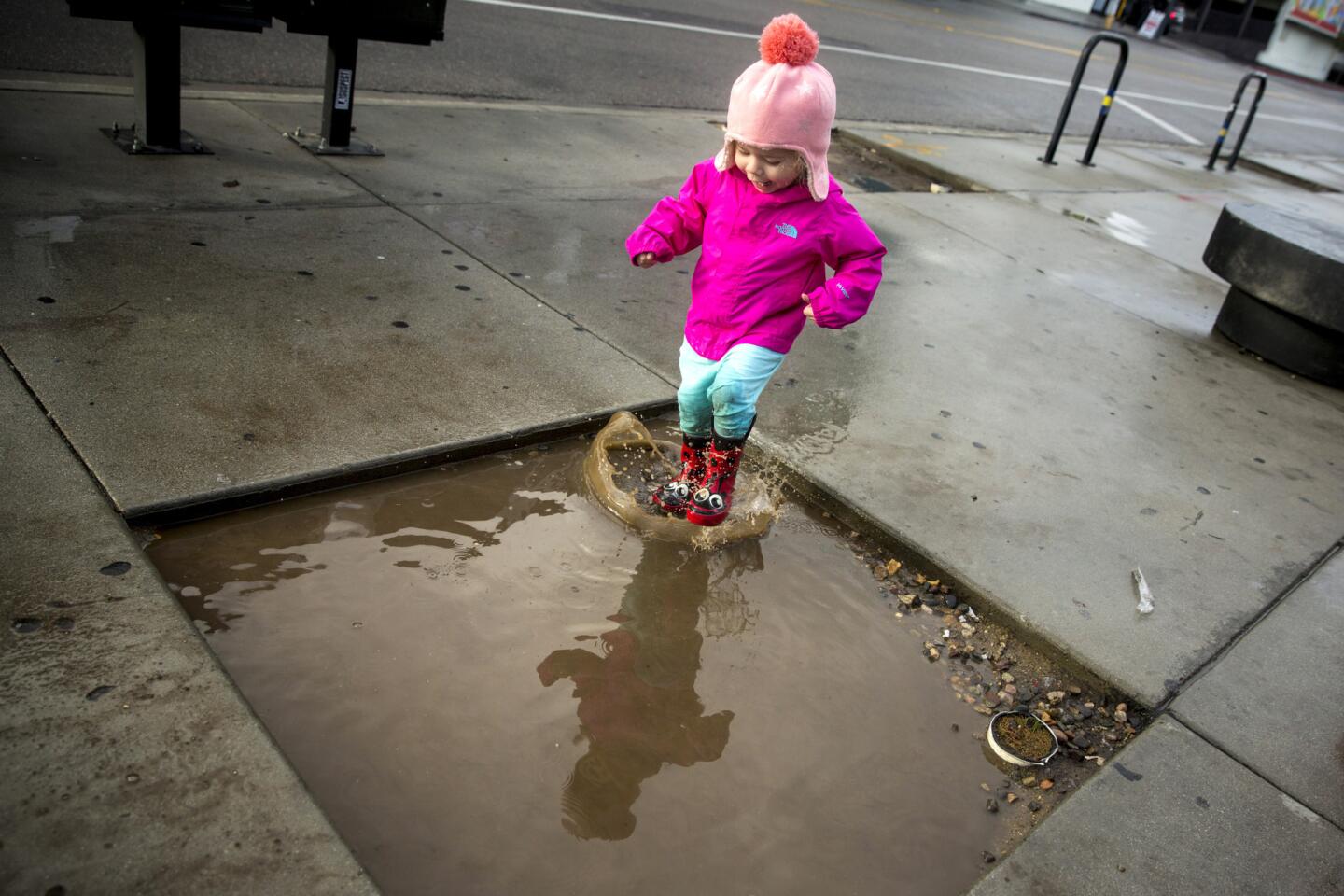
Valentina Flores,2, of City of Commerce, enjoys a puddle in the Little Tokyo area of downtown Los Angeles, Calif.
(Jay L. Clendenin / Los Angeles Times)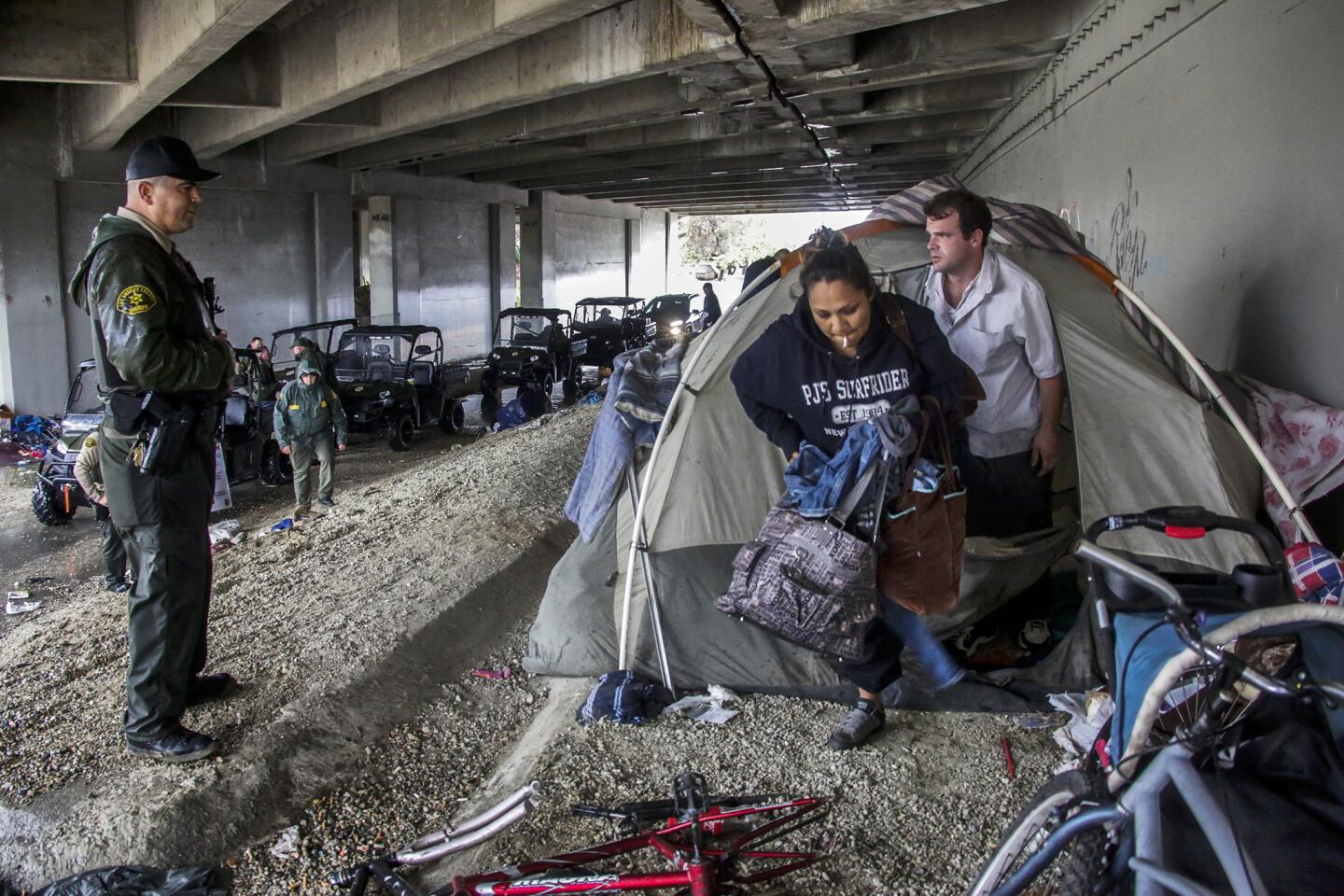
Los Angeles sheriff deputy Michael Galvan, left, warns a couple living under Freeway 5 about flooding danger along the San Gabriel River.
(Irfan Khan / Los Angeles Times)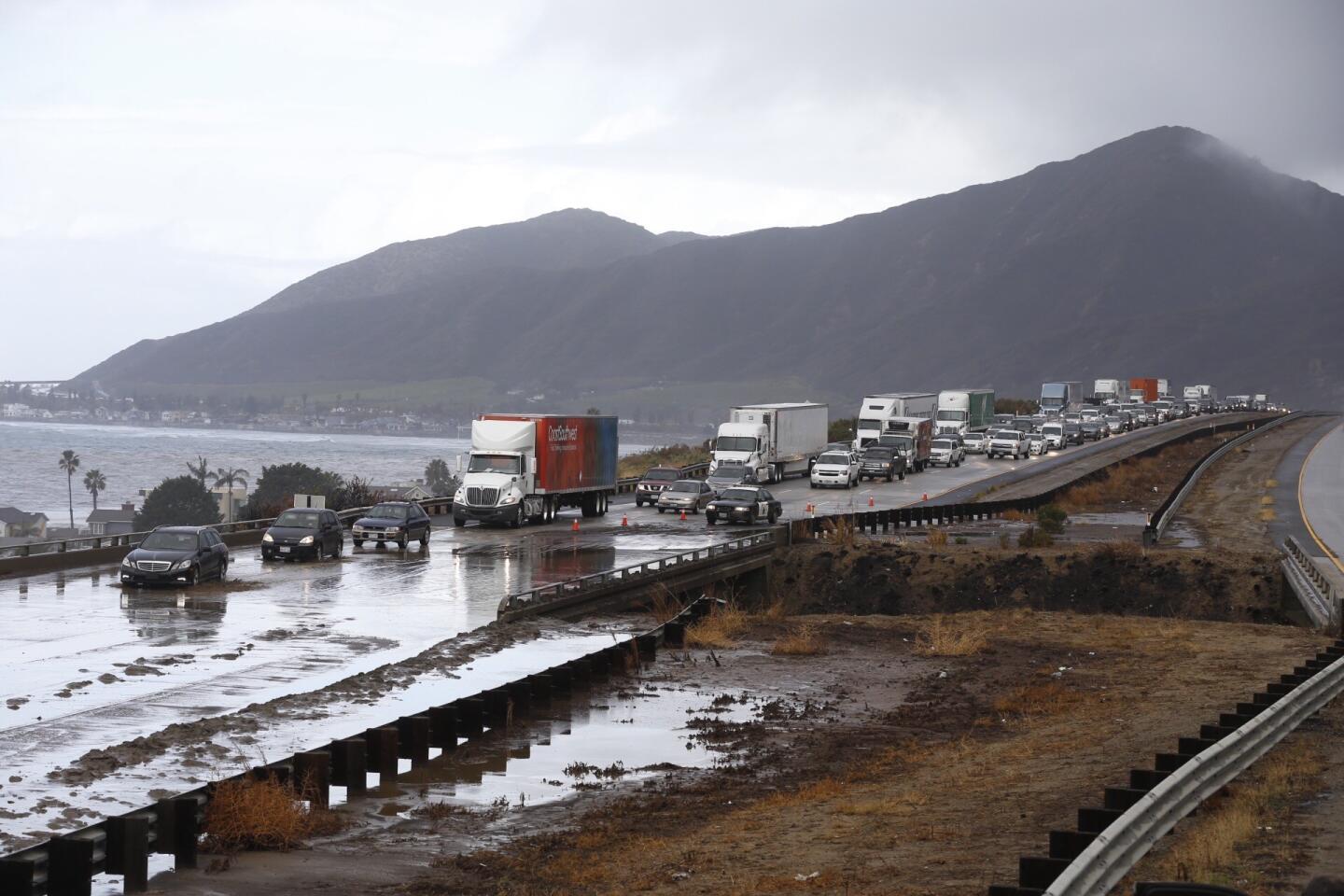
Vehicles traveling in the southbound lanes of the 101 freeway crawl through one lane after mud from the recent Solimar Fire flowed over the freeway closing lanes.
(Al Seib / Los Angeles Times)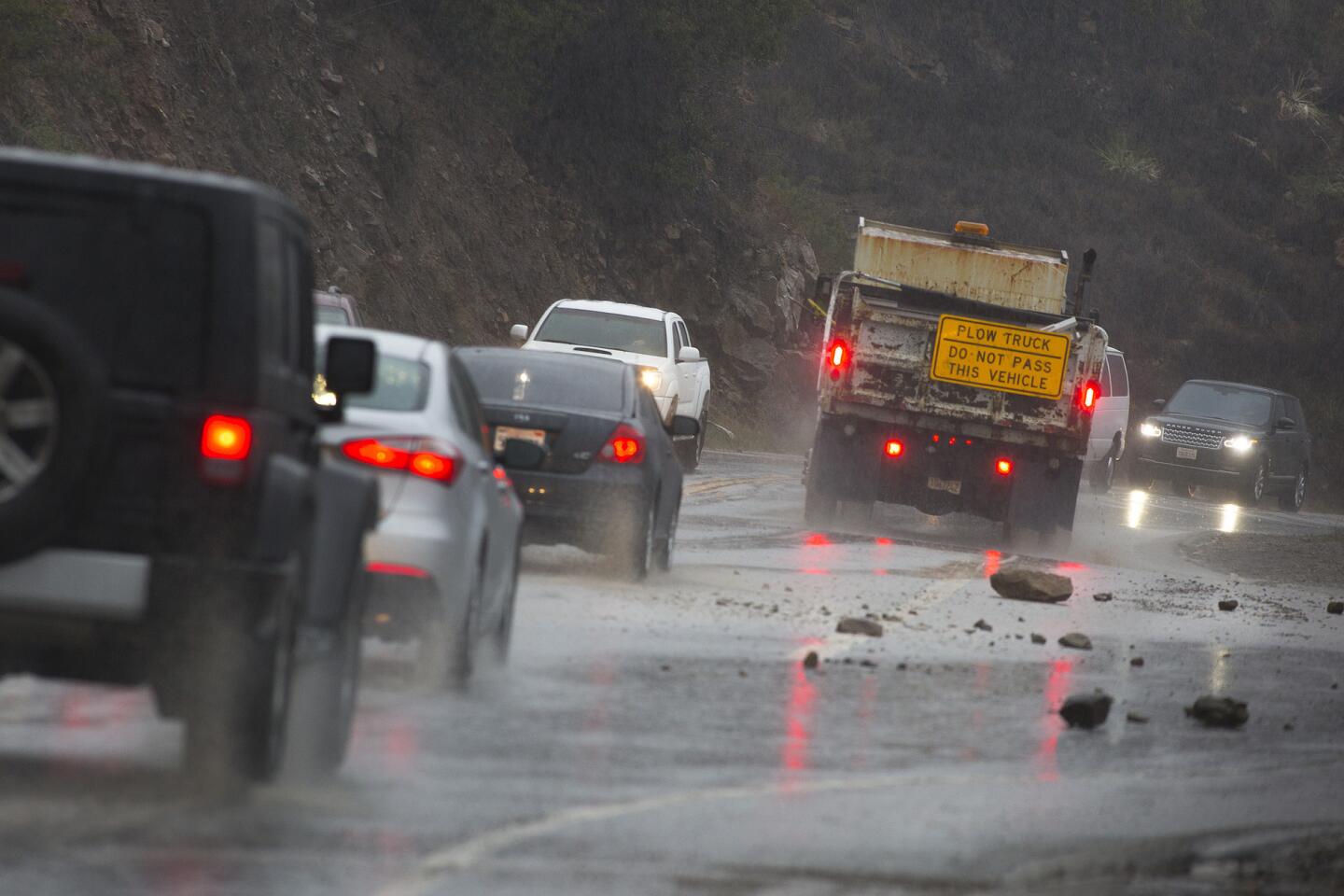
Los Angeles County Public Works road plow removes rocks off a rain-inundated Malibu Canyon Road in Malibu.
(Brian van der Brug / Los Angeles Times)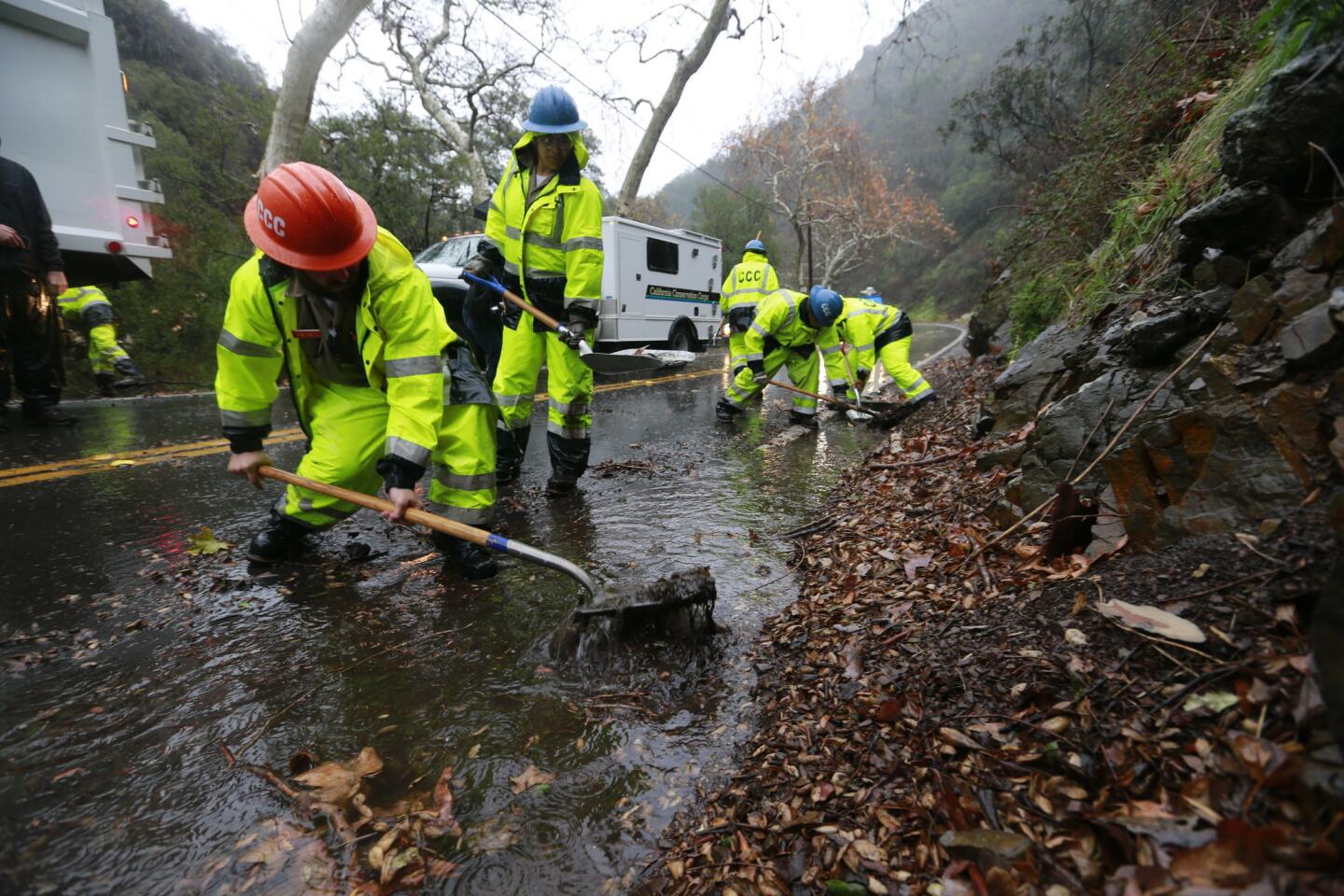
Members of the California Conservation Corps clear drains along Silverado Canyon Road in Orange County, Calif.
(Allen J. Schaben / Los Angeles Times)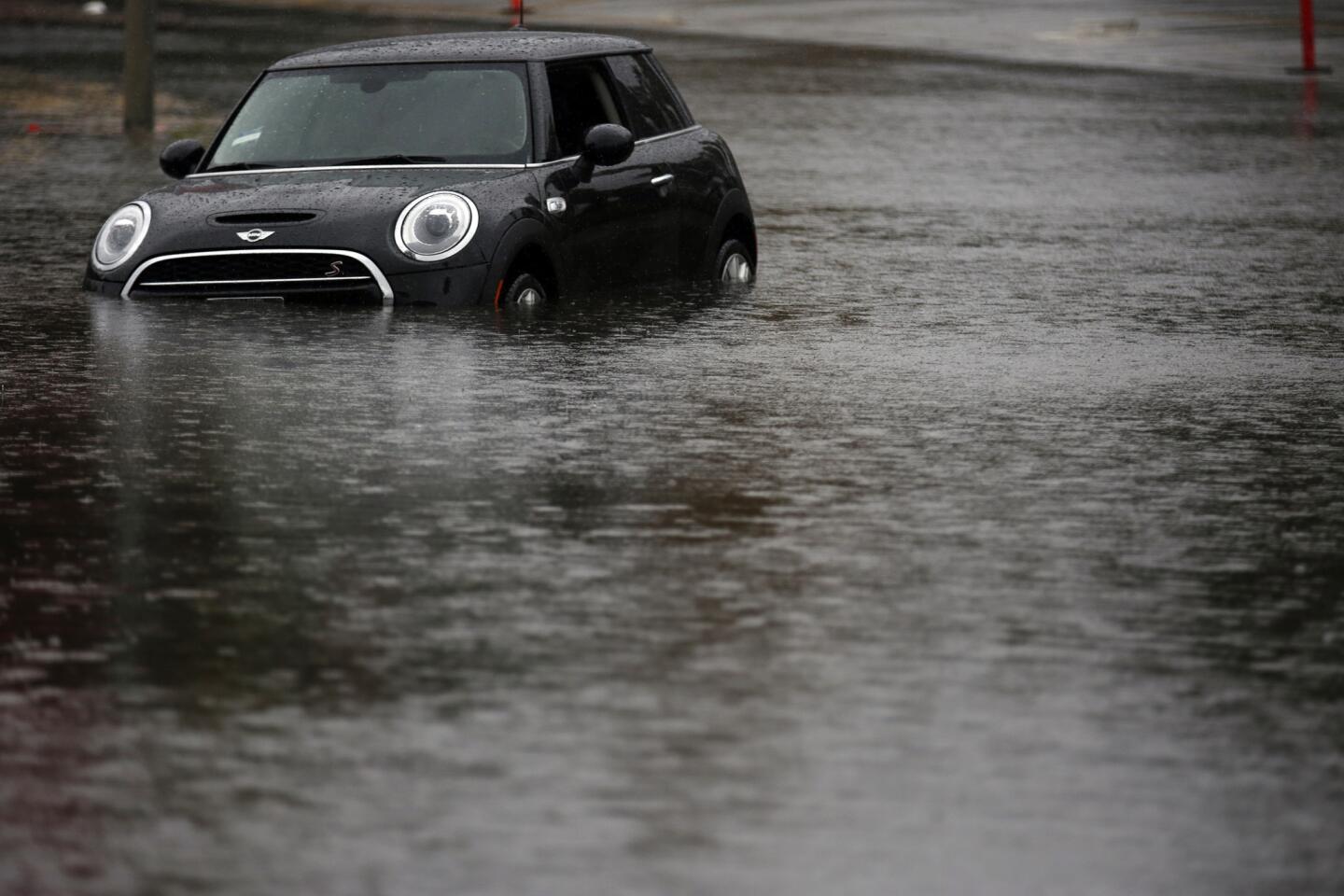
A black Mini Cooper is stranded in high standing water on Burbank Blvd near Balboa Golf Course in Encino.
(Francine Orr / Los Angeles Times)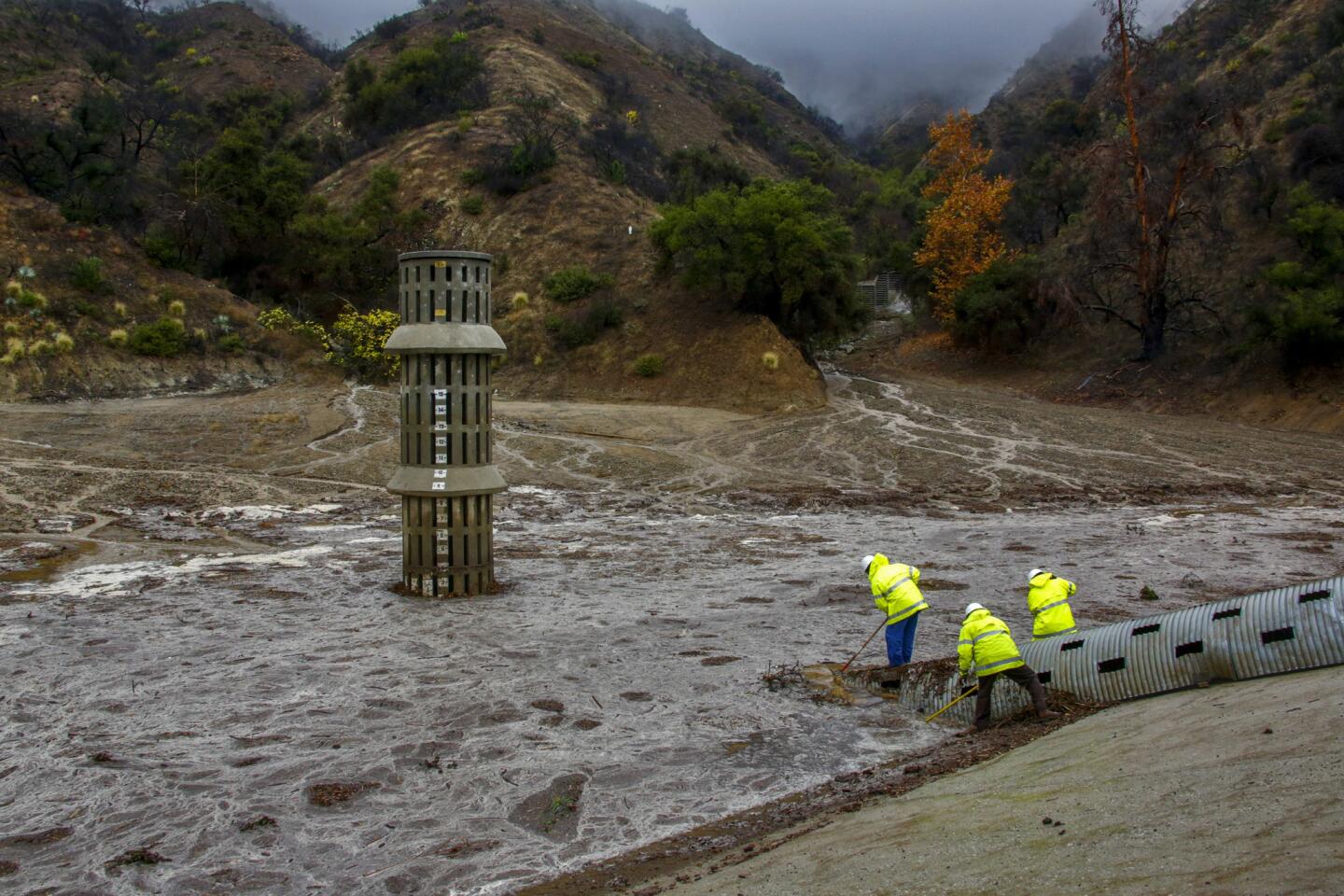
Los Angeles county public works department workers clean an outlet drain at Easley Canyon debris basin in Glendora.
(Irfan Khan / Los Angeles Times)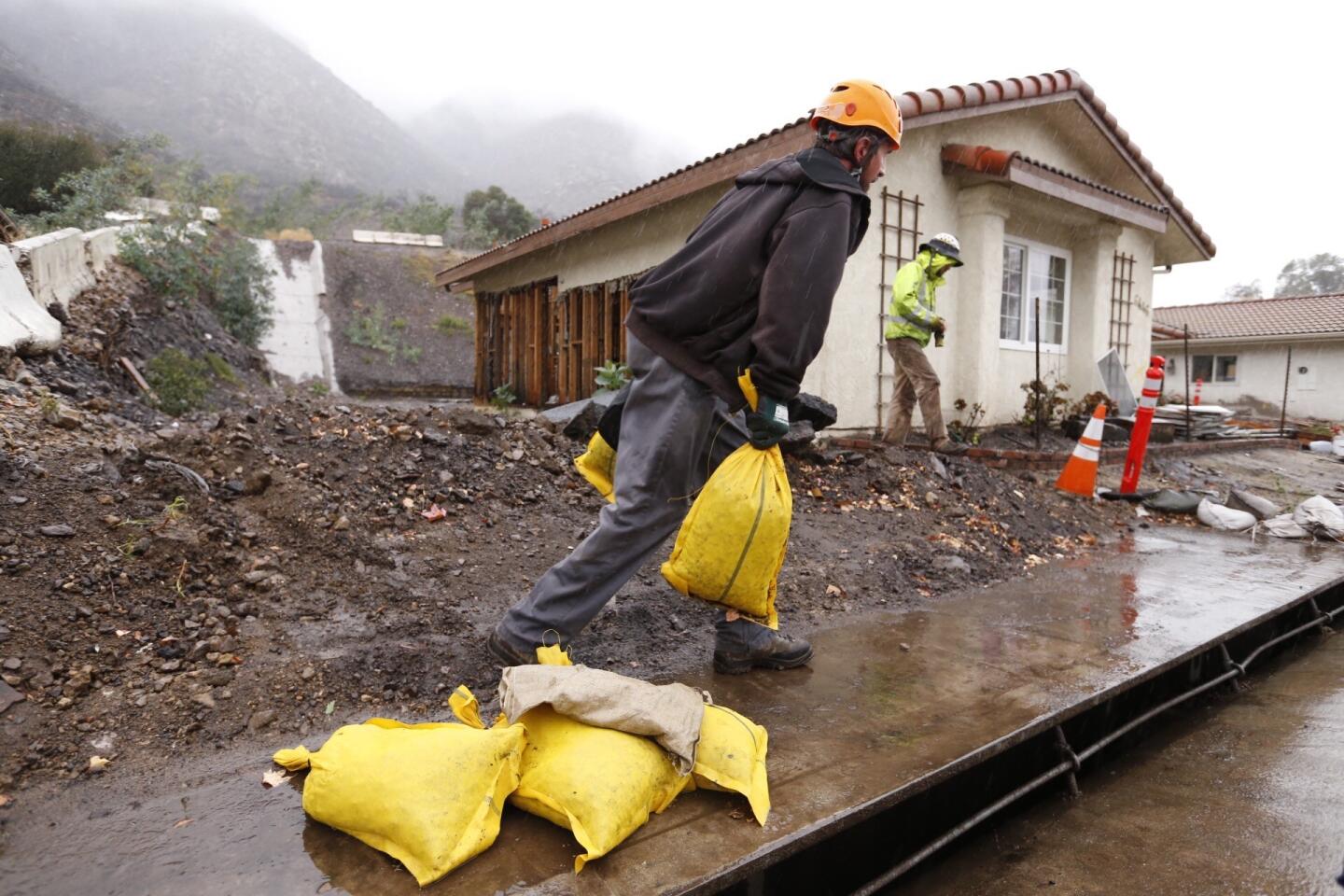
Jason Rivas works with sandbags in front of homes along San Como Lane in Camarillo Springs. Residents are under a voluntary evacuation order.
(Al Seib / Los Angeles Times)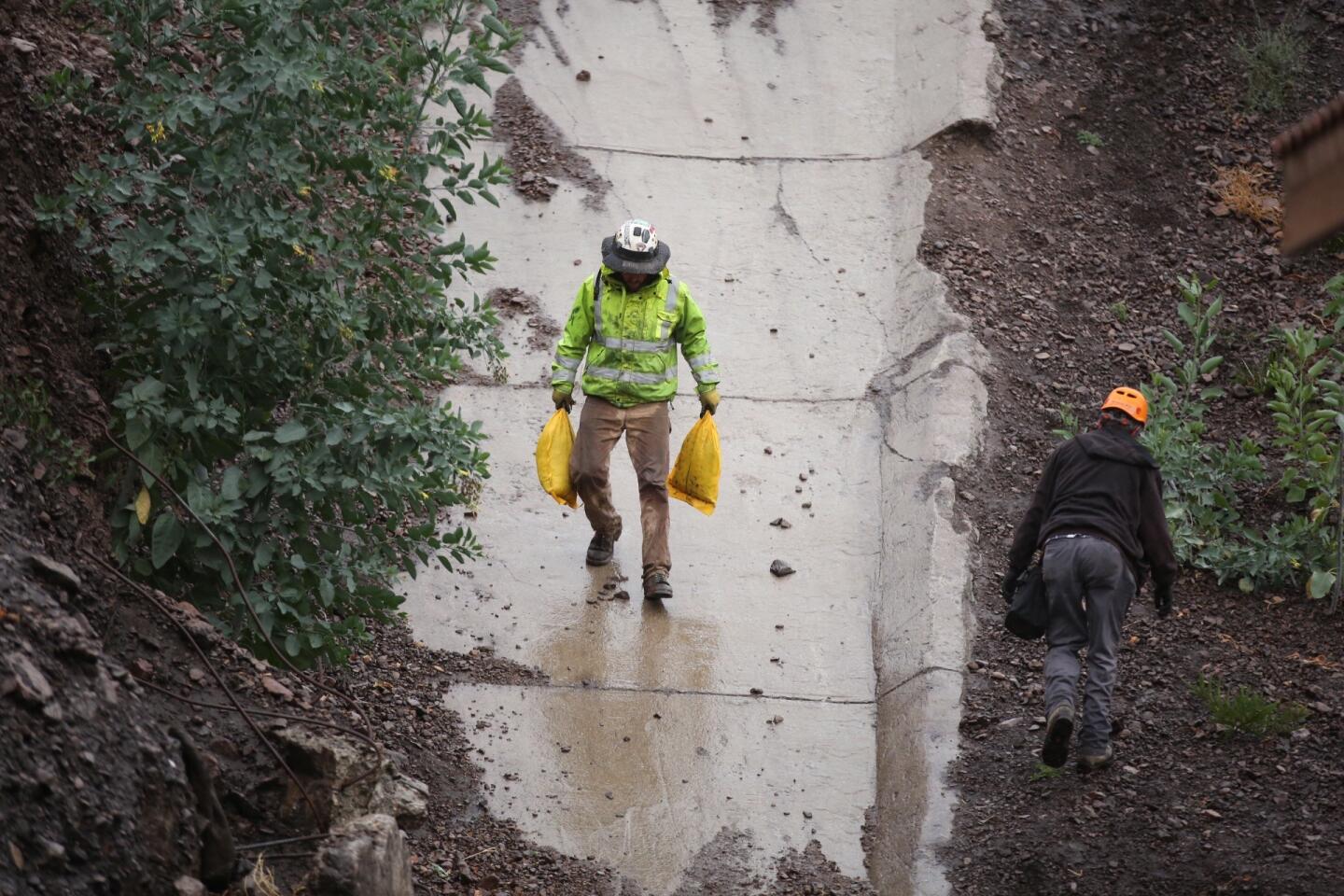
Joe Milos works with sandbags at homes along San Como Lane in Camarillo Springs as light showers fall.
(Al Seib / Los Angeles Times)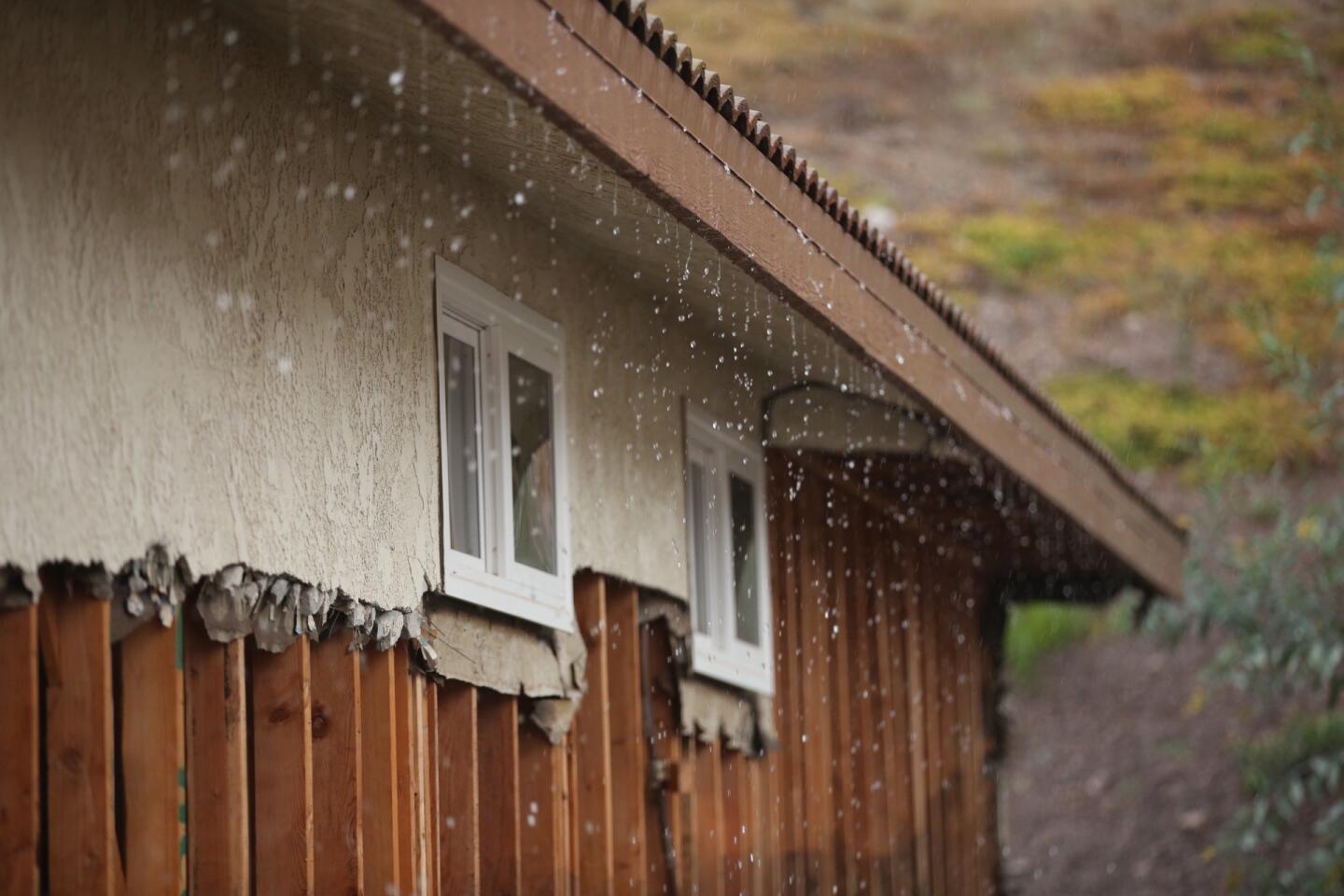
Rain water runs off the roof of red tagged homes along San Como Lane in Camarillo Springs Tuesday morning.
(Al Seib / Los Angeles Times)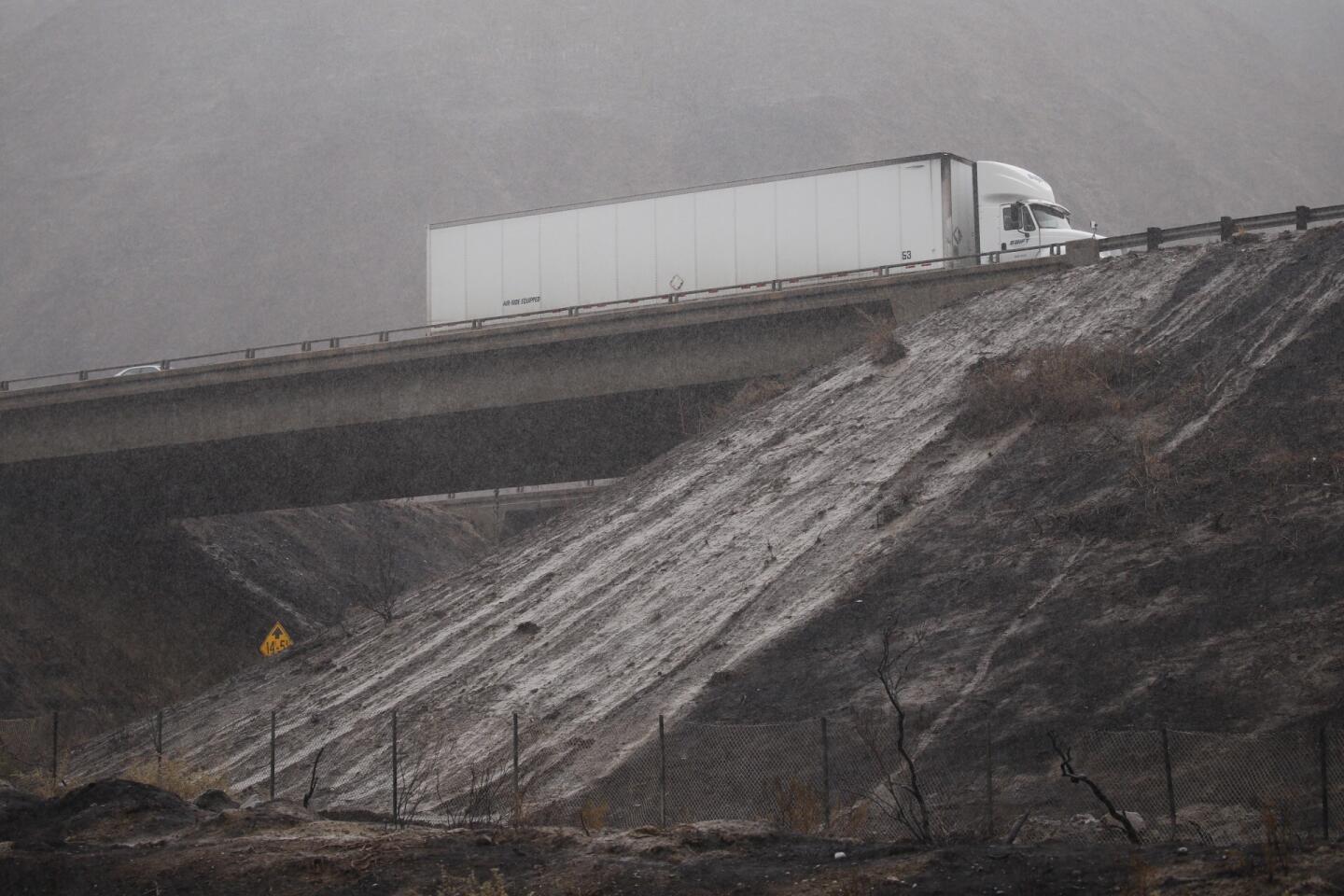
Vehicles are slowed for miles on both North and South bound lanes of the 101 Freeway at Solimar Beach in western Ventura County as mud from the recent Solimar fire covers all lanes Tuesday morning.
(Al Seib / Los Angeles Times)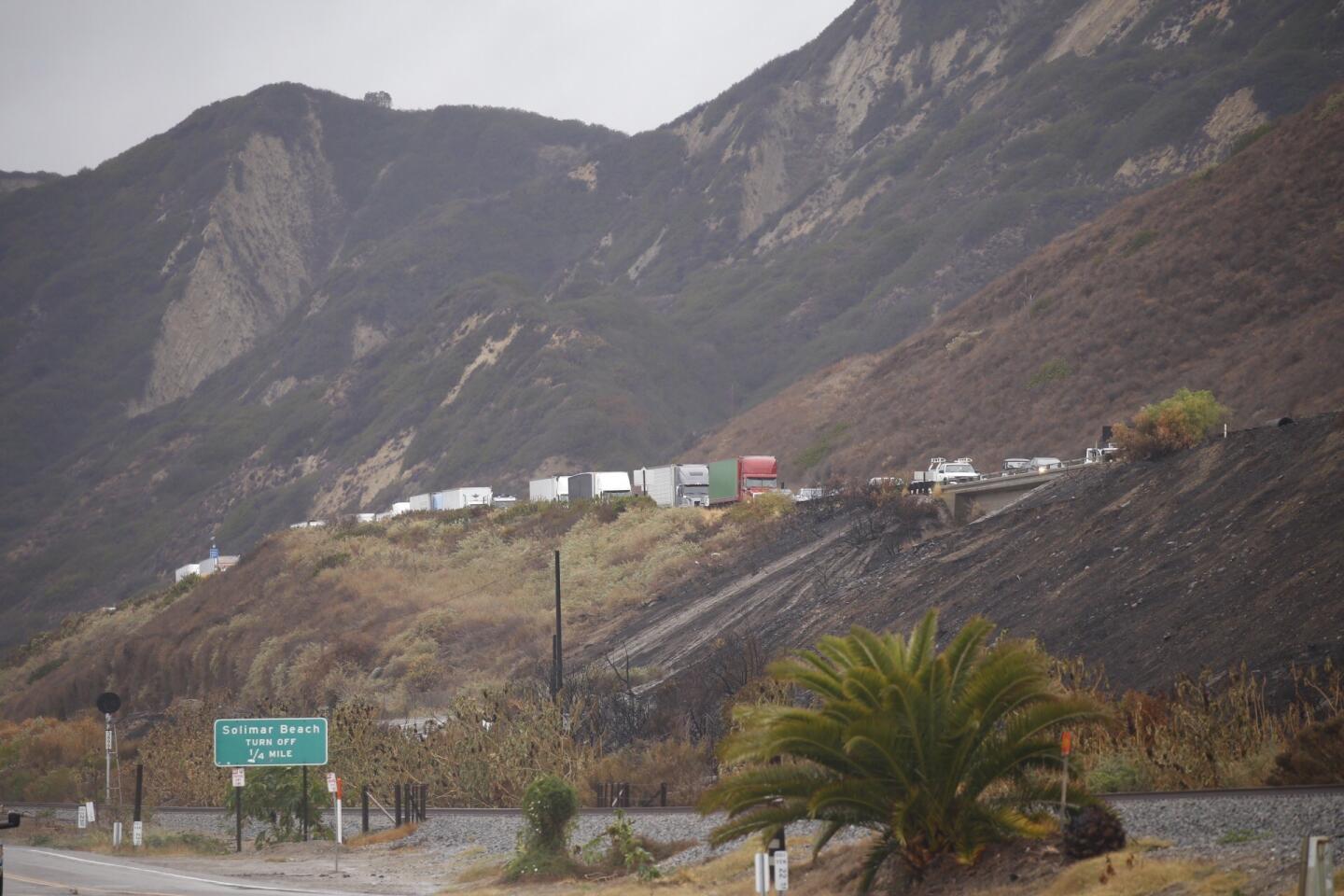
Looking North, as vehicles are slowed for miles on both directions of the 101 Freeway at Solimar Beach in western Ventura County as mud from the recent Solimar fire covers all lanes.
(Al Seib / Los Angeles Times)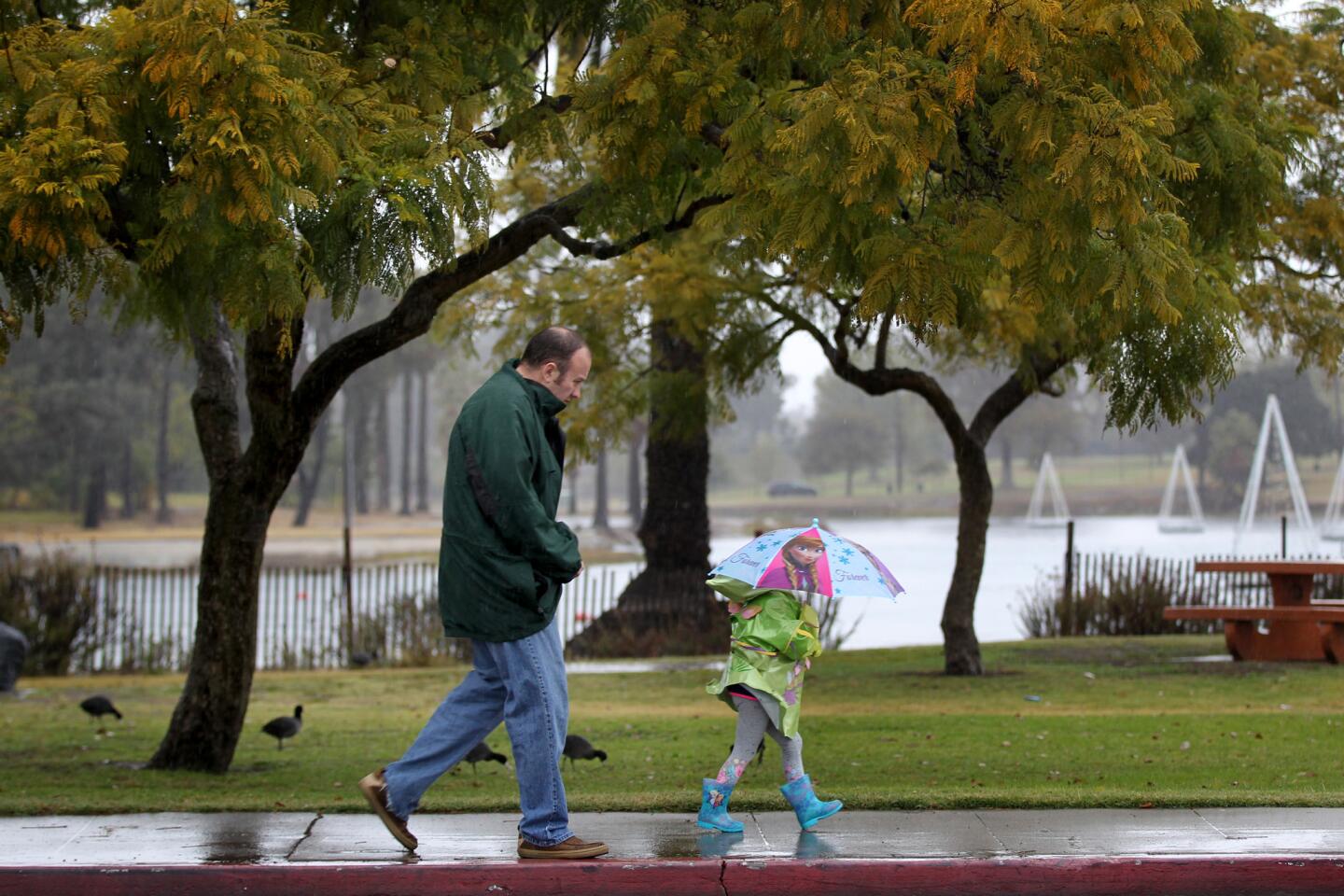
People in Long Beach deal with rainy weather during the first strong storm in what is predicted to be a strong El Nino event in Southern California.
(Rick Loomis / Los Angeles Times)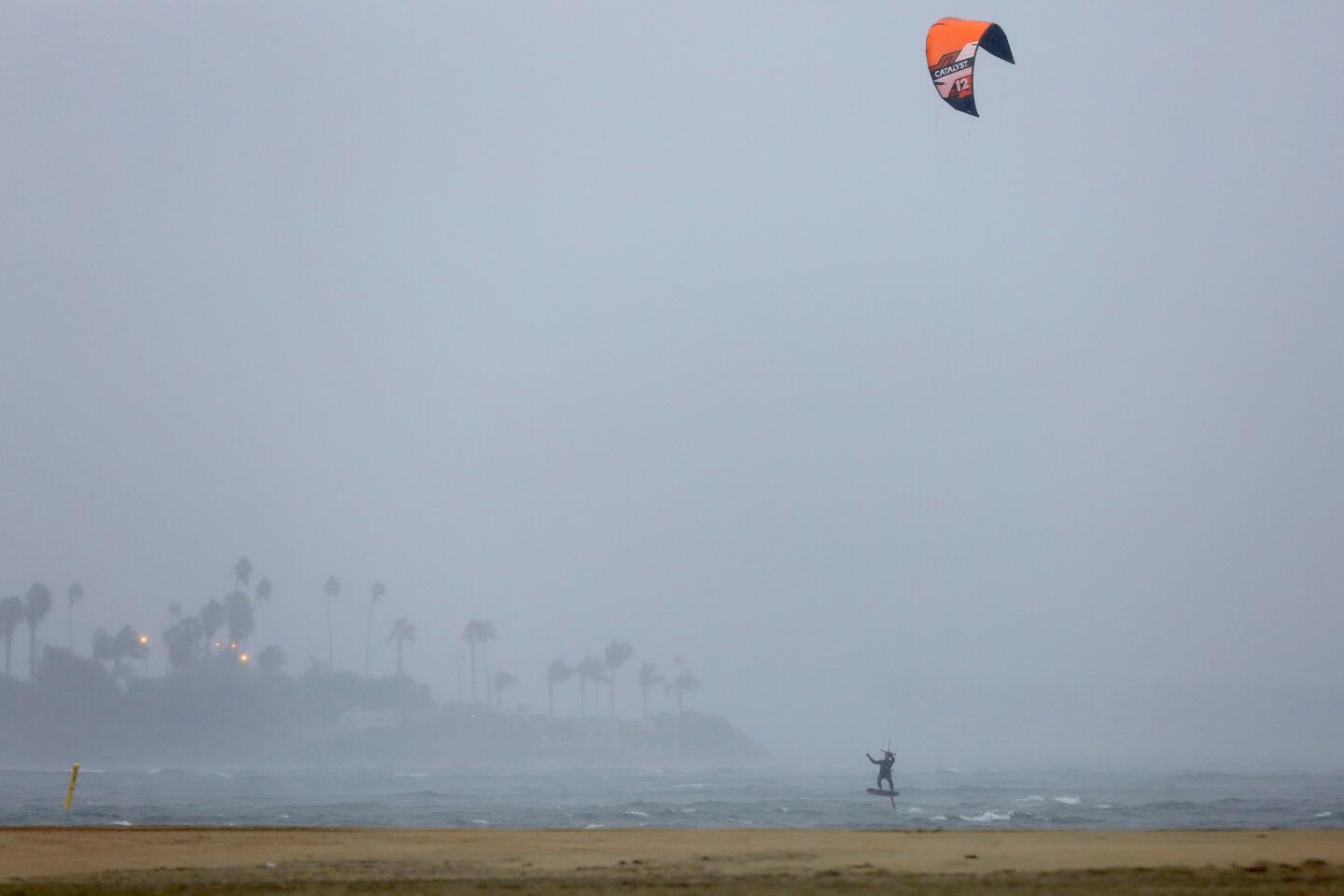
A kite surfer in Long Beach makes use of the wind during the rainy weather brought by the first big storm of the new year.
(Rick Loomis / Los Angeles Times)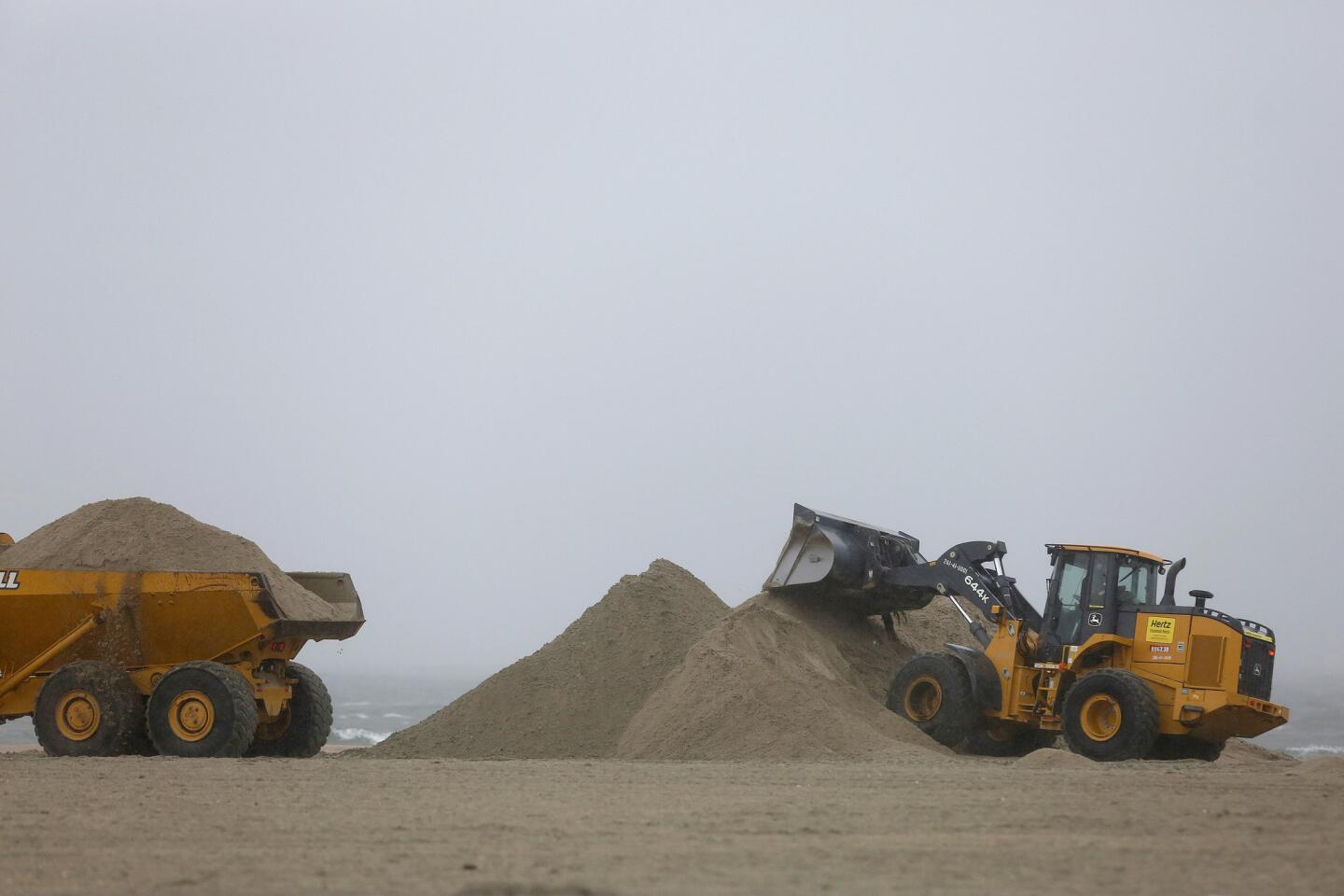
A front-end loader and dump truck work to move beach sand to protect vulnerable areas from flooding in Long Beach.
(Rick Loomis / Los Angeles Times)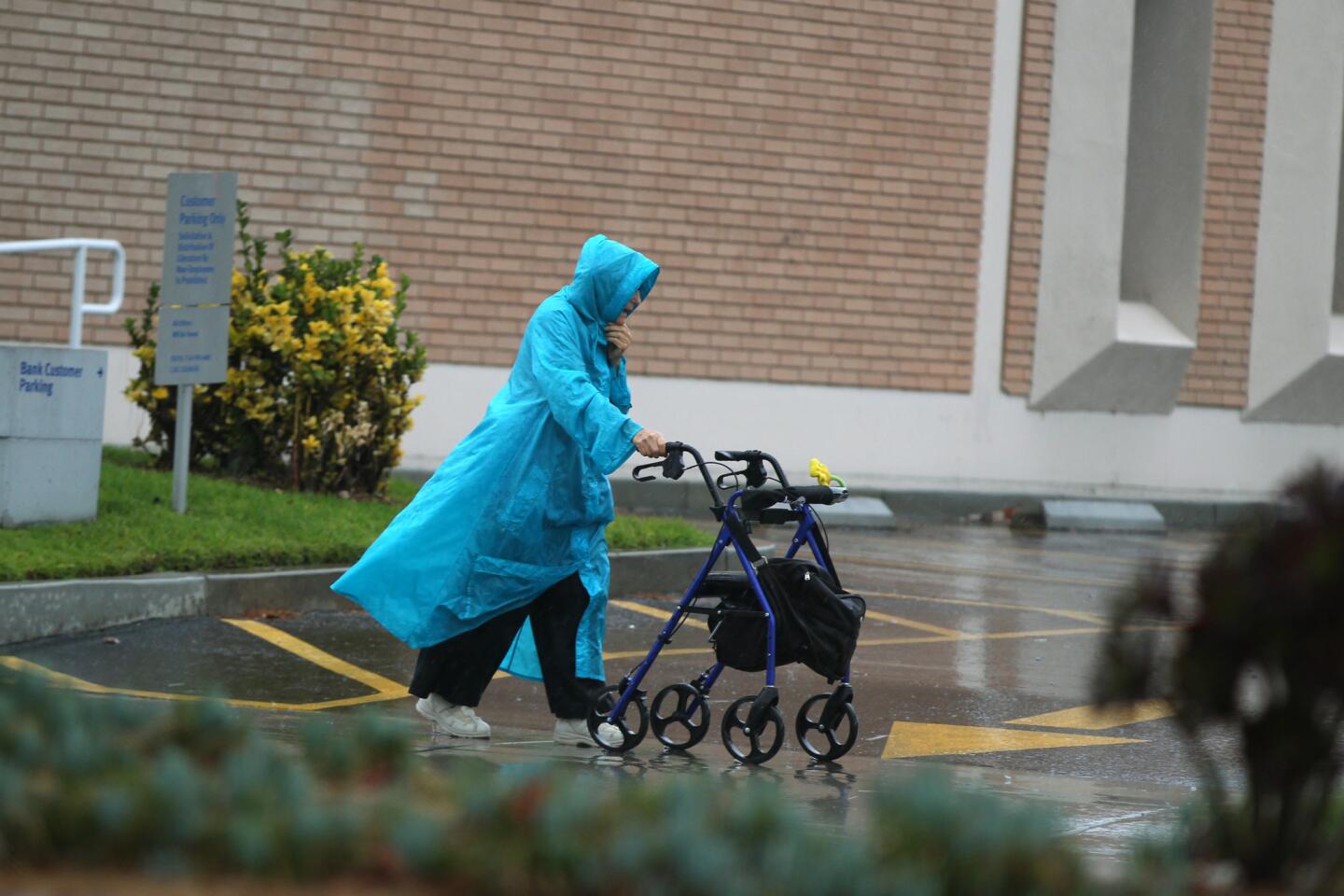
An elderly woman navigates a wet parking lot in Fountain Valley as storms were expected to barrel into Southern California in earnest Tuesday morning.
(Allen J. Schaben / Los Angeles Times)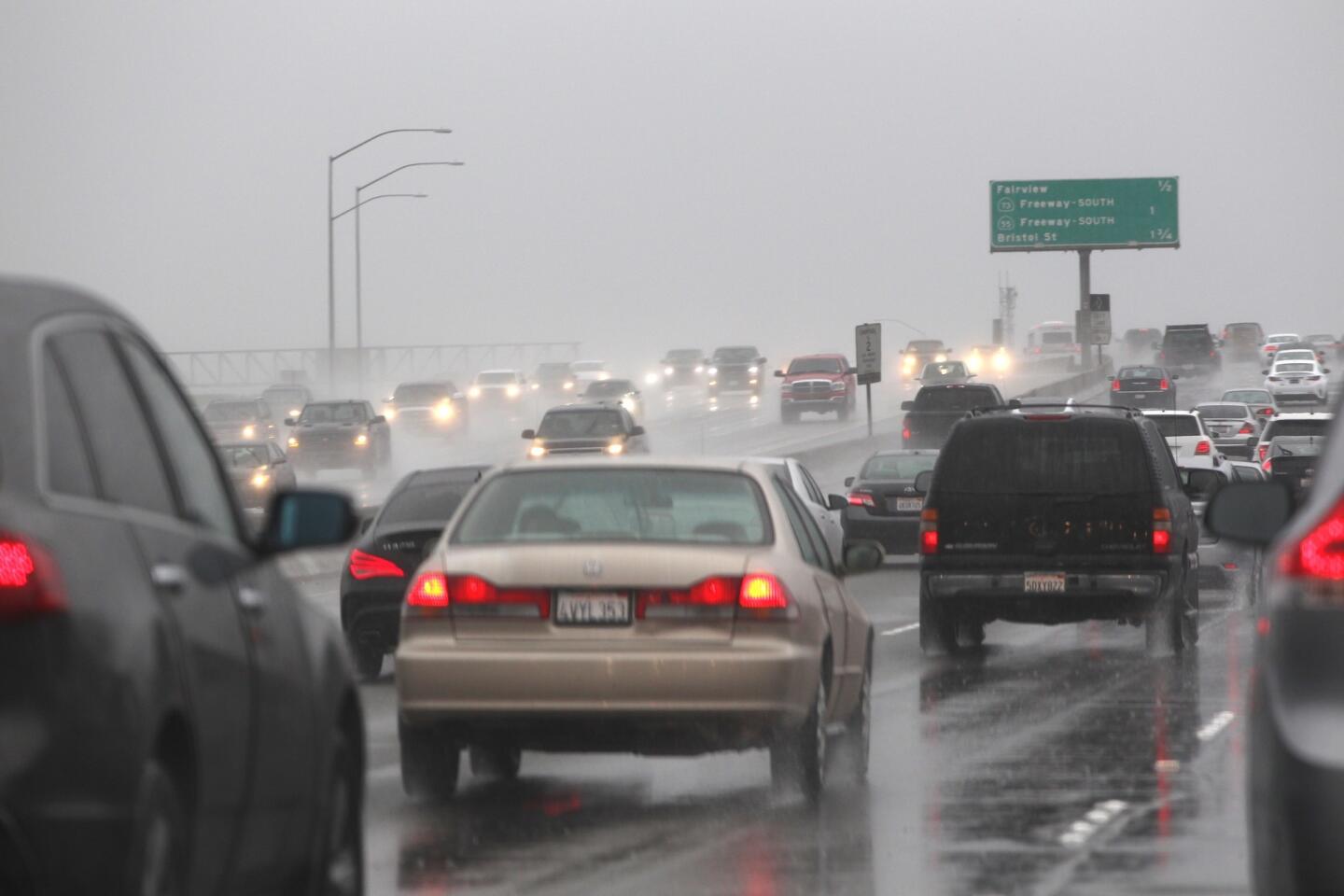
Commuters navigate the southbound 405 Freeway in Costa Mesa. Rain is expected to continue through the end of the week.
(Allen J. Schaben / Los Angeles Times)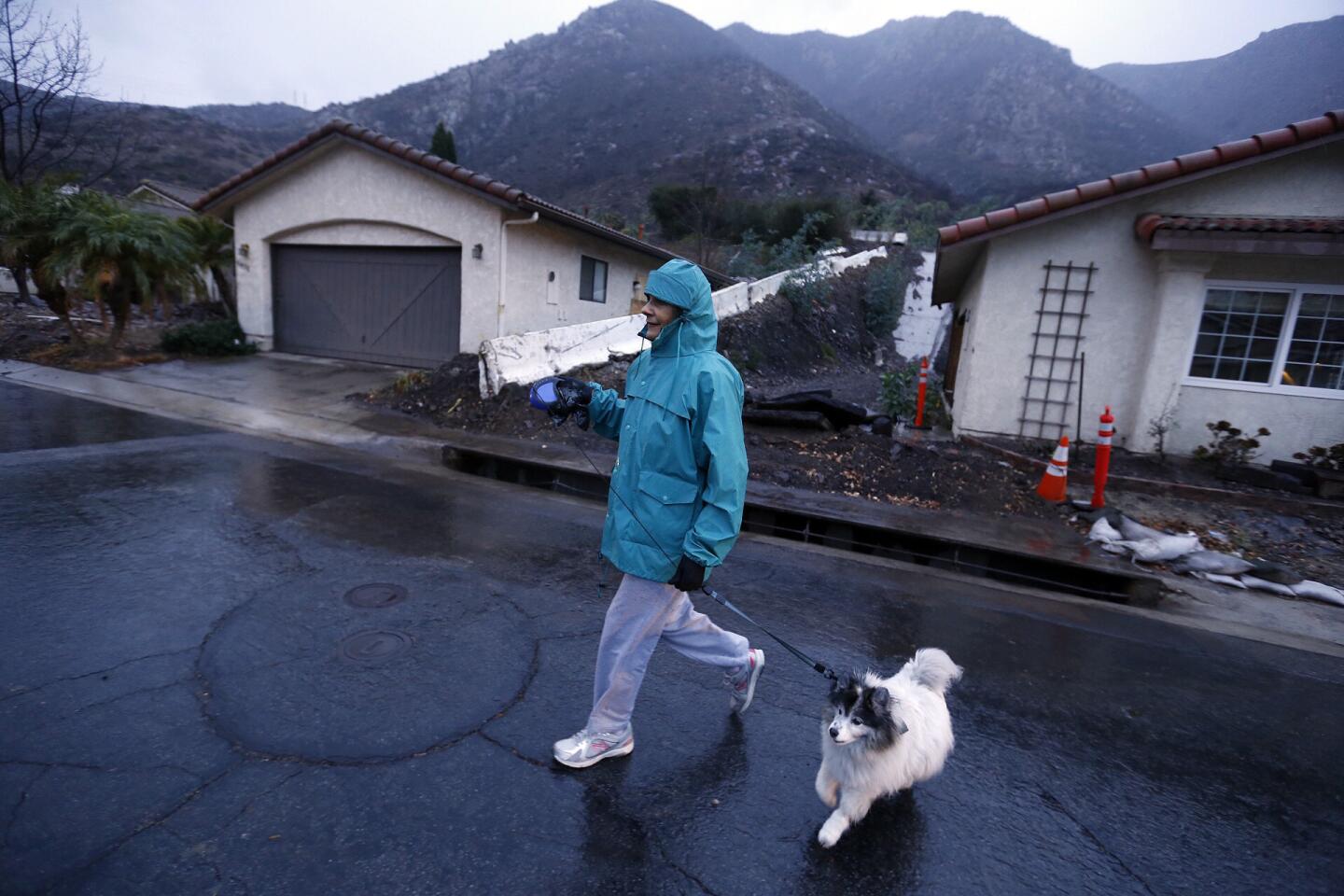
Carol Roberts, who said she has lived in Camarillo Springs for over 20 years, walks her dog Kayla past red-tagged homes along San Como Lane where residents were under a voluntary evacuation order due to approaching storms and unstable soil conditions.
(Al Seib / Los Angeles Times)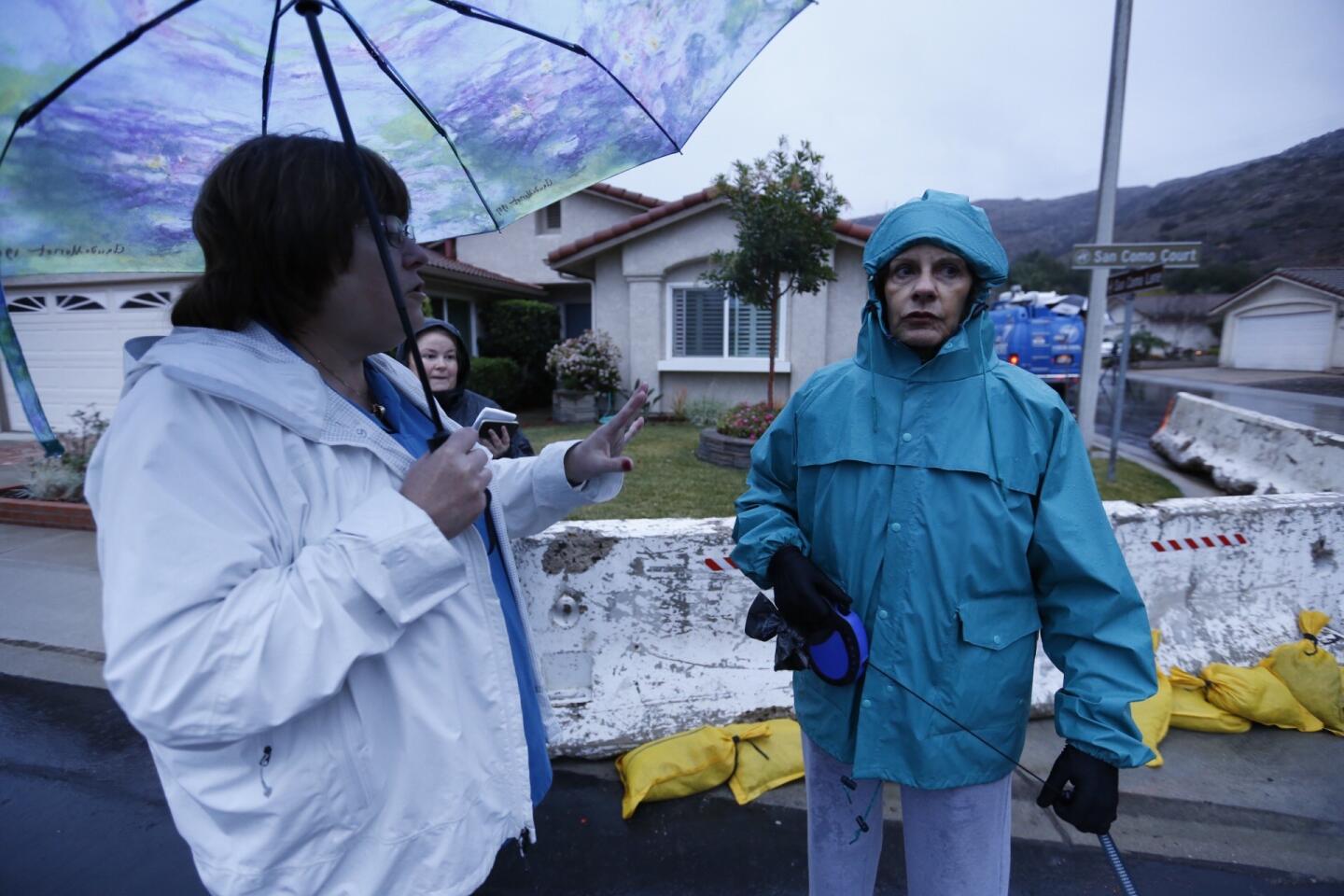
Homeowners association president Barbara Williams, left, counsels Carol Roberts to be ready to leave the neighborhood if mandatory evacuations are ordered.
(Al Seib / Los Angeles Times)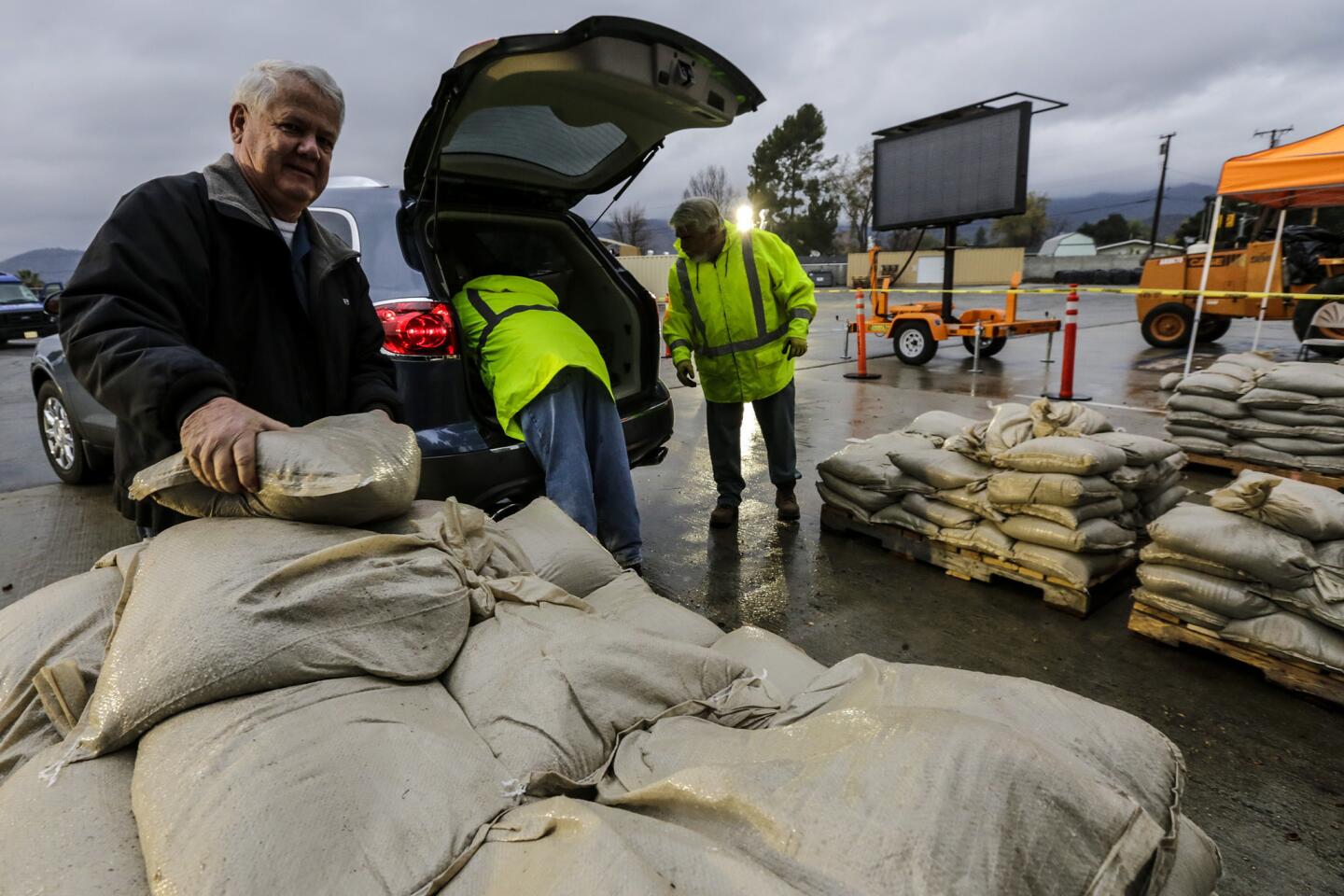
Glendale resident Linn Neidengard picks up sandbags provided by the city to protect his home from looming rains.
(Irfan Khan / Los Angeles Times)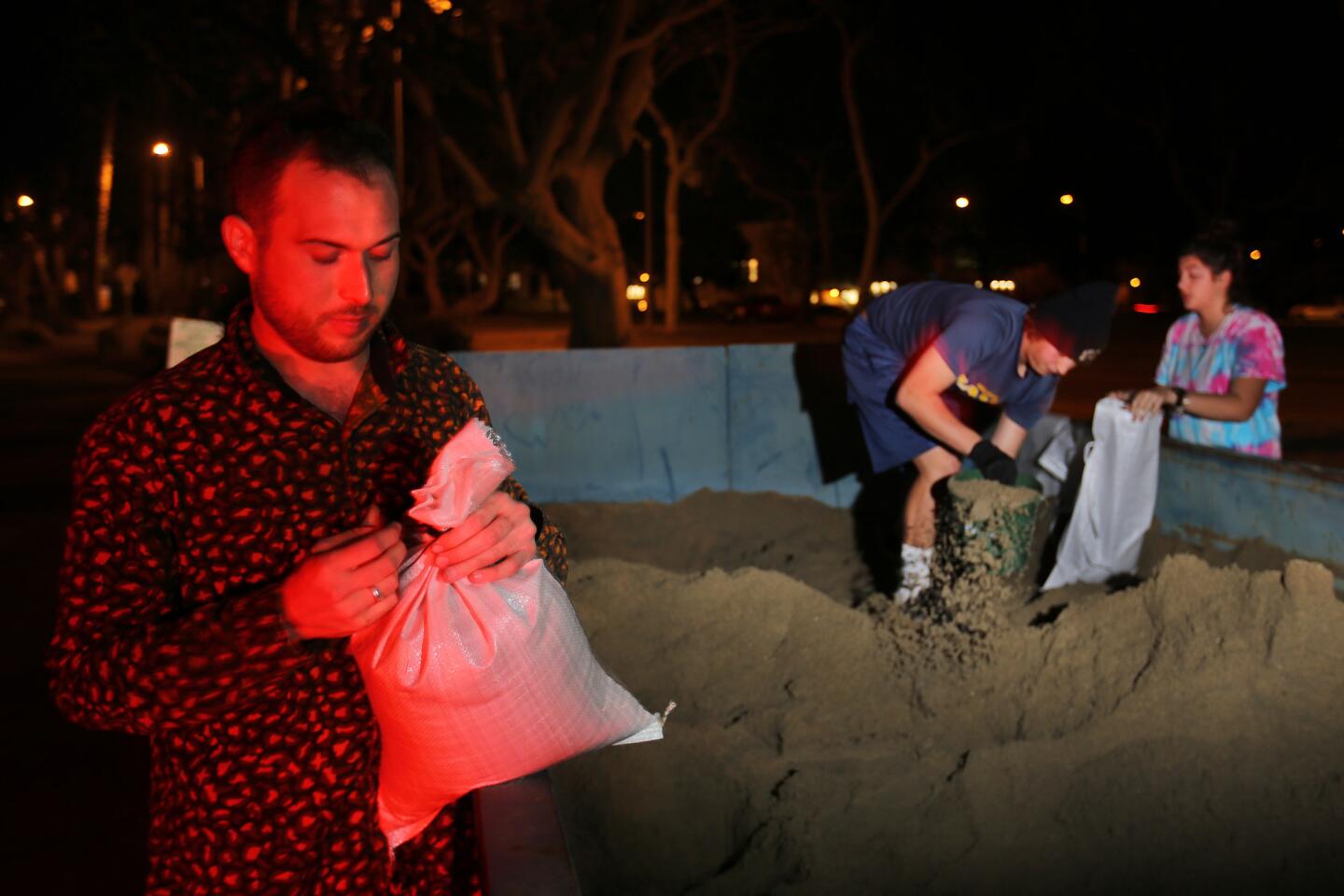
Noah Cowan of Long Beach, fills sandbags along with others as they prepare for the arrival of the first major storm of what is expected to be a strong El Niño weather event in Southern California.
(Rick Loomis / Los Angeles Times)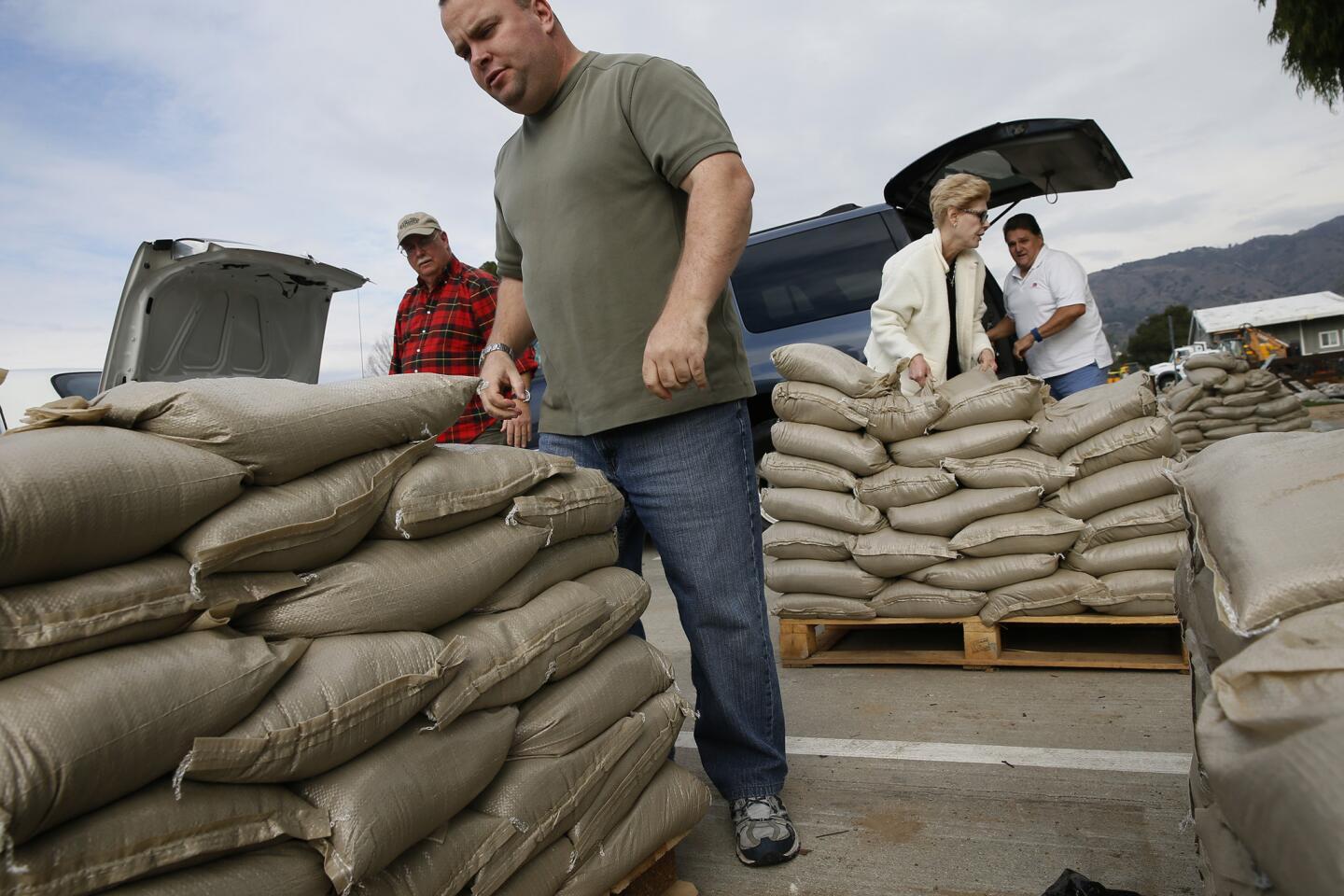
John Ward, 66, left, and his son Jacob, 37, center, load sandbags along with fellow Glendora residents ahead of heavy rains forecast this week.
(Robert Gauthier / Los Angeles Times)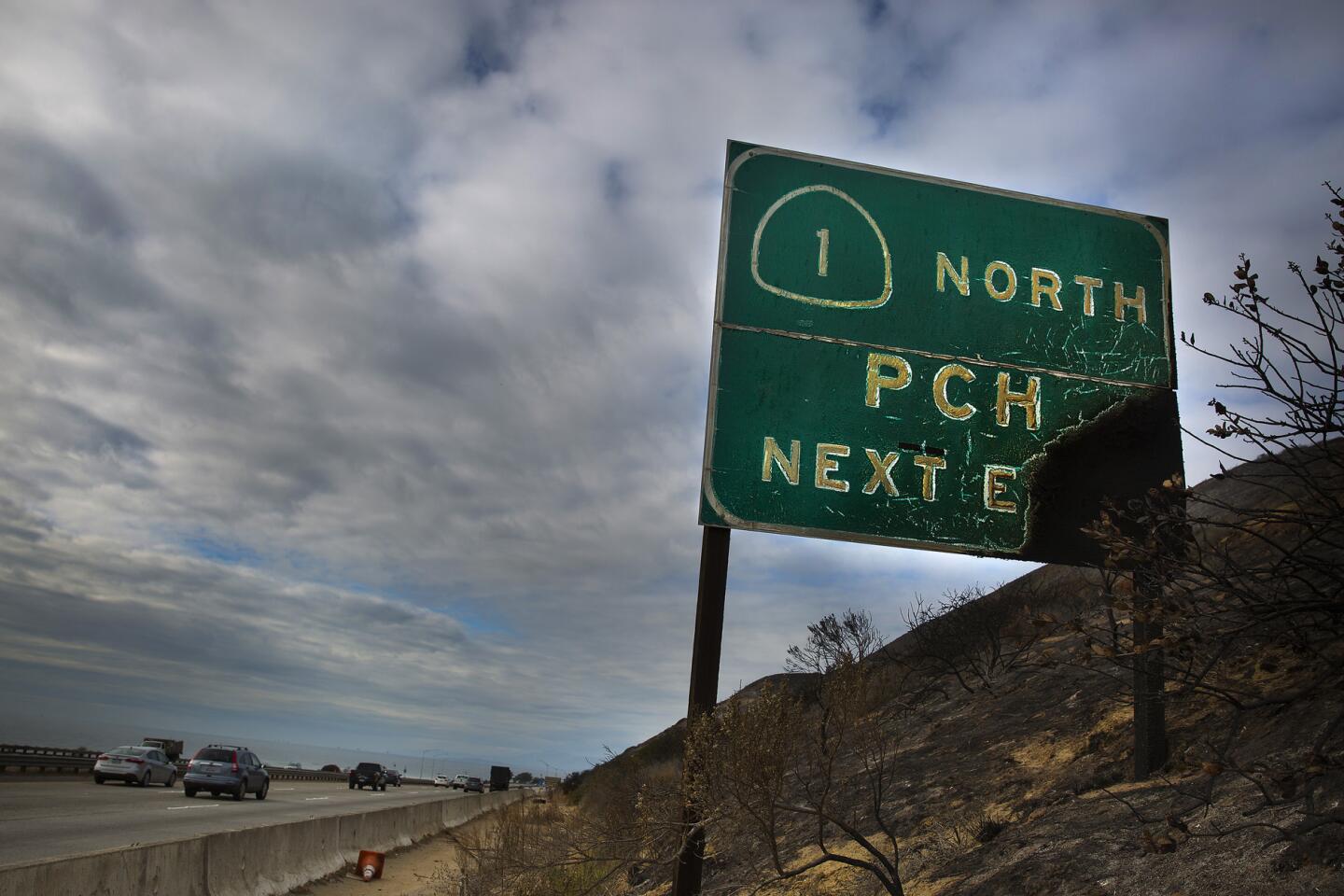
The Solimar Beach fire burn area in Ventura County is being monitored for possible mud and debris flows with the coming rain.
(Brian van der Brug / Los Angeles Times)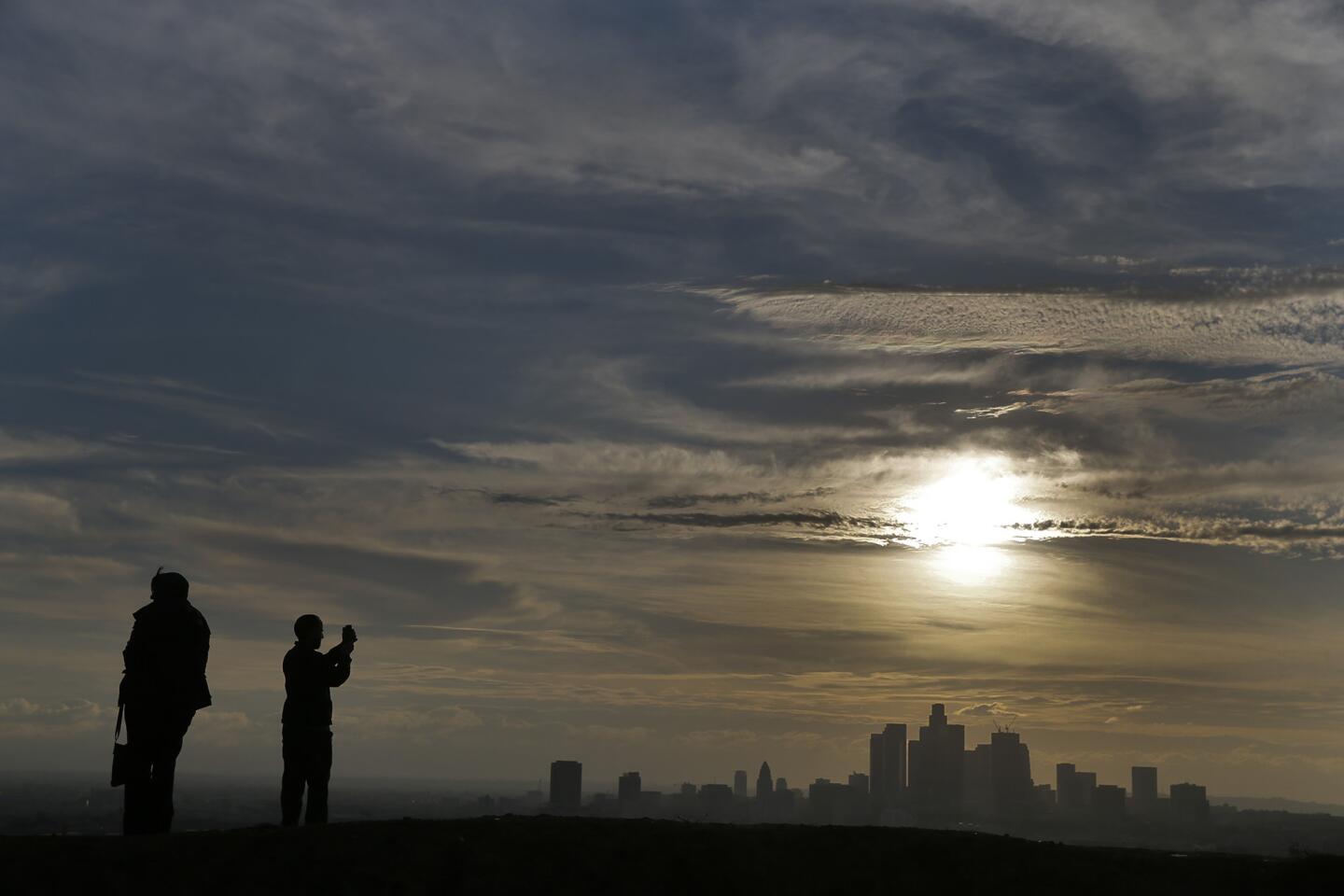
Two people take in a view of downtown Los Angeles from Montecito Heights as a storm front creeps into the Southland on Jan 3.
(Robert Gauthier / Los Angeles Times)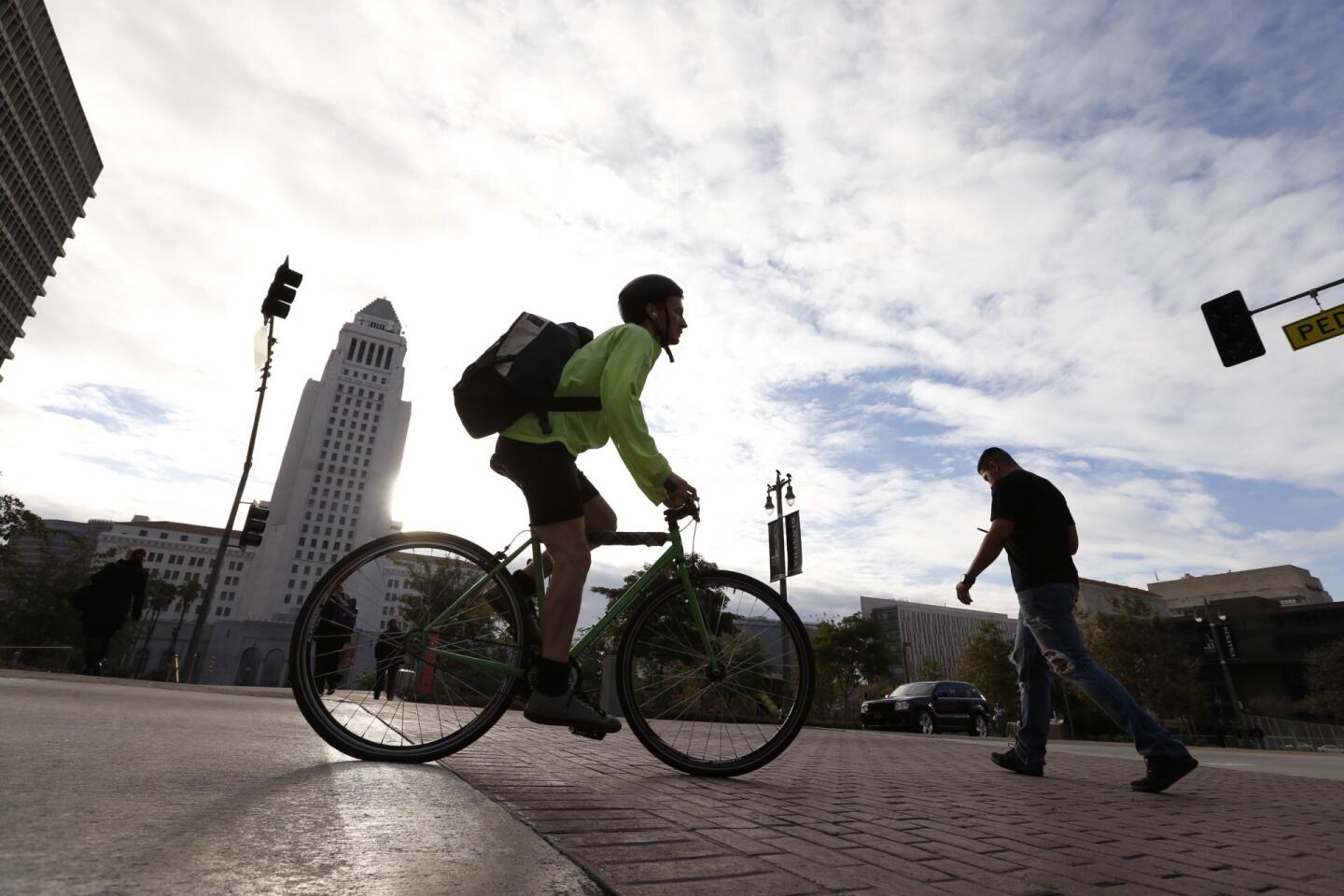
People walk and bike under blue-gray skies in downtown Los Angeles on Jan. 4 as a series of storms were forecast for Southern California.
(Al Seib / Los Angeles Times)
With rain in the forecast, Geme Gemayoa is bundled up in downtown L.A. on Jan. 4.
(Al Seib / Los Angeles Times)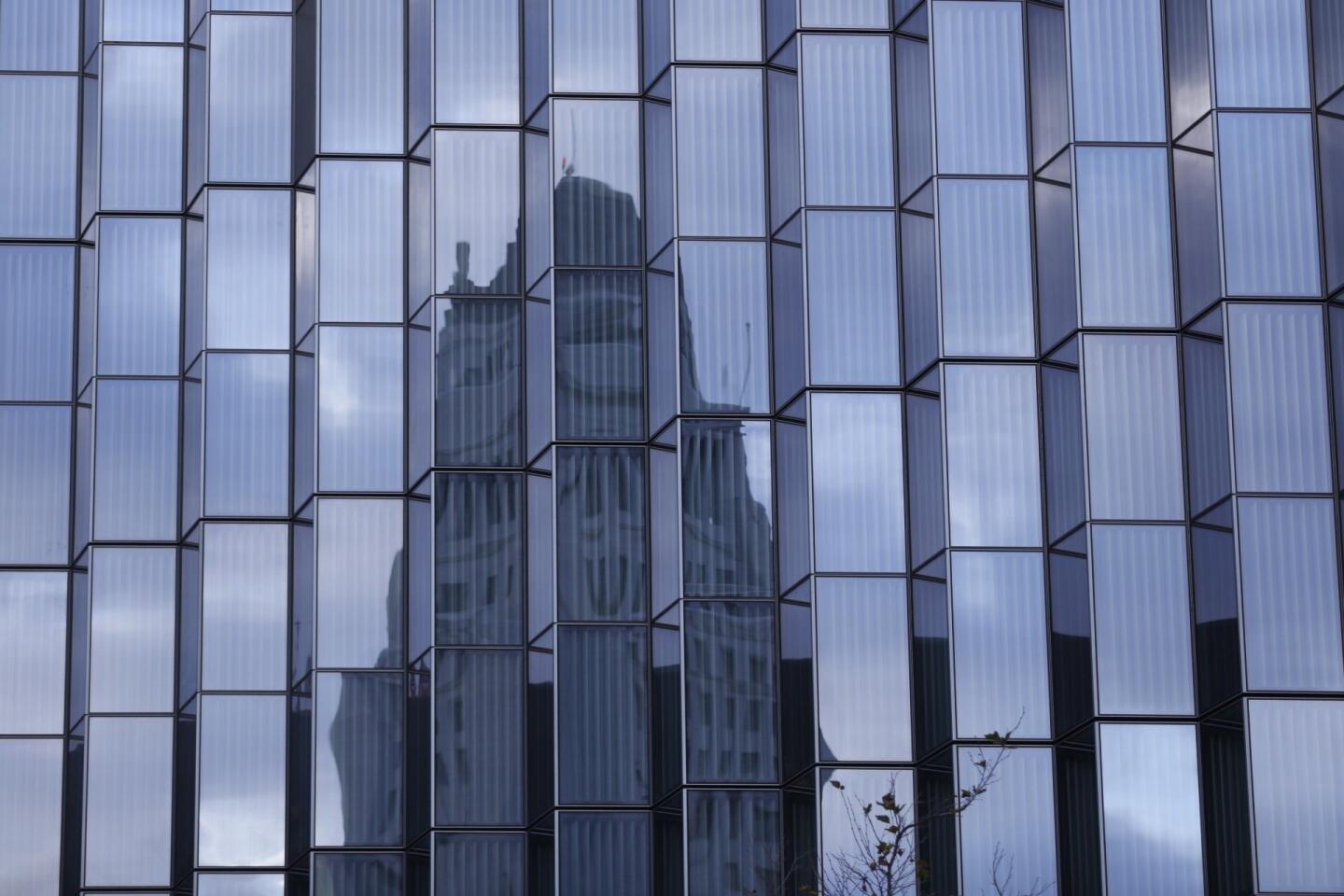
Los Angeles City Hall is surrounded by cloudy skies in a reflection in the windows of the new U.S. Courthouse under construction on Jan. 4.
(Al Seib / Los Angeles Times)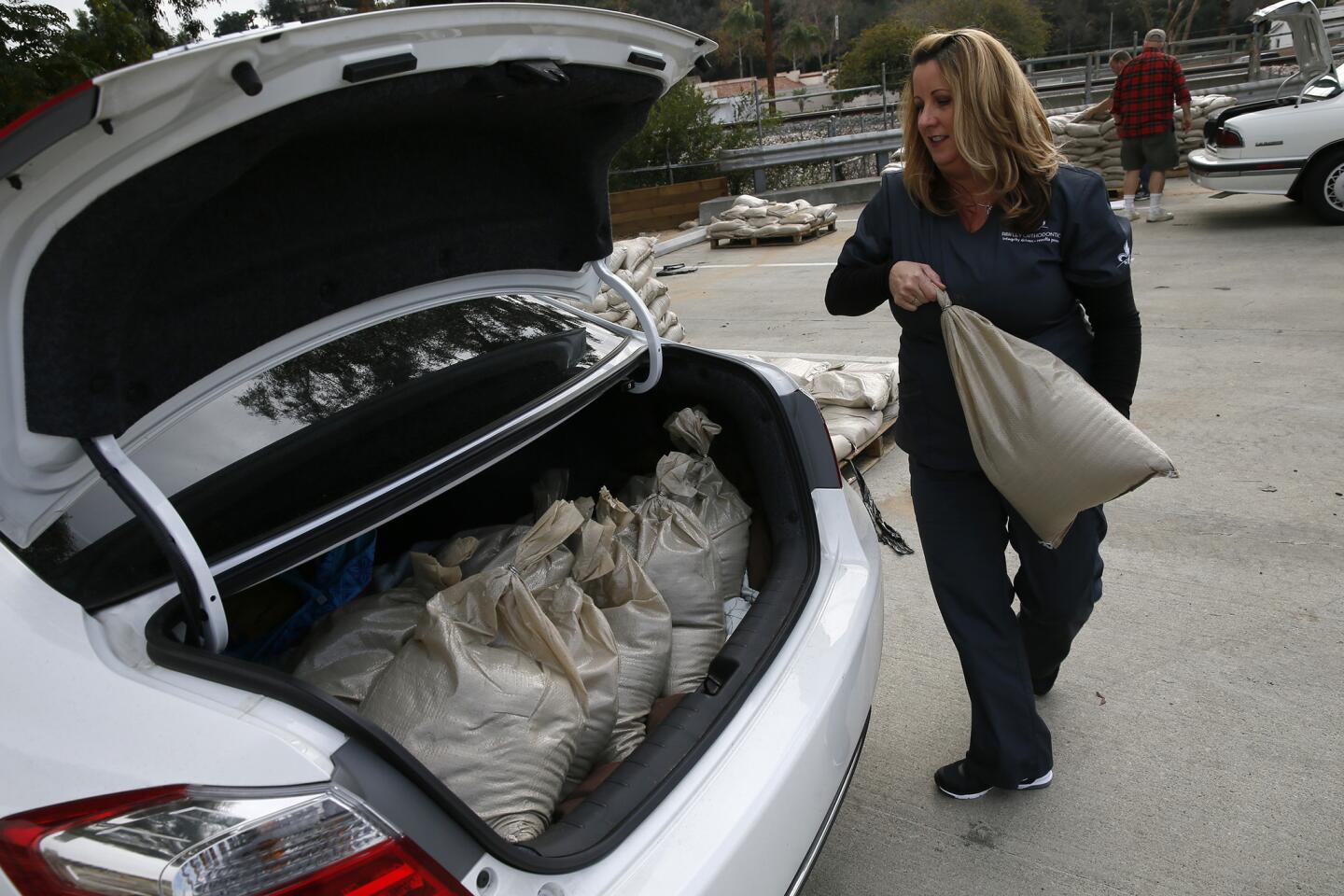
Karin Mitchell loads sandbags into the trunk of her car in Glendora, where residents were preparing for possible heavy rains.
(Robert Gauthier / Los Angeles Times)
Four-month-old Kwasi Youngblood is carried by his mother, Darchelle Youngblood, in downtown Los Angeles on Jan. 4. Youngblood said she is ready for the cold and wet weather predicted for Southern California.
(Al Seib / Los Angeles Times)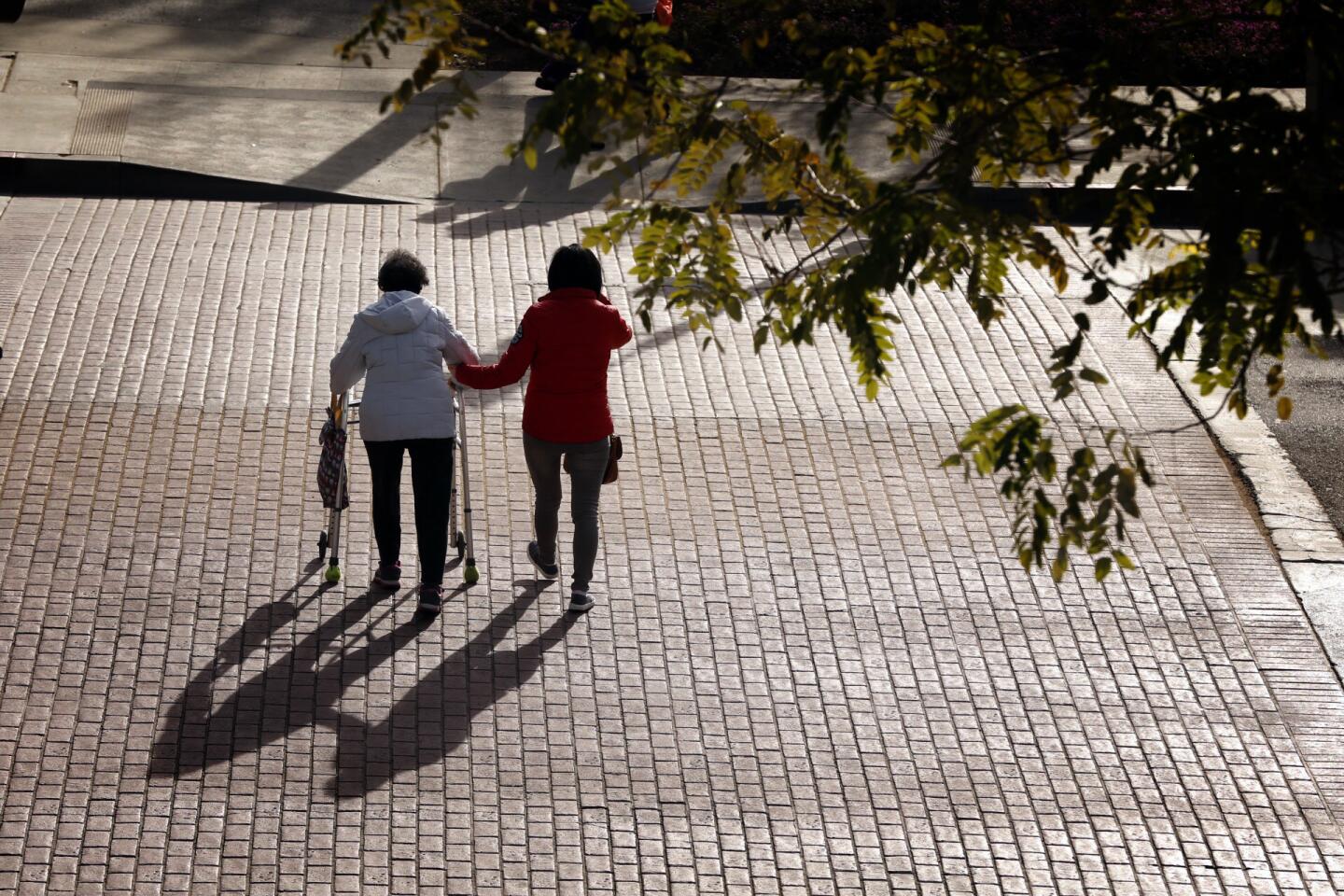
Two women enjoy some sunshine in downtown Los Angeles on Jan. 4, before wet weather is set to arrive later in the week.
(Al Seib / Los Angeles Times)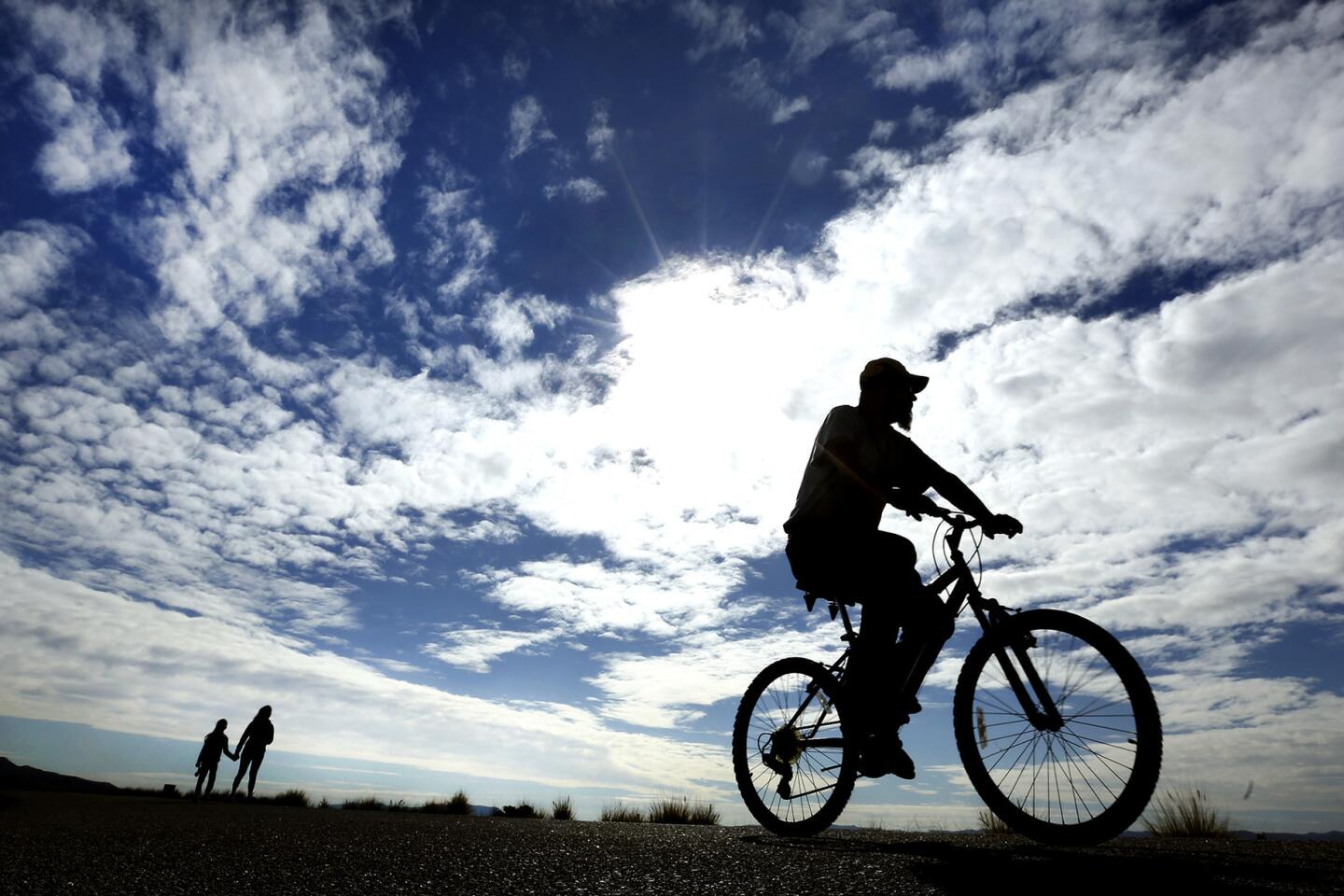
Antonio Dominguez, 44, of Pacoima, goes for a bike ride under partly cloudy skies above Hansen Dam in Lake View Terrace on Jan. 4.
(Mel Melcon / Los Angeles Timesl)How can I protect my home?
Here are some general tips from L.A. County:
--Never underestimate the power of flows of debris.
--Try to direct debris flows away from structures by using materials such as sandbags, sand or lumber.
--Avoid trying to confine the flow more than is absolutely required. Always use protection to deflect debris, but do not dam or stop it.
--Debris will often enter a building through windows. Board them up during a flow.
--Protect your most valuable property -- your home -- first. Then consider what time and money are available to protect less valuable objects such as swimming pools or plantings. Be prepared to sacrifice the use of portions of your property to achieve good protection.
MORE ON EL NIÑO
New El Niño storm slams into Southern California; mud flows onto 101 Freeway
Incoming El Niño storm brings risk of tornado and dime-sized hail
Tornado touches down in Vernon, damages buildings as El Niño storm pounds state
Sign up for Essential California
The most important California stories and recommendations in your inbox every morning.
You may occasionally receive promotional content from the Los Angeles Times.
Joseph Serna is a deputy editor on the Fast Break team at the Los Angeles Times and helps oversee daily breaking news coverage.
Taylor Goldenstein is a former reporter with the Los Angeles Times Data Desk. She has previously written for the Chicago Tribune, Tampa Bay Times and the Arizona Republic, among other publications. In early 2014, she was a visiting fellow at the Nieman Foundation for Journalism at Harvard. Originally from a suburb of Chicago and a graduate of the University of Illinois Urbana-Champaign, she now looks forward to checking weather apps. She left The Times in 2016.
Rosanna Xia is an environment reporter for the Los Angeles Times, where she specializes in stories about the coast and ocean. She was a Pulitzer Prize finalist in 2020 for explanatory reporting, and her award-winning book, “California Against the Sea,” has been praised as a poetic and mind-expanding exploration of what we stand to lose in the face of rising water.
